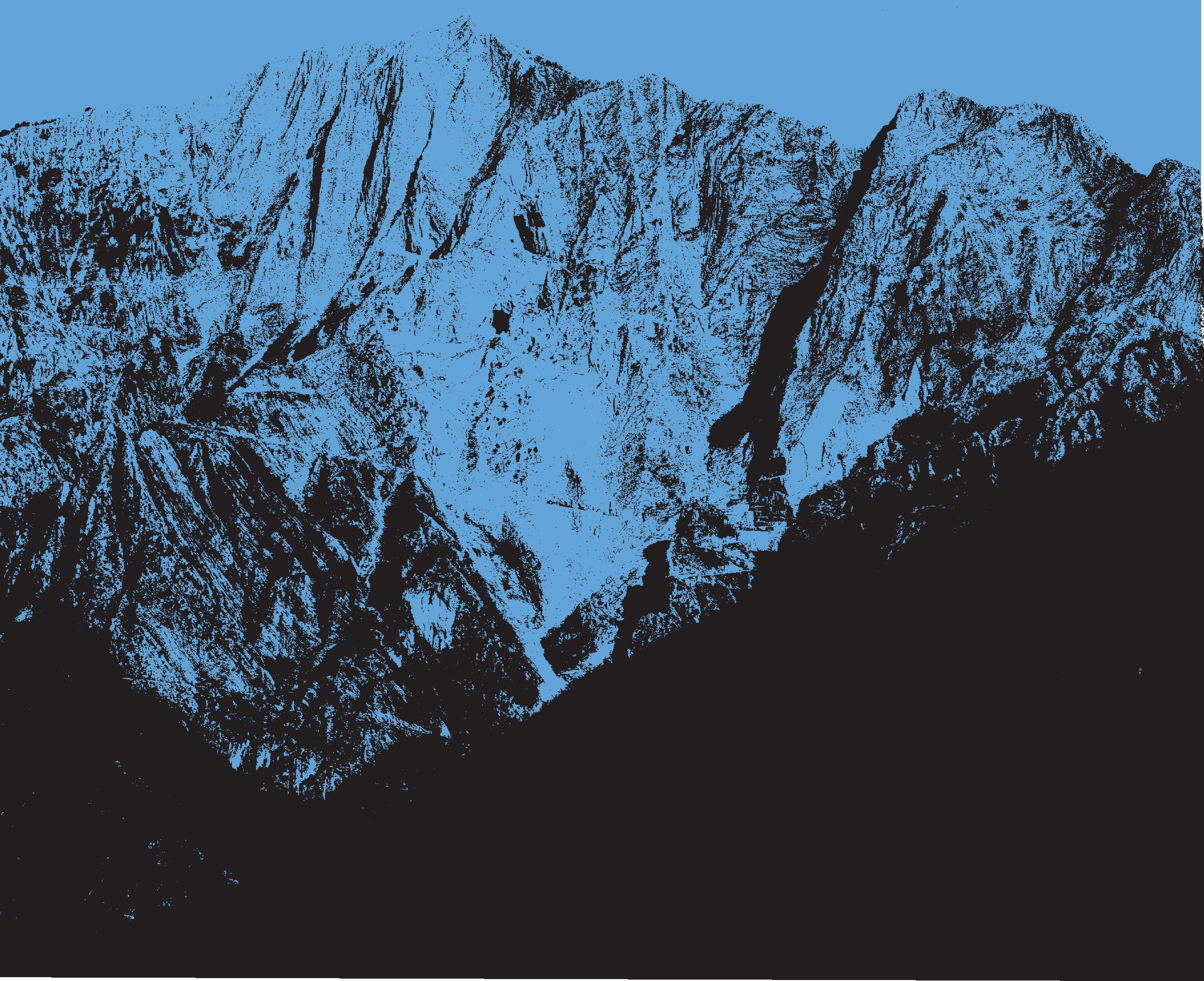

AC H ITECT UE DESIG NA T RR R
For Franco and Filippo
MARMO
Annual Magazine Issue no. 10, 2021 October
Editor in chief
Paolo Carli
Editor

Costantino Paolicchi
Deputy Editor
Aldo Colonetti
Editorial Coordinator
Eleonora Caracciolo di Torchiarolo Coordinator
Manuela Della Ducata
Editorial Staff
Eleonora Caracciolo di Torchiarolo, Nicola Gnesi
Graphic
Silvia Cucurnia, Thetis
Editor Henraux SpA
Printers
Grafiche G7 sas, Genova
Contributors
Cecilia Alemani, Roberto Bernabò, Chiara Bevilacqua, Jean Blanchaert, Edoardo Bonaspetti, Pickard Chilton, Lara Conte, Andrea Corradini, Turan Duda, Giacomo Faedo, Valentina Fogher, Rosi Fontana, Pierattelli Architetture, Bruna Roccasalva, Andrea Tenerini
Translations
Romina Bicicchi, Daniel Olmos
Photographers
Fogher Archive, Henraux Archive, Studio Tommasi Archive, Nick Ash, Ilario Bessi, Neri Casamonti, Stefano De Franceschi, Veronica Gaido, Nicola Gnesi, Giovanni Umicini
Cover Nicola Gnesi
“Printed under the auspices of Henraux SpA”
Registration no 3/2017 - 24/02/2017 of the “Registro stampa Tribunale di Lucca”
Paolo Carli
THE HENRAUX FOUNDATION. BETWEEN TRADITION AND EXPERIMENTATION, A POSSIBLE DIALOGUE
Edoardo Bonaspetti
PAOLO CARLI’S HENRAUX. BEAUTY AS A MODEL OF DESIGN
Aldo Colonetti
HENRAUX IN THE INTERNATIONAL ART SCENE. A STORY IN THE TELLING
Lara Conte
THE USE OF MARBLE FROM ALTISSIMO IN SCULPTURE FROM 1821 TO THE BEGINNING OF THE TWENTIETH CENTURY
Andrea Tenerini
HENRAUX SINCE 1821. THE GENESIS OF A GREAT ITALIAN COMPANY
Costantino Paolicchi FROM ARCHITECTURE TO ART AND BACK
Turan Duda
THE MORAL OF THE STORY ACCORDING TO NEÏL BELOUFA
Edoardo Bonaspetti
65 86 AC H ITECT UE DESIG NA T RR R
PHILIPPE, MARBLE AND THE HENRAUX PRIZE
VILLA IL GIOIELLO: THE RESTORATION OF A HISTORIC VILLA IN FLORENCE, BETWEEN REFINED ATMOSPHERES AND ANCIENT INTIMATIONS
Pierattelli Architetture
10 7
40 54
20 30
EDITORIAL
Jean Blanchaert 76 92
TO SCULPT. NEW TECHNOLOGIES FOR STONE SCULPTURE IN APUO-VERSILIAN WORKSHOPS
Valentina Fogher
MICHELUCCI, MARBLE AND DYNAMIC SPACE
Chiara Bevilacqua
STONE SELECTION AND APPLICATION IN THE DESIGN OF “300 COLORADO”, AUSTIN, TEXAS
Pickard Chilton
PHOTOGRAPHY AS A LANGUAGE OF VISION AND A SENTIMENT OF TIME
Costantino Paolicchi
ORGANIC FORMS, MARBLE AND METAL. HANNAH LEVY’S SCULPTURE IN NEW YORK
Cecilia Alemani
REDISCOVER MARBLE IN THE PRIVATE SPACE
Aldo Colonetti
LEONE TOMMASI. FAMILY ART
Roberto Bernabò
NAIRY BAGHRAMIAN. MISFITS
Bruna Roccasalva
BULLETIN
104 122 136 112 177 128 168 144 152
BY PAOLO CARLI PRESIDENT OF HENRAUX SPA AND HENRAUX FOUNDATION
This year’s 17th Venice Architecture Biennale has the title “How Will We Live Together”? This is the crucial question of our times, and it is with inexhaustible amazement that I see how, once again, it is the creative community who suggest the most acute reading of the present and show us a path to the future.
After living through the emergency last year, and through all the impossibilities of having the time and interior space to reach an overall reflection on what was happening, this year, in spite of ourselves, we have learned to coexist with a health crisis that continues, but with a minimum distance that allows us to make some considerations.
In light of the issues that are at the centre of our daily conversations with colleagues, neighbours, on social networks, which lead us to ask ourselves whether to consider our unquestionable freedoms, individual rights and duties, or the common needs of a community as a priority, whether to be individuals or communities, “How will we live together?” is indeed the question.
In making issue number 10 of Marmo I have realized that – perhaps unconsciously –Henraux gives the answer, which is nothing else than – simply, but not trivially – the synthesis of its work done so far. For two hundred years. Furthermore, I will also talk about this important milestone presently.
Henraux finds its strength – its answer – in the community. It finds vitality in the work, in the effort, in the thought and in the shared energies of hundreds of men and women who have followed one another within its walls over
two centuries and who have contributed, each with their own strengths – and with their own weaknesses, too – to make Henraux what it is today.
I arrive at this idea following a story that emerges not so much from the texts, which I will shortly go to mention, but from the images in this issue: historical, archival, black and white photos alternate, a little worn by time, to very recent photos, sharp, coloured, aesthetically the opposite to the previous images. In their heterogeneity, one element unites them: people. Whether they are photographs from the past or the present, they tell only one story: Henraux is made up of people who work. Together. The stories narrated by the images are accompanied by the words of our collaborators, which reinforce this idea of cohesive collectivity that emerges from the iconographic corpus. In anticipation of them, I would like to start with the contributions dedicated to Philippe Daverio and Giovanni Umicini, who recently passed away. They are homages (the first written by Philippe’s friend and companion of many adventures, Jean Blanchaert, the second by our director Costantino Paolicchi – full of vitality, sensitivity, melancholy – of course –but also irony) which restore to both, a profile that it is up to them, rich in shades and light and shadows. In humanity.
The column “The masters of Henraux”, inaugurated in the last issue, gives us the portrait of an artist who was the forefather of the history of contemporary art in Versilia: Leone Tommasi. His niece, Ilaria Tommasi spoke about it with Roberto Bernabò.
7
The tribute to the recent history of the company, which is above all a history of encounters to which these portraits testify, gives way to an in-depth study of today’s projects and to reflections on the present linked to the themes that are dear to us: art, design and architecture. The articles dedicated to the projects carried out by the Henraux Foundation in the last year, follow one another: one with the FrancoAlgerian artist Neïl Beloufa for Apple Piazza Liberty in Milan, one with Nairy Baghramian for the “Misfits” exhibition at the GAM –Gallery of Modern Art of Milan and, finally, the sculpture by Hannah Levy that Henraux produced for the High Line in New York. All curated by the writers: Edoardo Bonaspetti, Bruna Roccasalva and Cecilia Alemani.
In the field of architecture, we can find a splendid examination of the project for the Church of San Giovanni Battista “dell’Autostrada” by Giovanni Michelucci, penned by Chiara Bevilacqua alternating with the story of the most recent achievements to which the company has contributed its materials and know-how: the project in Washington DC with the Duda | Paine Architects studio and also in Austin, Texas, with the Pickard Chilton studio.
In the scope of design, one piece above all: Aldo Colonetti’s illuminating reflection on the multiple and new meanings that marble assumes in light of the new way of life that the pandemic has imposed on us and that the world of design simply cannot ignore.
A very special section, which will remain unique in the history of the company, enriches the current issue of “Marmo”: is dedicated to the celebration of Henraux’s 200th anniversary. Henraux was founded in 1821.
In the whirlwind of emotions through which we look at this achievement – one which we can only partially celebrate given the times we are in – we have tried to line up the salient events that have characterized the path, in a backward journey that dates back from more recent times to the origins.
And so we begin with a contribution by artistic director of the Henraux Foundation, Edoardo Bonaspetti, who shares with the readers the vision that characterizes his work and which allows us to glimpse the frontiers he intends to reach in the near future.
Following that, in my conversation with Aldo Colonetti, I wanted to clarify the approach that characterizes my leadership of the company: an approach that as a priority, aimed to interpret its glorious history to be able to draw the best guidelines for the present and future. The Foundation, the International Sculpture Prize, the return of the publication “Marmo”, as well as all the technological innovations that have been introduced from an industrial point of view in recent years, all of these derive from that interpretation and are inscribed in my entrepreneurial style that in an attempt to make “beauty” from a design model.
From the story of Erminio Cidonio’s work –of his vision, of the renovations he made, of the crucial moment that he represented for the company – expressed to us with abundance by Lara Conte, we arrive at Andrea Tenerini’s research on the artistic personalities who from 1821 to the beginning of the twentieth century collaborated with Henraux, making use of its marbles and its workers. Starting with Giovanni Grazzini and Francesco Pozzi, passing through the Americans Horatio Greenough and Hiram Powers and reaching Auguste Rodin, the wealth of knowledge and experience brought by the experiences is very rich indeed.
From Costantino Paolicchi’s piece, we finally get to know the genesis of the company: the steps that led to its foundation and its evolution under its corporate profile until the advent of the “Cidonio era” in the Second World War. And the future? “How Will We Live Together?”. For us at Henraux, the question posed by the curator of the Architecture Biennale Hashim Sarkis also contains the answer: How Will We Live? Together.
8
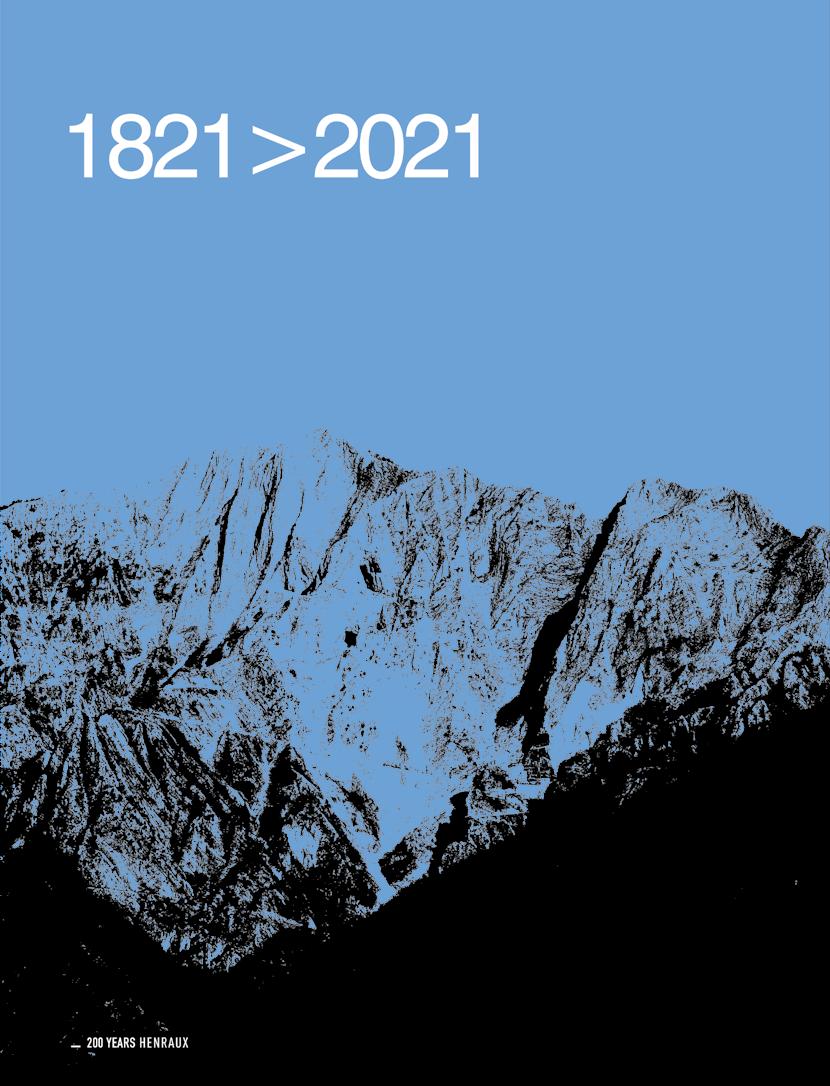

1821>2021
Diego Marcon, Ludwig, 2018
THE HENRAUX FOUNDATION. BETWEEN TRADITION AND EXPERIMENTATION, A POSSIBLE DIALOGUE
 BY EDOARDO BONASPETTI PHOTOS BY NICOLA GNESI
BY EDOARDO BONASPETTI PHOTOS BY NICOLA GNESI
It was a short step for Edoardo Bonaspetti from meeting the charismatic figure of Paolo Carli to accepting the role of artistic director of the Foundation. From the stories of the most recent projects, the vision of his direction emerges clearly, in a balance between history to be preserved and a future under the banner of experimentation.
11 1821>2021
I first met Paolo Carli, president of Henraux Spa, in the spring of 2018 at the Milan Triennale. In those weeks I had inaugurated an exhibition at the institution and a mutual friend decided to introduce us, anticipating how his charisma and energy could give shape to interesting collaborations. The Triennale itself was evidence of this: recently, an imposing marble sculpture by Emilio Isgrò which Carli had produced in the company’s historic factories in Querceta, in Alta Versilia, was placed in the park in front of it. Its title, “ll seme dell’Altissimo” (“The seed of Altissimo”), refers to the mountain from which Henraux has extracted the precious material since the beginning of the nineteenth century and the seed –understood as the seed of art, a symbol of creative potential – suggests what life can offer and how, in some cases, it can surprise us in its evolution. On that occasion, I learned that the quarries had been discovered in the sixteenth century by Michelangelo Buonarroti for the commission of the facade of the church of San Lorenzo in Florence, that the company was founded in 1821 and that over the course of almost two centuries of activity, its history affected the architecture and artistic production of a vast international panorama. Paolo Carli told me about his projects to enhance the culture of marble and the legacy of Henraux, and how in 2011 he was committed to setting up a Foundation with the task of recovering both its vocation and innovative spirit in the various fields of visual arts, design and architecture. The reference model was the enlightened direction of Erminio Cidonio, director of the company during the nineteen fifties and sixties, who managed to create an international sculpture centre in Querceta, with the presence of artists of the calibre of Henry Moore, Hans Arp, Henri Georges Adam, Isamu Noguchi, François Stahly, Émile Gilioli, Georges Vantongerloo alongside many others, who gave life to an artistic and cultural season of great vitality.
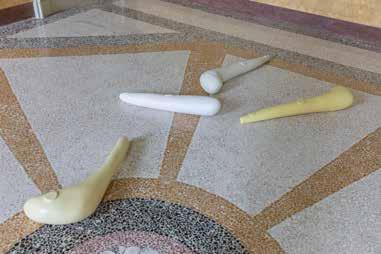
The first initiative of the newly founded Henraux Foundation was the “VolareArte” event at the main airport
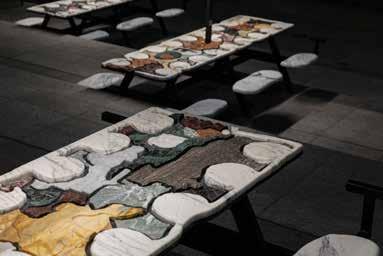
12 1821>2021
Above, Neïl Beloufa, The Moral of the Story, 2021, Milan, Apple Piazza Liberty, installation view
Nairy Baghramian, Misfits, 2021, GAM - Galleria d’Arte Moderna, Milan, installation view
Right, the artists Anto Milotta and Zlatolin Donchev at work in the Henraux workshop

13 1821>2021
We agreed that the new course should move along two guiding lines: on the one hand, to carry out ambitious exhibition projects in Italy and abroad and on the other to formulate collaborations with institutions, museums and artists in support of marble productions.
of the region, the Galileo Galilei airport in Pisa. The initiative, created in collaboration with SAT, the Tuscan Airport Company, offered arriving and departing travellers the opportunity to appreciate a series of site-specific sculptures and projects, presented every two years. In 2012 Carli also established the International Sculpture Prize, together with Philippe Daverio and Jean Blanchaert, it was the first in the world entirely dedicated to marble. The project, which continues to this day, is aimed at artists under the age of 45 and at the creation of works that combine ancient manufacturing traditions with the needs and vocations of contemporary art. Participants have the opportunity to confront the unique production reality of Henraux that combines high technology with centuries-old techniques, following all the stages of processing that transform the noble material into the finished product.
The exploration of the properties and limits of marble, linked to areas of innovative creation and thinking, benefits the company itself, which then has the opportunity to test applications, models and skills in a process of virtuous contamination. Paolo Carli pointed out to me how tradition and experimentation should converge and how this vision found its shape the same year via the monumental installation by Mimmo Paladino for the Santa Croce square in Florence. For the occasion, Henraux created a monumental cross of about
80x50 meters by placing more than fifty marble blocks of different sizes, shapes and colours in front of the Franciscan basilica, helping to transform the famous square into a place for participation, spirituality and art.
The conversation with Carli was engaging, there was a harmony of vision and we decided in no time to start working together on the new edition of the Prize that was due to be held in a few weeks and of which I would be president of the jury. The winners were Francesco Arena, David Horvitz and Diego Marcon. It was particularly gratifying for us to collaborate with artists who had never dealt with marble and who, thanks to digital control technologies, were able to push their research into new territories.
My professional partnership with the company was confirmed the following year when I was asked to take over the artistic direction of the Foundation. We agreed that the new course should move along two guiding lines: on the one hand, to carry out ambitious exhibition projects in Italy and abroad and on the other to formulate collaborations with institutions, museums and artists in support of marble productions, an excellent material of great statuary. The goals were to promote knowledge, to make our contribution to relevant cultural issues and to feed a network of virtuous relationships within the international art system.
The first project, a collaboration with
14 1821>2021
Mimmo Paladino, La grande croce, 2012, Florence Photo by Veronica Gaido

1821>2021

1821>2021
Jenny Holzer, With You, 2019 bench in Versilys marble

1821>2021

1821>2021
These collaborations and projects are often followed by acquisitions of works that enrich the Henraux Collection, which, from next year, will be accessible to the public for the occasion of the opening of an exhibition space at the Querceta factories.
the American artist Jenny Holzer on the occasion of her personal exhibition at the GAMeC in Bergamo. The work was composed of nine Versilys gray marble benches arranged in a circle in the penumbra of the Sala delle Capriate in the Palazzo Della Ragione. On each bench thoughts and verses about belonging or exclusion, by female poets and writers who dealt with gender identity issues were engraved.
A collaboration followed with Canadian artist Jon Rafman – recognized for his thrilling research on technology, digital media and their impacts on society and contemporary life – with which the Foundation created “New Age Demanded (Prince Arthur)”, a project composed of two large sculptures in Bianco Canal Grande e Bianco Macchietta marble which were permanently installed in the city center of Montreal.
The understanding of how important it was to bring more and more people closer to contemporary artistic practices prompted us to support the production of a provocative installation by the young American artist Hannah Levy, inaugurated this year in the elevated park of New York’s High Line. At the same time, in Milan, we worked with the Iranian-born artist Nairy Baghramian and the Furla Foundation
on “Misfits”, an exhibition curated by Bruna Roccasalva at GAM – Galleria d’Arte Moderna which addresses the idea of play as an educational device concerning the aesthetic experiences of inadequacy and imperfection. Also in Milan, I was able to curate “The Moral of the Story” by the Franco-Algerian artist Neïl Beloufa at the Apple Piazza Liberty amphitheatre. The public installation consists of four stations decorated with bas-reliefs and inlays of polychrome marble depicting the chapters of a fable written by the artist for his daughter. The outcome is an open, participatory space where social issues are intertwined with themes of representation between reality and fiction.
These collaborations and projects are often followed by the acquisitions of works that enrich the Henraux Collection, which, starting from next year, will be accessible to the public for the occasion of the opening of an exhibition space at the Querceta factories. The space will host historical and contemporary works, as well as the archive and a program of temporary exhibitions; the Foundation will reassert itself as an experimentation centre for contemporary sculpture which will support artists and bring together ideas, tradition and innovation: in short, the whole of Henraux’s past and future.
19 1821>2021
David Horvitz, A Sea, a Mountain, 2018
PAOLO CARLI’S HENRAUX. BEAUTY AS A MODEL OF DESIGN
BY ALDO COLONETTI
The concept of returning a culture of beauty to the world is a common thread that links the work of Paolo Carli, president of Henraux since 2003, in continuity with the figure of Erminio Cidonio. This is how the Foundation, the International Sculpture Prize and countless other activities that restore value to the industrial and cultural heritage of Henraux were born. In a conversation with our deputy director, the president explains.
20 1821>2021
Paolo Carli with Tony Cragg at Cervaiole Quarry
Photo Henraux Archive

1821>2021

22 1821>2021
“Volarearte”, 2015. Park Eun Sun’s works at Pisa airport
Photo Nicola Gnesi
Aldo Colonetti: Why do you think it is strategic for a company with a history spanning two hundred years to have a Foundation? When did the idea of organizing it arise?
Paolo Carli: It all began with a research of Henraux’s history. When I joined the company in 2003, I wanted to understand it by reading documents from the past, especially from the 1960s, concerning Erminio Cidonio’s vision for this company and its territory. Mostly, it was important to understand what he represented when he arrived in Versilia in 1957. Cidonio, upon his arrival, faced decades of history that described an industrial, economic and even social path. Reinterpreting a period, that of Cidonio, for me, was an act of foresight and a great interpretative effort towards an industrialist, but not only that, because I believe that Cidonio did not see himself only as a company man. The industry developed later, here as well as throughout Italy. Just think of figures like Olivetti, Piaggio: the project was industrial and cultural because “beauty” is not just a category of the spirit, but represents a design model that is the foundation of all our “Made in Italy”. Going back to that period, rereading that story, meant for me to put this particular sensibilty back on its feet. Art is a path that Henraux has within itself: from 1821 to today, the history of the company has always been linked with art, as large orders came from there. Once the “architects” were artists, the artist was the one who brought you the large order. Today this large order is brought to you by the architect or the designer, and art is something that makes you grow and develop memory, it is fundamental more today than yesterday from the point of view of “doing”. I was a young entrepreneur faced with an important industrial history, a company that owns important quarries, a proprietary mining business, a great brand that was about to celebrate its two bicentennial. I wondered how to reinterpret this industrial philosophy and by reading the stories of Henraux and Cidonio I realized that I had the solution under my nose: art, but not forgetting architecture and later design. Art is a challenge for us, art is creating
a unique piece; all my collaborators, from the project director to the manager who oversees the individual production activities, know that to enter into a dialogue with an artist means accepting a challenge. An artist’s piece is a unique piece, and is only finished when the artist tells you that he is satisfied with it. It is a challenge towards quality, its achievement, the tension towards perfection: thought and action, mind and hands. From history to contemporary art, the step was short and necessary, because we live in the present and above all we must always look towards a near, attainable future.
A.C.: In a company like Henraux, art is an activity in refining the processes and thoughts of the entire corporate work culture. As if to say that it is not just your choice, but it is a collective heritage that is present in the same production organization.
P.C.: I would summarise it like this: art is discipline. If you observe an artist, perhaps with an apparently disordered life, he is disciplined in his work, he is maniacal. An artist who wants to create a piece and arrive at a certain result is so obsessed with achieving the result that he loses sight of the practical aspects of everyday life. The most successful artist is, however, the most pragmatic, almost a “spokesperson” for himself; this is what this obsession is able to control a little; observing the making of art is a bit like analyzing ourselves, always suspended between what we are and what we would like to be.
A.C.: Once a project is completed, the work of art has been completed, I believe that all this experience collected inside the factory is transformed into extraordinary cultural capital. Basically, the reason and the need for the Foundation is born in this way.
P.C.: Exactly. Collaboration with an artistic dimension within a company like Henraux represents the heart, the value of everything we do. Today we face contemporary art, but the method is the same as in the 1960s when Henry Moore arrived at the factory: he had

23 1821>2021
faith in a craftsman, who was at his side, in his case Sauro Lorenzoni, who from a small maquette, we are talking about something no more than 10-15 cm, was able to develop a sketch that would then be represented, point by point, in a set of data, then transmitted not to the machine that was still not yet there, but to a compass which through the progressive multiplication of these points, allowed, through the skilled hands of our workers, the transition from sketch to monumental form.
A.C.: The passage from the compass to the machine is important because it indicates the relationship between the instrument and the work, however, at the center there is always a man, the artist.
P.C.: Certainly, it was the multiplication of the point by point of the compass, and what the artist saw in small dimensions, the craftsman transferred it into something large. The artist himself then came to refine the lines. Today, however, we make these forms through technology, robotics and digital controls, but the artist’s control is always present. For this reason, another very important structure has been created in the company, made up of young people who know how to read and reinterpret this special culture which is that of 3D design and development of a certain shape; certainly the machine, but always controlled by the watchful eye of the technician and the artist. Now the forms are more and more abstract, more and more expressive, a challenge towards the unattainable. What is difficult to do today? Achieving the extremization of a form through matter: you already know that there is a material that reaches a breaking point and that breaking point is the maximum capacity for expressive development.
A.C.: At this point it is very clear how you came to think of the Foundation as a strategic element of the company’s structure: it is not just an individual choice,
it represents a future that gathers the past, always paying attention to the present, because it is here that it is the pulse of an industrial activity can be measured.
P.C.: What are the reasons behind the Foundation? First of all, because when I joined the company I realized that many resources of the past had been lost, including Cidonio’s own collection. This is how Cidonio worked: I welcome you, I make you feel the marble, I make all my structure, the raw materials and all the rest available to you, but at least leave me something! And this something was a work of art: so he had created a unique collection of absolute beauty! Others are inventing such a thing today, while we do not have to invent anything: Henraux has a heritage of two hundred years that arises from a collaboration with the great art of the moment, starting from the nineteenth century, passing through the twentieth century and reaching up to the 2000s. The Foundation was necessary to give an institutional form to a single story. This meant that to form the foundation it needed an operational structure within it, whether it is one or two people who animate, feed and coordinate all the activities on a daily basis. Our events are now well known, starting with the International Sculpture Prize, which I truly wanted, thanks also to the collaboration with Philippe Daverio. All I did was revisit Cidonio’s experience, Daverio accompanied me, first discussing and then trying to dissuade me from this crazy idea of mine, then, given my stubbornness in carrying it out, exhausted, he said yes. And from there it all started: in 2012 the Prize. We brought young artists back to reinterpret marble, an extraordinary but very difficult to work with.
A.C.: The project is also a sign of the attention given by a private company towards its reference territory. In your opinion, has this plan towards the context, in such a way as to return what Henraux has received in 200 years from such an
Henraux has a heritage of two hundred years that arises from a collaboration with the great art of the moment, starting from the nineteenth century, passing through the twentieth century and reaching up to the 2000s. The Foundation was necessary to give an institutional form to a single story.
24 1821>2021
Above, robot working at the Henraux workshop
Photo by Nicola Gnesi
Below, Paolo Carli with a craftsman: the hand refining phase at the Henraux refining workshop
Photo by Nicola Gnesi
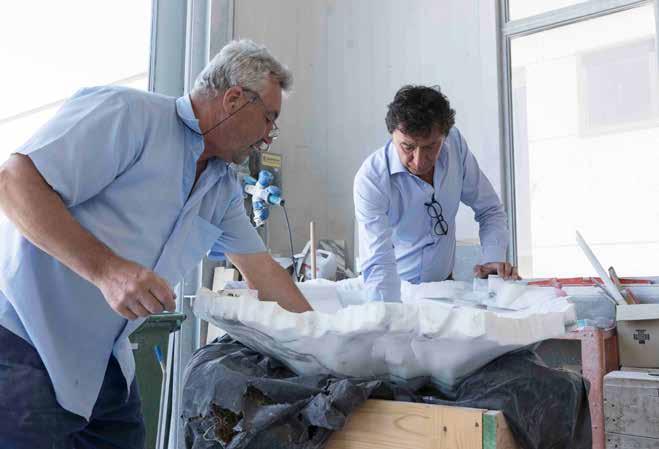
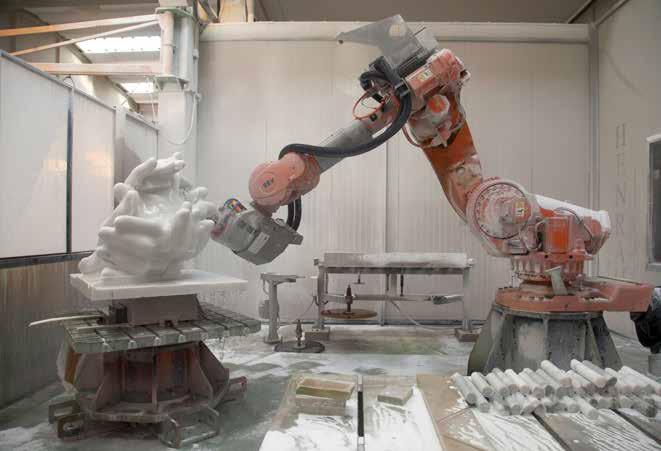
25 1821>2021
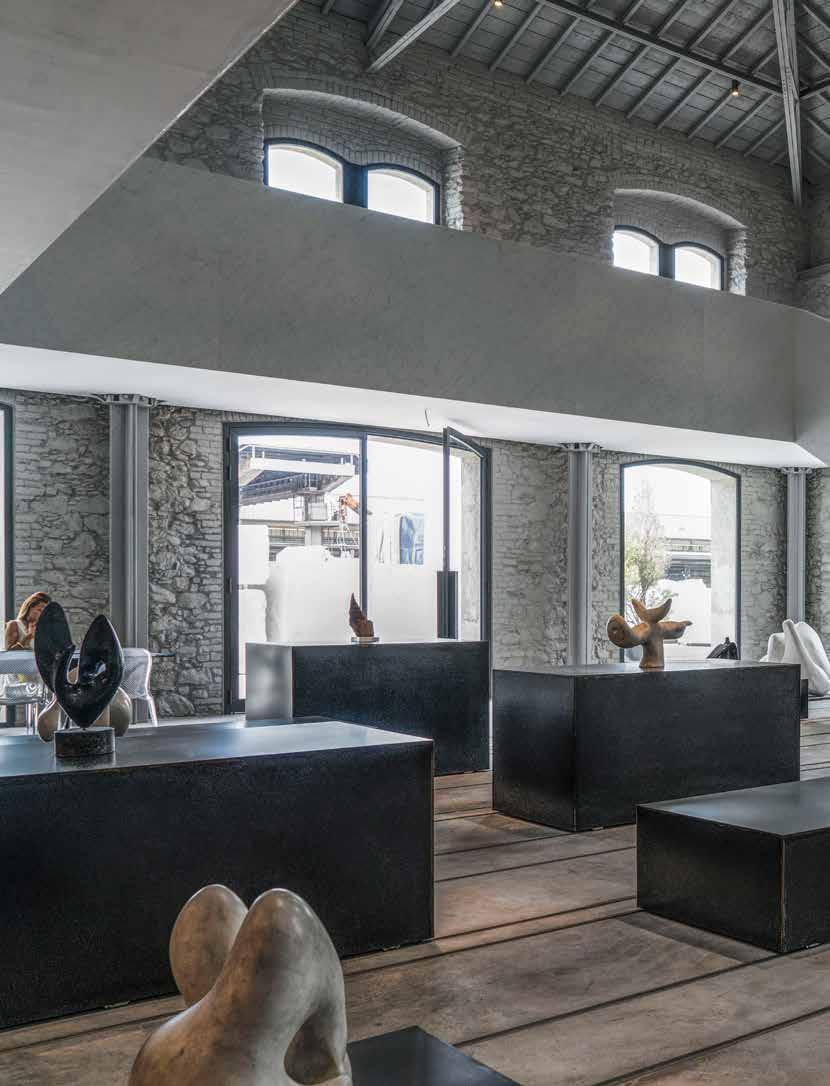
1821>2021
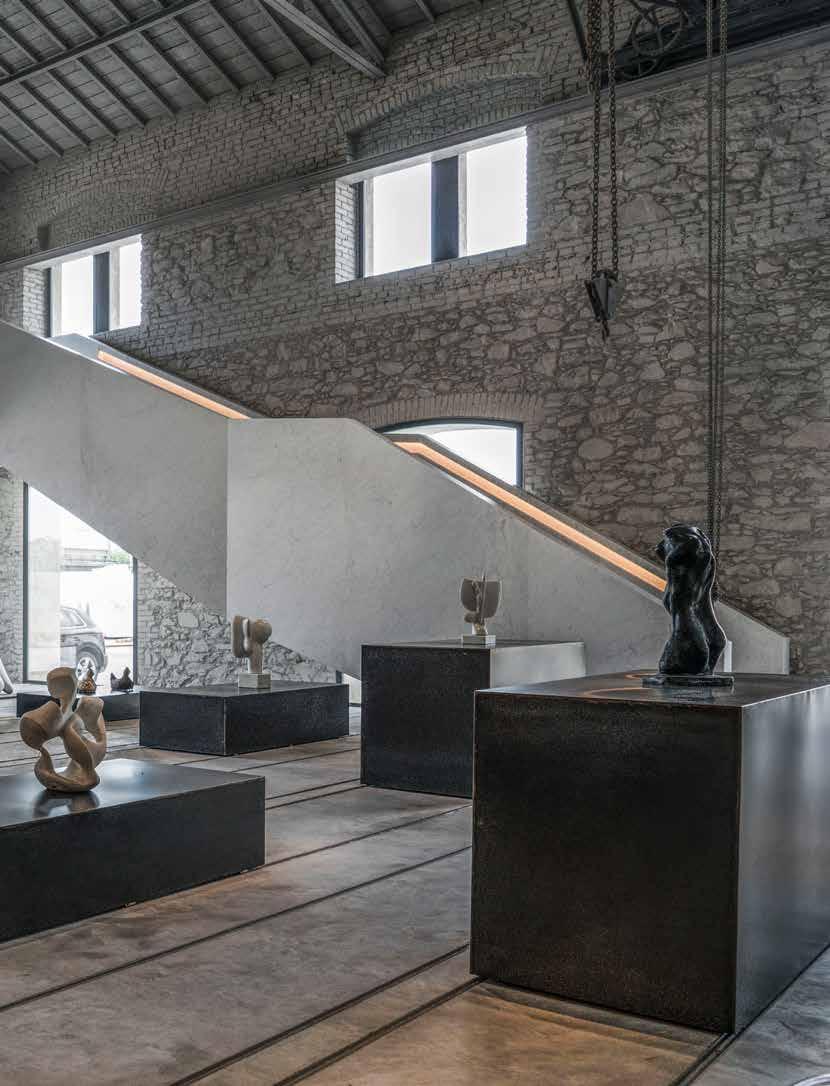
1821>2021
The site of the Henraux Foundation
Photo by Neri Casamonti
extraordinary and unique place, been understood?
P.C.: When I considered the Foundation, I immediately chose the path of a mixed system, something public and private: Henraux spa, the Municipality of Seravezza, the Municipality of Stazzema, the Municipality of Forte dei Marmi and the Province of Lucca, choosing strong local roots. Unfortunately, it was not fully understood. I always trust in a future, mainly in young talents, of which, as you can see, I make a lot of use, both in terms of new hires, some of which come from our extraordinary territory, and in relation to collaborations with designers, architects and artists. Henraux must pass on its story, it is an obligation that I have as an entrepreneur who has decided to undertake this great challenge but also as an “inhabitant” of a unique place in the world.
I made a commitment to pass this on to new generations, to pass it on for more than its two hundred years. Today we represent a company aimed at an international market. I believe that despite the current crisis, Henraux possesses such human energy, much superior to financial energy, that it allows us to look to the future with optimism.
A.C.: Your Foundation, by statute, does not produce profits directly, but indirectly constitutes an element of value that can be found in the production capacity, in selling to the world a unique material that is not only symbolic of a history but also of a territory that the whole world envies.
P.C.: If the company knows how to perform, it must do so off the artistic path; the artistic paths are those that enrich us, that nourish us, so it is clear and fundamental that this cultural heritage must be defended. I do everything I can do to defend a company with two hundred years of history; a large internal production with large vertical production chains. I would like to be a model, but I must also say that our commitment is not always recognized. We have a heavy and cumbersome bureaucratic system. We represent legality, I want to
say, like other companies. Henraux has certified financial statements for at least eight years, and therefore we represent true legality, not being protected or not being relieved of all this bureaucratic heaviness.
A.C.: Moving on to the bicentennial, a goal closely linked to everything we have mentioned.
P.C.: For me, the bicentennial is very important milestone. When I acquired the company nineteen years ago, 2021 was far, far away. We have arrived at an extremely sad and dramatic moment for the entire community, worldwide. I see great potential within this bicentennial; the company, despite the difficult times it had to overcome in 2020, has shown great resilience. We are facing a 2021 in which we will not be able to best express our history; we have decided to postpone the celebrations until next year, however we have already started this year with a series of projects, because 200 years only comes once in a lifetime.
I am very proud, because we work with great humility. We won’t have big celebrations. The first commitment is to put this large collection in order, in such a way as to connect past history with the activities carried out in recent years, highlighting an openness to the contemporary.
A.C.: Can we hope that in 2022 the State will be able to be present, to show with a symbolic gesture, which never remains only symbolic, the outset of another political, and above all ethical and cultural path?
P.C.: Let’s hope so. Meanwhile, we are working to make this happen. Everything I have done in these twenty years goes in that direction: the Prize, the Foundation, the presence on the territory through exhibitions, such as those organized in the airports of Pisa and Florence with the VolareArte event, the sculpture by Emilio Isgrò “The Seed of Altissimo” which was produced for EXPO 2015 and later placed in Milan in front of the Triennale headquarters, the republication of the
28 1821>2021
magazine “Marmo”, this year we have already reached number 10. Publishing a company magazine with this diligence represents a sign of continuity, as Cidonio had guessed: it was the first magazine that, going to the desks of the best international architects, represented marble as a product to be cultivated, understood and nurtured. With “Marmo” we want to give the “culture of beauty” back to the world.
A.C.: Marble a part for the whole; marble is synonymous with Henraux, and in
the imagination of the world, Italy has some elements that characterize it –design, fashion, food, art, architecture – and marble crosses them all because it belongs to nature and to culture in its highest expressions. One only needs to think of Michelangelo.
P.C.: In fact, the subtitle of “Marmo” is: Architecture Design Art, thus meaning an interpretation of forms and spaces in a broader sense, where these three disciplines interact with each other and intertwine, maintaining their own identity and then returning together.
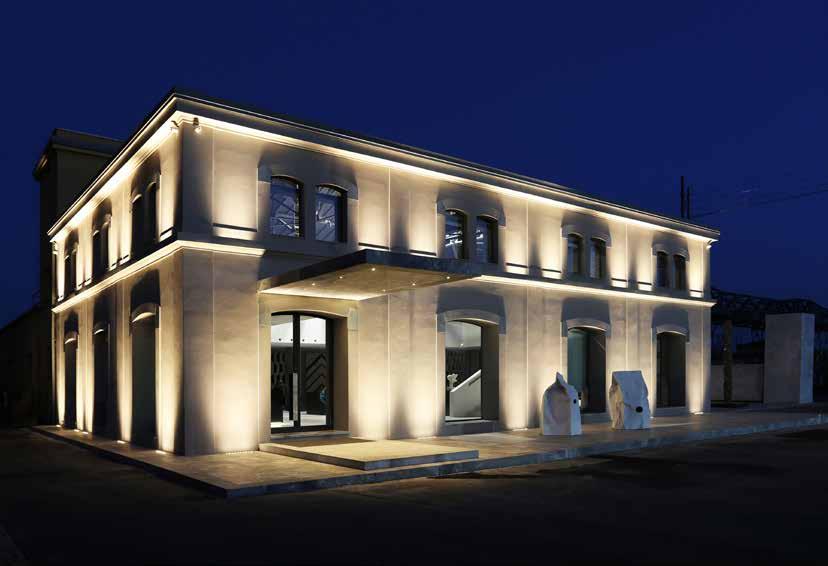
29
1821>2021
With “Marmo” we want to give the “culture of beauty” back to the world.
External view of the Henraux Foundation
Henry Moore at the Querceta establishment
HENRAUX IN THE INTERNATIONAL ART SCENE. A STORY IN THE TELLING
BY LARA CONTE PHOTOS FROM HENRAUX ARCHIVE
A time of utopia and research for Henraux has arrived with Erminio Cidonio, through the involvement of great sculptors and young artists and the promotion of contemporary sculpture, of which the establishment of the magazine “Marmo” itself constitutes a fundamental part. It is a project driven not by pragmatic intentions but by an authentically enlightened vision.
30 1821>2021

1821>2021
Leone Tommasi
Some crucial background
“I went to Querceta, near Forte dei Marmi, in Italy, for the Unesco sculpture. Querceta is a small village at the feet of the Carrara mountains. For me, Monte Altissimo is enormously exciting and fascinating. It is there that Michelangelo spent two years of his life extracting marble. The Henraux Company owns the Monte Altissimo and trades marble and stone all over the world”1.
This is how Henry Moore remembers his first encounter with Versilia; a meeting that marked the beginning of the artist’s collaboration with the Henraux company. The fortune and impact of Moore’s sculpture in Italy, consolidated by exhibitions and increasing attention in the specialist and popular press starting after the war, became even more apparent in the second half of the 1950s. It was in 1956 when, having obtained the prestigious commission for the creation of a large sculpture for the Unesco headquarters in Paris, Moore chose to create his “Reclining figure” in Roman travertine. Hence his decision to go directly to Versilia, where he could not only choose the material, but above all, he could benefit from the technical collaboration of skilled local artisans.
Moore frequently stayed in Querceta between 1957 and 1958, so much so that, as Davide Colombo and Giorgio Zanchetti recently highlighted, “monumental stone sculpture became for Moore ‘an activity inextricably linked to Italy for the rest of his life’”2
At first, local artisans found themselves unprepared to face dialogue with the forms of contemporary plastic art research. What must have generated amazement was the sculptor’s decision to use Roman travertine instead of white marble. The bemusement grew even more when Moore showed the local workers “a plaster model no larger than twenty centimetres, from which a statue of over four meters was to be made”3, this implied a revolution in traditional processing methods.
It was this “challenge”, so well received by the Henraux company and its collaborators, which played a decisive role in the fate of the historic company and for the future of the Versilia area tout court
Erminio Cidonio’s plan
Henry Moore’s presence at Henraux can therefore be considered as the background to an adventure that found shape during the 1960s, assuming an articulated physiognomy. This was thanks to the foresight of the then CEO of the company Erminio Cidonio4, who managed to give life, in just a few years, to a project promoting contemporary sculpture of great international resonance, involving established sculptors alongside young artists, intellectuals and professionals gravitating in the world of art, architecture, design and of restoration.
Erminio Cidonio realized that the way to give new vigour to the marble sector was precisely to promote the use of marble in the field of contemporary sculpture, architecture and mass production, involving great masters and young artists who attended the Henraux workshop, taking advantage of the collaboration of local artisans. It was only in this way that marble could return to the centre of contemporary debate, freeing itself from the heavy fascist legacy and from all the monumentalism identified with the ideology and image of the regime. According to the recollections of Pier Carlo Santini, Cidonio “was not happy to share the practical dress, the arid and calculating pragmatism of his colleagues [...]. His was a dissent illuminated by acute and precise intuitions, supported by his constant enthusiasm, aimed at the cultural and technological renewal of the environment in which he found himself operating. For Cidonio, doing research meant being passionate about any proposal or project that looked to the future, promoting initiatives that could not have immediate productive feedback, encouraging experimental methods and methods, giving great space to utopia”5
A utopia – Cidonio’s – which certainly drew inspiration from the most modern examples of industrial entrepreneurship aimed at combining production, social and cultural commitment, in that temporal curvature that extended from postwar reconstruction to the years of the economic miracle.
For the realization of his original project, the entrepreneur surrounded himself with
32 1821>2021
“For Cidonio, doing research meant being passionate about any proposal or project that looked to the future, promoting initiatives that could not have immediate productive feedback, encouraging experimental modes and methods, giving a great space to utopia”.
skilled collaborators and declined a more diversified plan, giving importance to the theoretical side and practical impact, to the international image and local identity. In this sense, the idea of founding a magazine as a receptacle of experiences and a place for theoretical elaboration seemed to be the first useful step in describing and disseminating the project. During 1962 Cidonio came into contact with the publisher Bruno Alfieri6, who accepted the job of editing “Marmo”, an international art and architecture magazine promoted by Henraux. From that moment on, he forged debate and a network of relationships that allowed other aspects of the project to bring fruit. Alfieri in turn proposed Pier Carlo Santini and Giuseppe Marchiori as collaborators and interlocutors of the project. The latter, together with the publisher, was promptly involved by Cidonio in the design of a sculpture seminar for young artists and in the organization of a contemporary sculpture museum to be set up in Querceta, at the Henraux7 The goal was precisely to bring together the most important personalities of international plastic art research in Versilia, making sure that through their works there remained a trace of their passage.
“Marmo” magazine
According to the agreements between Cidonio and Alfieri, the magazine “Marmo” was to publicise the projects carried out by the company alongside collected critical contributions on sculpture, architecture and design, in such a way as to “create an international, non-sectarian platform of modern culture, that looked towards the future”8. It would present “modern creations by artists, architects and designers, in any material, as long as they were screened through a filter of art and technical criticism”9. Marble is therefore the dominant, but not exclusive, theme of the publication.
Alfieri edited the first three issues, printed annually from 1962 to 1964; the direction of the fourth issue, which appeared in 1965, and of the fifth, which
came out – after an interruption of a few years – in 1971, was instead taken on by Pier Carlo Santini.
The first four issues collated reflections from art historians, critics and specialists from the many disciplines covered. As far as sculpture was concerned, the diligent presence of Giuseppe Marchiori should be noted, who wrote in-depth essays on the great sculptors who, with thanks to him, arrived at Henraux. In addition to the already consolidated presence of Henry Moore, which he recounted over the years, the contributions dedicated to Hans Arp and Henri Georges Adam10 should be noted. Excerpts from a diary, projects and sketches by Le Corbusier, Giovanni Michelucci and Alvar Aalto enrich the pages dedicated to contemporary architecture11. Issues relating to archaeology, the history of architecture and restoration were addressed by Piero Sanpaolesi, Marco Dezzi Bardeschi, Brunetto Cartei, Licisco Magagnato and Pier Carlo Santini, who also edited the pages designated for design12.
Undoubtedly, the publication’s intentions were clarified by the second and third issues, pressed, respectively, in November 1963 and December 1964. They are made up of historical-critical contributions, of a column entirely dedicated to marble, entitled “Marmorama” and a “Henraux Bulletin”. This last section illustrated the projects conducted and completed by the company in that fruitful two-year period; projects ranging from architecture to restoration, from industrial design to contemporary sculpture. “Marble 2” presented a piece on the Cavalieri Hilton Hotel in Rome (whose design was taken up by Franco Albini, Franca Helg, Ignazio Gardella and Melchiorre Bega), in which Henraux marble was widely used in flooring and furnishings. An interview by Giuseppe Patané with Ugo Blätter, also published in the second issue of the magazine, documented the construction of the floor for the portico of San Pietro designed by Giacomo Manzù, whose work was conducted by the “Reconstruction and Sacred Art” department of Versilian society13. “Marmo 3” provided in-depth information on the reconstruction of the Abbey of Montecassino destroyed by
33 1821>2021

1821>2021
Henraux craftsmen pose the large pavement of the portico of San Pietro designed by Giacomo Manzù
the bombs of the Second World War, the largest restoration project in which Henraux collaborated and one which saw the company’s workers engaged for more than a decade14
The project of the Centre for contemporary sculpture
Starting from 1963, Cidonio’s project, aimed at creating a centre for contemporary sculpture in Querceta, took on a well-defined physiognomy, as was also testified by the magazine, in which the sculpture seminars organized by Alfieri and Marchiori were advertised. Seminars which were held in the summer months of 1963, 1964 and 1965, and the presence of the artists who, in those years, visited Henraux are also documented.

The young sculptors sent to the seminars had the opportunity to work with marble (each artist was provided with the material needed for their needs) and to benefit from the technical assistance of local workers. According to the provisions of the Regulations, the artworks created during the seminars would remain the property of the company and would form a collection of sculptures, subject to the opinion of the jury15. The intent was to “guide young sculptors into the terrain of professional maturity, in working with materials that only allow a direct and intimate conversation between the work and the artist, freed of any forced intellectualism”16. The artists chosen for the first edition were: Marisa Mauri, Silverio Riva, Paolo Icaro and Guido Pinzani; for the second: Fumio Otani and Antoine Poncet; and for the last: Juan Dries, Bruno Raspanti and Aldo Dezza. For some, that experience turned out to be a brief parenthesis within their creative paths that continued towards completely different experiments, for others it constituted the beginning of an assiduous collaboration with the company and a lasting frequentation of Versilia. This is the case, for example, of Antoine Poncet.
1964 was a crucial year for the development of the project linked to contemporary sculpture. In fact, in attendance were Henry Moore, Hans Arp,
Henri Georges Adam, Isamu Noguchi, François Stahly and Emile Gilioli. As Marchiori observes, “the interest in Henraux’s cultural initiatives, relating to the use of marble in the century of iron and autogenous welding, manifests itself in artists of very different, indeed often antithetical, backgrounds”17. Noguchi planned a rearrangement of the garden in which the first group of sculptures of the museum were to be set up and of which – according to Marchiori himself –there was already a lot of talk in the international world of the arts. During the summer, Arp visited Querceta to put the finishing touches to the “Paysage Bucolique”, the great sculpture with which the Versilian company chose to be represented at the Milan Fair in 1964. We read in “Marmo”: “Arp, wearing a white doctor’s coat, started to smooth a curve that seemed too accentuated to him with sandpaper and a very fine rasp. Arp almost caressed his sculpture and the raised white powder made the artist’s spiritual face appear more lunar than usual. White on white in a face, which takes on unexpected expressions of curiosity, detachment, irony, spiritual harmony, and sometimes even farcical buffoonery, like Dada”18
When Arp left for Meudon, François Stahly arrived at Henraux, who would later send a sketch to be translated into marble for the museum. Artworks by Alicia Penalba and Georges Vantongerloo, the historical founder of De Stijl, were also underway. The company’s expert workers, who had also recently finished Adam’s monument for Vincennes, carried out the marble transposition for the collection.
Henraux was becoming “a European sculptural workshop” 19. During the summer of 1965, the appearances of Antoine Poncet, Alicia Penalba, Emile Gilioli, Isamu Noguchi, Pietro Cascella and Henri Georges Adam were recorded.
“This is Adam who is finishing the great wall for the castle of Chantilly –reported Marchiori in “Marmo”– A wall made up of barely hewn elements, with deep incisions, of beautiful geometric
35 1821>2021
warping, intersecting lines, apparently random like graffiti. The boulders are of different colours and often almost natural shapes. They will be placed on a body of water”20. And it was precisely to the great Adam fountain for Chantilly Santini that he dedicated an in-depth essay – also published in “Marmo 4” – accompanied by splendid photographs by Ugo Mulas, in which he described the process of the plastic art realization of the monument, for the creation of which the sculptor had fully exploited the technological contribution of the Versilian company’s machinery, creating a perfect integration between the work of the artist, the workers and the machines21
After the summer of 1965, a period of intense change loomed for the Versilian company.
Financial problems arose concerning the project dedicated to contemporary sculpture, presumably linked to the publication of the magazine and the organization of seminars.

In August 1965, the publisher Bruno Alfieri ended his collaboration with the company. The direction of the fourth issue of “Marmo”, published in December 1965, was in fact taken over by Pier Carlo Santini.
In January 1966, Cidonio, who had already resigned from the posts of administrative director and technical director in May, decided to leave Henraux. The position of managing director was consequently taken by Giuseppe Formai.
Unfortunately, the publication of the magazine was suspended after Cidonio left Henraux22. This change of direction,
36
Erminio Cidonio with Hans Arp at work on a sculpture
Photo by Ilario Bessi
1821>2021
Right, Joan Miró, Oiseau solaire, 1968, white marble
The publication of the magazine was suspended after Cidonio left Henraux. This change of direction managed to ensure continuity for the sculpture museum project, thanks also to the collaboration of Giuseppe Marchiori.
however, managed to ensure continuity for the sculpture museum project, thanks also to the collaboration – albeit less assiduous than in previous years – of Giuseppe Marchiori. During the second half of the 1960s, internationally renowned artists, therefore, continued to frequent the Henraux workshop and sent works for the museum. A review of the correspondence preserved in the Company’s Historical Archive allows us to draw up a rather detailed list of the sculptures that, in those five years, were added to the collection, and also to define the methods of acquisition of the same: in some cases, the artists authorized
Collectable events and new perspectives
At the beginning of the seventies, Henraux’s adventure in the field of contemporary sculpture was about to come to an end. Two events set the chronological boundaries of that exciting season: the publication of the latest issue of “Marmo”, released in November 1971, after a few years’ silence, and the exhibition held in the Cortile d’Onore of Palazzo dei Diamanti in Ferrara in 197227, in which the sculptures of the Versilia collection could be appreciated in all their splendour. On that occasion, works
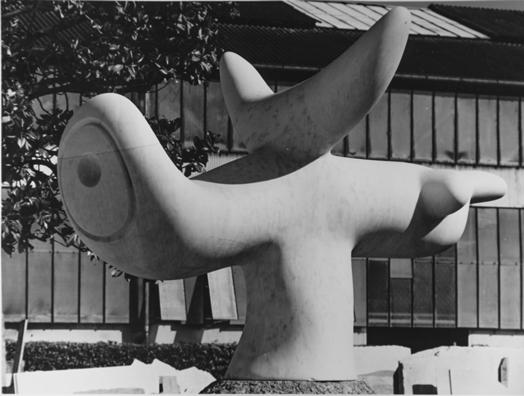
the execution of a copy of the work that was in progress at the laboratory; in other cases, they expressly donated their own plastic ideas, either free of charge or in exchange for the supply of materials. Among the sculptures gathered in the collection in those years, we can mention, “L’oiseau solaire” by Joan Miró23, “Unidades yunta” by Pablo Serrano24, “Rencontre dans l’espace” by Maurice Lipsi25 and “Ghibellina II” by Giò Pomodoro26
by Hans Arp, Giovanni Benvenuti, Carmelo Cappello, Pietro Cascella, Nino Cassani, Lynn Chadwick, Gaetano Di Martino, Joan Dries, Richard England, Agenore Fabri, Maurizio Giannotti, Rosalda Gilardi, Emile Gilioli, Gigi Guadagnucci, Maurice Lipsi, Juan Mirò, Luigi Mormorelli, Rosario Murabito, Isamu Noguchi, Maria Papa, Alicia Penalba, Giò Pomodoro, Antoine Poncet, James Ritchie, Branko Ruzic,
37 1821>2021
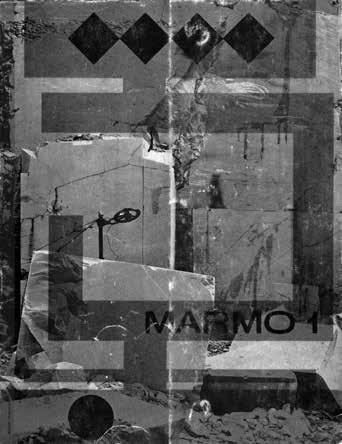
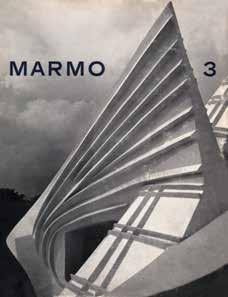


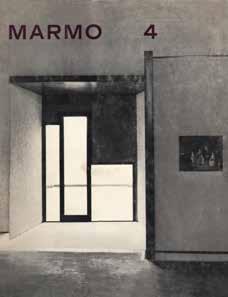
38 1821>2021 The
covers of the first five issues of “Marmo”
NOTES
1 “Henry Moore in Forte dei Marmi and Versilia. The man, the artist”, exhibition catalog (Forte dei Marmi, LU, Civic Gallery of Modern Art, 1998), Pisa 1998, p. 9.
2 D. Colombo, G. Zanchetti, “Moore: voyage in Italy”, in “Henry Moore” exhibition catalog (Rome, Terme di Diocleziano, 2015), edited by C. Stephens and D. Colombo, Tate Electa, Milan 2015, p. 166.
3 Testimony of Vando d’Angiolo, in “Henry Moore”, quote. p. 47.
4 Erminio Cidonio, born in Rocca di Mezzo (AQ) on 13 October 1905, was appointed Henraux’s delegated administrator on April 29, 1957. On May 31, 1961, he assumed the position of general manager. The documents kept in the Henraux Historical Archive [ASH] certify that, on 30 May 1963, he held the positions of managing director, general manager and technical director.
5 P. C. Santini, Introduction, in “Marmi nel parco”, exhibition catalog (Marina di Pietrasanta, LU, Parco della Versiliana 1984), edited by P. C. Santini, Pietrasanta 1984, p. 16.
6 Much of the information on the “Marmo” publishing project is derived from a conversation with Bruno Alfieri on 25 March 2004 in Milan, at Automobilia s.r.l. - Society for the History and Image of the Automobile. For a study of the “Marble” magazine, see L. Conte, “The ‘Marble’ magazine”, in “From ‘Marmo’ to marble. 1962-1972”, exhibition catalog (Seravezza, LU, Palazzo Mediceo, 2004), edited by A. Tosi, with the collaboration of L. Conte and A. Salvadori, Seravezza 2004, pp. 25-33; L. Conte, ‘Marmo’: an international magazine of the sixties, between architecture, sculpture and design”, in “Marmo”, a. I, December 2016, pp. 20-28.
7 Thanks to a letter kept in the Marchiori Archive, published by Anna Vittoria Laghi, it was possible to set the beginning of the collaboration between the critic and the entrepreneur of the Versilian company in July 1962. For an in-depth study of the relationship between Erminio Cidonio and Giuseppe
Giannetto Salotti, Adolfo Saporetti, Pablo Serrano, Carlo Sergio Signori, François Stahly, Alina Szapocknikow, Cornelia Von Den Stein, Georges Vantongerloo and Giorgio Zennaro were exhibited. Shortly thereafter, this organic and refined collection would be dismantled. In fact, on December 31, 1973, as many as twentyfive works were purchased by the Italian Commercial Bank and left Henraux definitively in July 1976. Thanks to the actions of Pier Carlo Santini, some sculptures made a temporary reappearance in Versilia in 1984. The critic from Lucca curated the “Rassegna Marmi del Parco” at the Versiliana Park, hypothesizing a possible museum itinerary for the exhibition of the Versilian collection, created in collaboration with the architect Giuseppe Davanzo.
In 2000, part of the collection was exhibited as part of the 10th International Biennial of Carrara, in a section designated by Anna Vittoria Laghi. A further moment of study was provided by the exhibition “From ‘Marmo’ to Marmo. 1962-1972” curated by Alessandro Tosi with the collaboration of Alberto Salvadori and the writer, held in 2004 at the Palazzo Mediceo in Seravezza. On that occasion, an exhibition itinerary was proposed that privileged the presentation of works still preserved in the collection of the Henraux company (including sculptures and sketches), attending the future museum reorganization project promoted by the Henraux Foundation to give the proper visibility to these works and the visual narration of a story that outlines the identity of the company in the global economic and cultural scenario to the present day.
Marchiori, see A. V. Laghi, “Cidonio, 1963-1965: chronicle of an utopia”, in “X International Biennial City of Carrara. The primacy of sculpture. The Twentieth Century in Carrara and Surroundings”, catalog of the exhibition (Carrara, 2000), edited by C. Bordoni, A. V. Laghi, A. Paolucci, Siena 2000, pp. 280-285; A. V. Laghi, “Giuseppe Marchiori, Henraux and “his” sculptors, from Rossi to Morandi, from Viani to Arp. Giuseppe Marchiori art critic”, exhibition catalog (Venice, Bevilacqua La Masa Foundation, 2002), edited by S. Salvagnini, Venice 2001, pp. 97-109. A.V. Laghi, “L’Henraux di Querceta (1962-72) and his sculptors”, in “From ‘Marmo’ to marble”, cit., pp. 13-21.
8 B. Alfieri, “A new magazine”, in “Marmo”, n. 1, December 1962, p. 13.
9 Ibid.
10 “The sculptor Henry Moore”, in “Marmo”, n. 1, December 1962, pp. 22-47; “Jean Arp, 50 years of creation”, in “Marmo”, n. 2, November 1963, pp. 21 - 57 (with the publication of two poems by Arp); “Adam monumental sculptor”, in “Marmo”, n. 3, December 1964, pp. 28-39.
11 Le Corbusier, “Sur l’Acropole”, in “Marmo”, n. 2, November 1963, pp. 17-21 (diary pages from 1910; indicated in the magazine as published in “Almanach d’architecture moderne”, Esprit Nouveau Collection, 1925); G. Michelucci, “Notes”, in “Marmo”, n. 2, November 1963, pp. 61-63; E. Brunori, “Meeting with Michelucci”, in “Marmo”, n. 2, November 1963, pp. 63-75; L. Mosso, “Alvar Aalto’s Vogelweidplatz”, in “Marmo”, n. 4, December 1965, pp. 8-51.
12 The following contributions are worth noting: P. Sanpaolesi, “The Artemide construction site in Sardi”, in “Marmo”, n. 2, November 1963, pp. 75-87; M. Dezzi Bardeschi, “New research on the Holy Sepulcher in the Rucellai Chapel in Florence”, in “Marmo”, n. 2, November 1963, pp. 134-161; P.C. Santini, “Marble objects by Enzo Mari”, in “Marmo”, n. 3, December 1964, pp. 130-132.
13 Made on commission for Pope John XXIII on the occasion of the Second Vatican Council of 1962.
14 B. Cartei, “The restoration of the marble inlays of Montecassino”, pp. 97-112; A. Dini, “The installation of Henraux at Palazzo Grassi”, pp. 113-122; G. Nuti, “Note on the exhibition of the restoration of Montecassino”, pp. 122-130.
15 Henraux Sculpture Seminar. Regulation, ASH.
16 B. Alfieri, “The first Henraux sculpture workshop”, in “Marmo”, n. 2, November 1963, p. 212.
17 C. V. (Giuseppe Marchiori), “Artisti alla Henraux”, in “Marmo”, n. 3, December 1964, p. 134.
18 C. V. (Giuseppe Marchiori), quote, p. 141
19 C. Volta (Giuseppe Marchiori), in “Marmo”, n. 4, December 1965, p. 202.
20 Ibidem.
21 P. C. Santini, “The great fountain of Adam for Chantilly”, in “Marmo”, n. 4, December 1965, p. 110.
22 Cidonio would follow up elsewhere the project to create an international center for the visual arts in Versilia. In the following years he in fact, opened the “Officina” laboratory at Argentiera di Seravezza, which was oriented towards design.
23 The work can be dated to the end of the 1960s. See A. V. Laghi, profile, in “X International Biennial”, quote, p. 256.
24 The work was presumably made between 1968 and 1969. See letter sent to the artist on 14 March 1969, kept at ASH.
25 The work was presumably made in 1968. See letter sent by the artist to the Henraux company on January 17, 1968, kept at ASH.
26 The work was donated to the company in January 1969. See letter sent by the artist to the General Manager of the Henraux Company on January 9, 1969, kept at ASH.
27 The exhibition ran from 1st July to 30th October. It was organized by the then director of the company, Mario Paiotti, with the collaboration of Tacconi and Citi.
39 1821>2021
THE USE OF MARBLE FROM ALTISSIMO IN SCULPTURE FROM 1821 TO THE BEGINNING OF THE TWENTIETH CENTURY
BY ANDREA TENERINI
Despite the difficulty of finding the sources, the author gives readers a well documented and unique survey on the use of the statuary of Mount Altissimo in great European and international sculpture during the first hundred years of Henraux’s activity.
40 1821>2021

1821>2021
Ernest Christophe, The Human Comedy
The presence of material that lent itself «to any kind of sculpture work» in Seravezza had been confirmed by all the authoritative artists that the two, thanks to their respective friendships, had brought to Versilia.
The disappearance of the oldest evidence relating to the supplies of the material from the Henraux archive prevents a systematic reconstruction, starting from the epicentre, of detailed history on the use of Versilian marble in the sculpture of the period from the neoclassical to the early twentieth-century avant-gardes. To attempt an initial assessment on the subject, which is inevitably just a summary and necessarily discontinuous, it is necessary to direct research into the study of publications on different artists and on the scrutiny of publications of the time or in foreign archives. The French ones, in particular, are rich in documentation, albeit poorly studied. However, they present some difficulties since in the documents the statuary is often defined, in a generic way, as simply coming from Carrara.
Central to the partnership between the former Napoleonic officer Jean-Baptiste Alexandre Henraux and Marco Borrini for the reopening of the Altissimo quarries there was a rather ambitious project which, making use of the men’s relationships, started with the extraction and sale of marble for architecture and decoration to reach the more prestigious one of statuary.
The presence of material that lent itself «to any kind of sculpture work» in Seravezza had been confirmed by all the authoritative artists that the two, thanks to their respective friendships, had brought to Versilia. So already by the beginning of 1823, just over two years after the start of the company, Cavalier Cordero di San Quintino, in correspondence with the Royal Academy of Sciences of Turin following an excursion to the quarries, reported that he had seen «... in Florence at the end of 1820 the first experiment that was made with the new statuary marble of Seravezza which fully corresponded to the common expectation. A skilful Tuscan sculptor took to portray the effigy of Grand Duke

42
1821>2021
Francesco Pozzi, Latona and Her Children
Ferdinando Terzo in profile and surrounded the bas-relief with an ornament so subtly carved and with a garland of flowers carried with so much love, that each of its leaves, each of its branches is drawn into it. hair as if it were made of very white and transparent wax, rather than stone». After the test, the fame of the new marble spread so quickly that, as the numismatist, archaeologist and art historian recalled, “even the Knight Tordwalsen wanted in recent days to prefer it to any other to draw the bust of Emperor Alexander”. Almost simultaneously with the resumption of mining, an artistic workshop was opened in Seravezza and the marble was supplied to the sculptors Giovanni Grazzini and Francesco Pozzi so that they could make works from it. If the former had shaped the aforementioned “Portrait of the Grand Duke”, which produced serially was purchased by various Tuscan administrations, with the Versilian stone Pozzi first created a figure of “Isis” and, in 1825, the group depicting “Latona with sons”, a work celebrated for the sharpness, beauty and toughness of the material.
Probably thanks to the intercession of San Quintino, the Piedmontese Giacomo Spalla, the greatest sculptor of monuments in the Turin of Vittorio Emanuele I, in July of the following year, after a visit to the quarries, bought several blocks of statuary for the execution of some reliefs dedicated to the Savoy victories. In a letter sent to Borrini in February 1827, the author praises the marble obtained “both for its whiteness and uniformity of grain, and for the ease with which it lends itself to the blows of the chisel”. Thanks to a product of undoubted value, to the strong friendships in the Grand Ducal world and, last but not least, to his lively and casual way, Marco Borrini was able to quickly and significantly enter the supplies for the remarkable market of the Italian artistic communities, in particular Florence and Rome. But the attempts of his partner
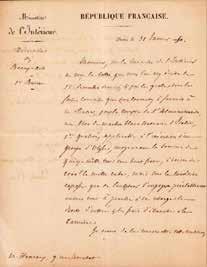
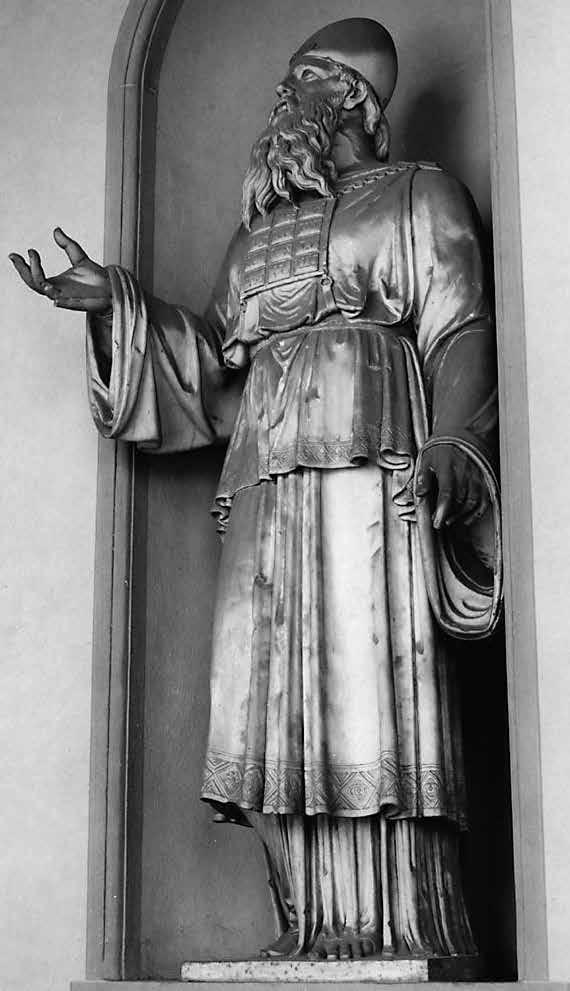
43
The letter from Charles Blanc to Henraux for the supply of a block of marble for the group “Ulysses” by James Pradier
Right, Gaetano Grazzini, Aronne
1821>2021
Over the following years, the appreciation of the material provided gave the definitive push for the complete affirmation of Seravezza marble within the studies of most of the active sculptors across the Alps and a large number of local artists.
Henraux to replace the use of Carrara marble with that of Seravezza in the French market found met with greater difficulty.
From 1806 Henraux was responsible for managing the purchase and shipment of marble blocks for Paris on behalf of Napoleon Bonaparte and later became the government commissioner for these supplies. With the Restoration, the demand for the material for the monuments, which was already high, increased exponentially and the French government tried, unsuccessfully, to find local marble capable of replacing that from the Apuane. Faced with discredit, Henraux, albeit with great difficulty, retained the role of Commissioner until 1823, the year in which Viscount Héricart de Thury, director of public works, suppressed his salary and replaced him with Carlo Orsolini owner of a quarry in Carrara, for the supply of statuary marble. The former officer took a few years to return to de Thury’s good graces, but from 1828, with the closure of all relations between the ministry and Orsolini, the marble of Monte Altissimo began to be used systematically by French sculptors, albeit to achieve a real predilection on the part of the ministerial bodies towards the material of Seravezza, it was necessary to wait until at least 1833.
Two orders, important in this sense were obtained at the beginning of the 1930s for the delivery of the statuary necessary to create many public works to be placed in Paris: four colossal statues for the stock exchange – entrusted to Jean-Pierre Cortot, Pierre Petitot, Jean-Baptiste Roman and James Pradier – and eight sculptures of the “Grands Hommes” series requested by the civil list for the Tuileries Garden.
Shortly thereafter a similar program, with manifest educational and civil values, was undertaken in the Grand Duchy of Tuscany on the initiative of the Florentine printer Vincenzo Batelli with the plan of «twenty-eight statues, representing as many illustrious Tuscan men for virtuous actions, sciences, letters, and arts», to be placed in the loggia of the Uffizi. In 1835 Borrini, adhering to the subscription wanted by Batelli, undertook to deliver the marble of Monte Altissimo to the twenty-four selected Tuscan artists for the realization of all the works. Over the following years, the appreciation of the material provided gave the definitive push for the complete affirmation of Seravezza marble within the studies of most of the active sculptors across the Alps and a large number of local artists. To achieve true international recognition, if not decisive superiority, at least of equivalence between the Versilian and Carrarese stone, it was, however, necessary to activate a more decisive involvement of the artists who worked in the other great Italian cities of art - in particular Rome - and above all to boost the use of the product in the wide Anglo-Saxon artistic world, which for centuries has been the prerogative of the entrepreneurial market of Carrara.
The opportunity to open an important gap also in this last sector of the market was presented with the arrival of Americans Horatio Greenough and Hiram Powers in Florence. Originally from Boston, Greenough was the first American sculptor to settle in the city in 1828. In July 1832 he received a prestigious commission for the construction of a large marble monument to George Washington, to decorate the heart of the Parliament building, from the government of his country. The sculptor and his collaborators took just under ten years to complete the work. Probably thanks also to the high opinion of the Bostonian on the material, several other artists active in the New World came to choose the marble of the Altissimo for the works to be transferred to America; among these, we recall the Neapolitan Luigi Persico who, at the beginning of the 1840’s, decided to use a large block of Versilian marble for the sculpture “The Discovery of America”, placed on the left side of the staircase of the eastern facade of the Capitol. On the right side, about ten years later, the group of “The Rescue” created by Greenough, again with Seravezza marble, was placed. A friend and colleague of the latter, Hiram Powers decided to leave America to settle in Florence in 1837. Shortly after arriving in the city, together with Greenough, he visited the «Seravezza quarries under the name of Altissimo, Vincarella, Polla and Falcovaja»; the two sculptors wrote to Borrini that in those places there is a marble
44 1821>2021
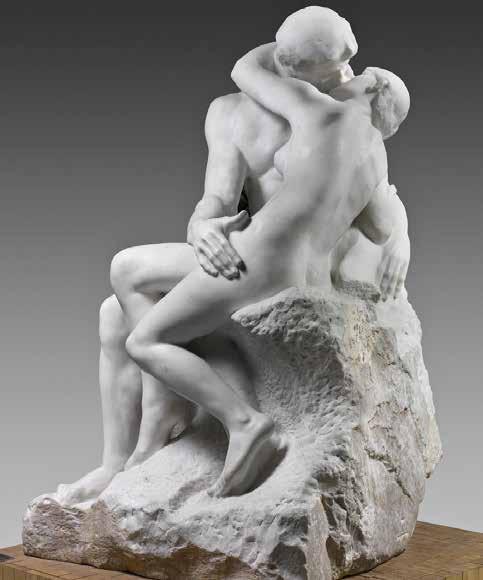
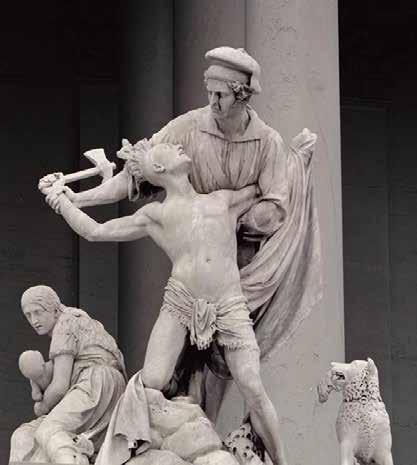
1821>2021
Above, Auguste Rodin, The Kiss
Right, Horatio Greenough, The Rescue

1821>2021
Powers was so impressed by the marble from Altissmo that he openly declared its predilection and superiority over the Carrara marble and, in a short time, became its greatest supporter in the Anglo-Saxon artistic world.
«of a quality equal to the best they had worked», as well as being «in terms of colour, context, fineness of the grain worthy of the highest recommendation».
Powers was so impressed by the marble from Altissimo that he openly declared its predilection and superiority over the Carrara marble and, in a short time, became its greatest supporter in the Anglo-Saxon artistic world. Shortly thereafter, among others, the American Thomas Crawford, a pupil of Thorvaldsen, used the white statuary blocks of Seravezza for the imposing work sculpted in Rome depicting “Orpheus and Cerberus” and the Irish John Hogan, for the colossal statue depicting “Daniel O’Connell”, now in Dublin City Hall.
In 1840, in a short anonymous text entitled «Tuscan statuary marbles» printed in the “Gazzetta di Firenze”, mainly to reject the rumours about an alleged inferior quality of the Altissimo marbles was circulated by the merchants of Carrara, eleven artists were listed in the city studies of which “this Tuscan marble is being worked on in greater or lesser quantities”. Among these, in addition to Hiram Powers and Horatio Greenough, were Luigi Pampaloni, Aristodemo Costoli, Paolo Emilio Demi, Emilio Santarelli, Gaetano Grazzini, Ulisse Cambi, Odoardo Fantacchiotti, Luigi Magi and Raphael Insom.
But it was mainly thanks to the success of the works of Hiram Powers that the fame of the marble of Altissimo spread throughout Europe and the Anglo-Saxon world. Tormented by the expressive rendering of the modelled surface, the American artist found in the marble of a vein recently discovered in the Falcovaia quarries, the ideal material capable of influencing his aesthetics. The obsession with the natural description of Powers’ bodies is particularly expressed in the statue of “Tempted Eve” – now at the National Museum of American Art in Washington – which the artist had exhibited privately in his studio and on which he had worked, shortly after his arrival in Italy until his death. In 1841 – the year in which Berthel Thorvaldsen’s visit to the Altissimo quarry is also remembered – he sculpted “The Greek Slave”, his most famous work, with which he obtained extraordinary success in England and America. The triumphant English premiere of a replica of the statue at the Crystal Palace exhibition
47 1821>2021
Left, Enrico Pazzi, Dante Alighieri
in 1851 strengthened the popularity of the sculpture internationally, boosting Powers’ reputation and definitively promoting the qualities of Seravezza marble.
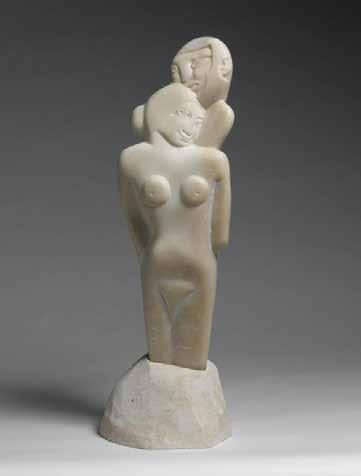
The sculptor – with Greenough, the Grand Duke, the antiquarian Arcangelo Migliarini and the banker Emanuele Fenzi – strongly encouraged the use of this material, considering it the most suitable for rendering the complexion as, despite being harder than marble Carrara, had such a fine grain that it resembled porcelain. When asked about the merits, Powers later declared to the press: «Everyone now craves Seravezza marble and this is largely due to the reputation it has obtained in England through some of my works which did not show stains or defects in the material».
Twenty years after its birth, at the moment of greatest diffusion and appreciation of the Altissimo marble, came the appointment as director of the company of Jean-Bernard Sancholle, whom in 1839 Alexandre Henraux had designated as his universal heir, and the difficult situation of Borrini burdened by debts intensified the company’s relations with France. The award of the prestigious contract for the supply of marble for the tomb of Napoleon I at the Hôtel national des Invalides, together with that for the ornament of St. Isaac’s Cathedral in St. Petersburg designed by Auguste de Montferrand, stipulated in 1845, further consolidated the fame of the Seravezza marbles beyond the Alps. The relations of the Henraux family with the sculptors active in Paris and in particular with James Pradier, creator of the twelve sculptures that today adorn the architectural layout that surrounds the Bonaparte sarcophagus, depicting “Victories” to symbolize Napoleon’s
48 1821>2021
Henri Gaudier Brzeska, Samson and Delilah, erotic group
military campaigns, initially helped the company to maintain a leading role in the supply of the statuary to French sculptors, through state orders.
Despite the appreciation of the international artistic community for the statuary of the Altissimo, the financial difficulties and heavy disputes between the shareholders continued from the mid-1840s. This was due to the inclusion of new shareholders and the establishment of a new company, combined with the reinvigoration of the Carrara market and the use of almost all the workers active in the quarries in honouring the heavy commitment of the order for St. Petersburg. All of which heavily influenced the supply of the material for sculpture.
So, despite Leonardo Pilla in 1845 recounting that «the largest blocks of first-class statuary marble extracted from the quarries of Falcovaia, reduced to the highest degree of cleaning, were 500 to 600 cubic palms (approximately), and served for colossal sculptures», and that the marbles of Altissimo continued to be requested by many artists, especially for works of a monumental nature, the few documents found tell of a considerable slowdown throughout the 1850s and the first half of the following decade in the use of the statuary of Seravezza.
Due to its limited availability and high quality, the marble for sculpture extracted from the Seravezza quarries continued to be the most expensive Apuan marble at the beginning of the 1860s. In the catalogue of the Universal Exhibition in London of 1862 it is recounted how the statuary of Mount Altissimo was «superior to any other, preferred by every chisel,

49 1821>2021
Hiram Powers, The Greek Slave
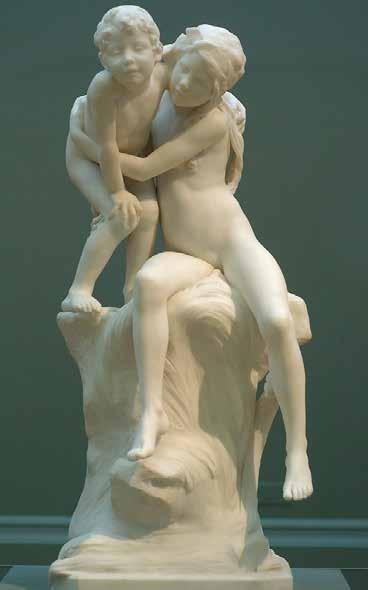
50 1821>2021
but at the same time the most expensive». In that year, in the square of Florence, the firstclass quality marble for sculpture of Carrara was sold at 1200 lire per cubic meter, against 1400 of the similar product of Seravezza, with much higher prices in the case of the larger blocks and those without stains.

During this period there was the extraction from the quarries of La Polla and the triumphal arrival in the city of the majestic 33-ton boulder used by Enrico Pazzi to carve the large statue of “Dante”, which now resides on the side of the facade of Santa Croce in Florence. The sculptor from Ravenna would create several works with Seravezza marble including “Girolamo Savonarola presents Christ as King of Florence to the People” and the bust of “Jean-Bernard Sancholle Henraux” for the home of the entrepreneur, which his son Roger would later replicate, using the same artist for the funeral monument located in the cathedral of Seravezza, designed by the architect of the Paris Opera, Charles Garnier. At the end of January 1864, on a journey to Italy with painter Gustave Boulanger and colleague Louis Victor Louvet, coming from Menton, Garnier stopped for a couple of days in Seravezza and then continued by train to Pisa. In Versilia, hosted by SancholleHenraux, he took the opportunity to visit, probably not for the first time, the quarries of the Altissimo and chose the marble that would be used to build the large staircase of the Opéra.
In this period France, together with Italy, remained the privileged place for sending the statuary marble of Altissimo: in addition to the prominence that the Versilia quarries continue to have in French publications, also the news on the use of the material by important Artists such as Julies Cavelier, who used it for the work “Cornelia mother of the Gracchi”, or Ernest Christophe who chose it for the sculpture “The Human Comedy”. A work also known as “The Mask”, now in the Orsay Museum, is known for the poetry dedicated to it by Charles Baudelaire.
The reasons for the success in France of the statuary marble of Vincarella, Polla and Falcovaia can also be attributed to the more than excellent ties that Jean-Bernard Sancholle Henraux held with the various directors of the French Académie of the Villa Medici in Rome, until his death in 1881. The supply of marble for the plastic artworks sculpted by Pensioners and the granting of considerable discounts, which reached half the market price, undoubtedly exerted a loyalty effect on the product. With the taking over of the company from Jean Bernard’s son, Roger, the attitude became less condescending, also
51 1821>2021
Left, William Robert-Colton, The Spring Tide of Life
Above, Giacomo Spalla, Vittorio Emanuele’s Return to Turin
due in part to some disagreements over the quality of the material supplied and regarding the procurement of the same by Carrara traders. At the end of the eighties, the alternation of the heads of the institution and the arrival of artists linked by an old friendship to the Seravezza company restored strength and impulse to the historic collaboration. At this stage, among the artists most fond of using the marble of Altissimo, we find Henri Chapu. The sculptor, known for the frank and elegant naturalism of his works, is remembered visiting the Seravezza quarries on several occasions and documented, one last time, in the spring of 1890 to work on the bas-relief for the “Monument to Gustave Flaubert”, today at the Musée des Beaux-Arts in Rouen, which its workers had roughed up in the previous weeks. When Roger died in 1890, the Sancholle Henraux family turned to Chapu for the creation of the bust for the monument in the cathedral of Seravezza, which due to the death of Chapu was completed by Charles Desvergnes.

In the autumn of 1901 Bernard, son of Roger, hosted Auguste Rodin in Seravezza, during his triumphal trip to Italy which, in addition to Venice – where he was the guest of honour at the Biennale – also took the sculptor to Turin, Lucca, Perugia and Pisa. His presence in Versilia was determined by the idea of acquiring blocks of marble to be used, in particular, for a replica of the famous «Le Baiser» group. Not only, as the French press wrote, Rodin «returned satisfied with his trip», but the speed of sending the block and, probably, the prices charged were so benevolent that the close collaboration between Rodin and Henraux is continuously attested to over the next fifteen years. The relationship took on even more force in 1906, when Alexandre Berring-Nicoli’s widow,

52 1821>2021
Left, Paolo Emilio Demi, Mother Educator Right, Pio Fedi, Nicola Pisano
who had been one of the sculptor’s suppliers since 1899, sold her business and clients to Henraux. The two companies had already joined forces in 1903 to supply the artist with a particularly large boulder, intended for the “Monument to Pierre Puvis de Chavannes”. After a decade of great difficulties in pairing the material with foreign artists, due to the increase in customs tariffs, the first major trade union unrest and the takeover of the Henraux management by Roger’s four sons, the choice by Auguste Rodin to using mainly the Altissimo marbles brought the Versilian statuary back into vogue, even among foreign sculptors. In the first three decades of the twentieth century, its use is documented, among others, by the Germans Max Klinger, Erwin Kurz and Richard Engelmann, the British George Frampton and William Robert Colton, the American Elisabet Ney and the Australian Bertram Mackennal.
In the period preceding the First World War, one of the emerging personalities of modern sculpture who made extensive use of the marble of Altissimo was Henri Gaudier-Brzeska. An exponent of the vorticist movement, in 1914 Gaudier-Brzeska enlisted in the French army and was killed the following year at the age of 23. From a carving modelled on the style of Rodin, with astonishing speed, the sculptor’s style had evolved towards an original language made of linear and simplified forms as evidenced by the marble work of Altissimo “Samson and Delilah, erotic group”, purchased in 1913 by Ezra Pound, for its mysterious side, the references to oceanic art and implicitly to Gauguin, which is found today at the Center Pompidou.
53 1821>2021
The Auguste Rodin’s presence in Versilia was determined by the idea of acquiring blocks of marble to be used, in particular, for a replica of the famous “Le Baiser” group.

54 1821>2021
HENRAUX SINCE 1821. THE GENESIS OF A GREAT ITALIAN COMPANY
BY COSTANTINO PAOLICCHI
With historical and scientific rigour alongside reference to dependable archival sources, the article traces the genesis of the Versilian company two hundred years after its birth: the steps that led to its foundation and its evolution from a corporate profile up to the advent of the “Cidonio’s era” post Second World War.
55 1821>2021
The
The
20th January, 1821
first page of the contract which established
Henraux company on
56
1821>2021
Portraits of Jean Baptiste Alexandre Henraux and Marco Borrini
With a contract drawn up by the notary Frullani, on January 20, 1821, the Borrini-Henraux joint venture was established for the exploitation of the marble farms of Monte Altissimo. Even today, the company bears the name of one of its first founders: Jean Baptiste Alexandre Henraux.
For some years now in company catalogues, monographs and advertising material, Henraux has included this phrase under the company name: since 1821. It does so out of legitimate pride because very few Italian companies can boast such longevity.
Of course, it is not as old as the Siena based company of Baron Ricasoli which has been selling oil and wine since 1141, nor, the Barovier & Toso company founded in Murano in 1295 or the Camuffo di Portogruaro which has been building ships since 1438; not even as old as the Beretta of Gardone Val Trompia which has been manufacturing weapons since 1526. But Henraux was born before Ansaldo (1853), Pirelli (1872) and Fiat (1899).
With a contract drawn up by the notary Frullani, On January 20, 1821, the BorriniHenraux joint venture was established for the exploitation of the marble of Monte Altissimo. Even today, the company bears the name of one of its first founders: Jean Baptiste Alexandre Henraux, a native of Sedan in France where he was born in 1775 to Giovanni Battista and Caterina Jacquillon; a former Napoleonic officer, and shopkeeper in Paris, he worked in Carrara as “Royal Superintendent for the selection and purchase of white marble and Carrara statuary for public monuments in France”.
The other partner was Marco Borrini, born in Vicopisano (PI) on 1 October 1787 to a wealthy family of Ligurian origin. He completed his higher learning at the University of Pisa in the Faculty of Law, where he graduated in utroque iure on 6 June 1808.1 With the transfer of his family to Seravezza, over the following two years he found employment as a secretary at the town’s maire, a position that in 1811 he left to his brother Luigi when he obtained a “supernumerary” commission in the Direction of Direct Contributions. His father Andrea was one of the members of the municipal council of the “Commune di Seravezza”.
From 1815 Borrini forwarded requests for aid and subsidies to Grand Duke Ferdinand III, which were accepted in 1817 after the severe famine of the previous year. With a dispatch dated 27 October 1816, the Grand Duke ordered the arrangement of the road that leads from Pontestazzemese to the Warehouse (later Forte Dei Marmi), offering new possibilities for the marketing of marble even if the extraction and processing activities were almost irrelevant: before 1817 the quarries in activities in the Versilia mountains – according to the data provided by Nicolao Cerchi’s report2 – there were only eleven, in the La Cappella area, and were limited to superficial excavations. In Seravezza there were eighteen stonecutters in all and the town appeared, according to the testimony of Barbacciani Fedeli as «... a place of mean rather than comfortable appearance, sparsely populated and less commercial», with narrow streets and miserable houses except for the «Palazzo Ducale and eight or ten stately homes3».
Marco Borrini, an educated man, well known in Florence at the grand-ducal court, was gonfalonier of Seravezza and in 1836 obtained the First Class Decoration of Industrial Merit, as «promoter of the excavation of the marble of Monte Altissimo». Of the two founding partners, he was undoubtedly the one who was less lucky, dissipating a substantial patrimony in the space of a few decades, so much so that he was forced to gradually transfer all his properties to Henraux.
He died poor in 1876, at the age of 89, almost forgotten by everyone. Yet, it was he who was the first to understand the possibilities of development of the marble industry in Versilia and to rediscover the mineral riches of Monte Altissimo. On the contrary, Jean Baptiste Alexandre Henraux proved to be skilled in business and was able to manage the company with high professionalism. In September 1839 he appointed his nephew JeanBernard Sancholle as his universal heir, who added the name of his uncle to his surname.
57 1821>2021
The statuary marbles of Monte Altissimo soon acquired wide notoriety, so much so that internationally renowned sculptors such as Hiram Powers, Gaetano Grazzini, Giacomo Spalla, Lorenzo Bartolini preferred them to those of Carrara.
Alexandre Henraux died on April 26, 1843, among «... the universal lamentation of the Versilian people, not to mention the Italians», Barbacciani Fedeli noted.4
Bernard, freshly arrived from Paris, set up a limited partnership under the name “Bernardo Sancholle Henraux & C.”, with the support of the French financier Count Henry De Sercy. In 1846 the company was transformed into an anonymous company and took on the name “Società del Monte Altissimo”. In those years the company was engaged in prestigious orders, such as the supply of large quantities of marble for St. Isaac’s Cathedral in St. Petersburg. The statuary marbles of Monte Altissimo soon acquired wide notoriety, so much so that internationally renowned sculptors such as Hiram Powers, Gaetano Grazzini, Giacomo Spalla, Lorenzo Bartolini preferred them to those of Carrara.
Bernardo was able to overcome the difficult moments and the troubled events of the company, characterized by long-standing legal disputes, and eventually became the sole owner of the company, of the numerous quarries, opened all over the upper Versilia and of the whole Monte Altissimo.
This extraordinary mountain was explored by Michelangelo around 1517, a few years after the donation of the marble farms to the Signoria of Florence by the communities of Seravezza and Cappella: the discovery of vast deposits of statuary at Altissmo led the sculptor to abandon Carrara to start the cultivation, after having obtained the right to procure free of that marble for life. This undertaking proved to be unsuccessful, due to the great difficulties encountered by the artist due to the harshness of the environments and the inexperience of the workers.
More than forty years later, Cosimo I Medici, Duke of Florence and Siena, had better luck, he completed the road begun by Michelangelo and started the excavations on Monte Altissimo.
58 1821>2021
Saint Isaac’s Cathedral, St Petersburg
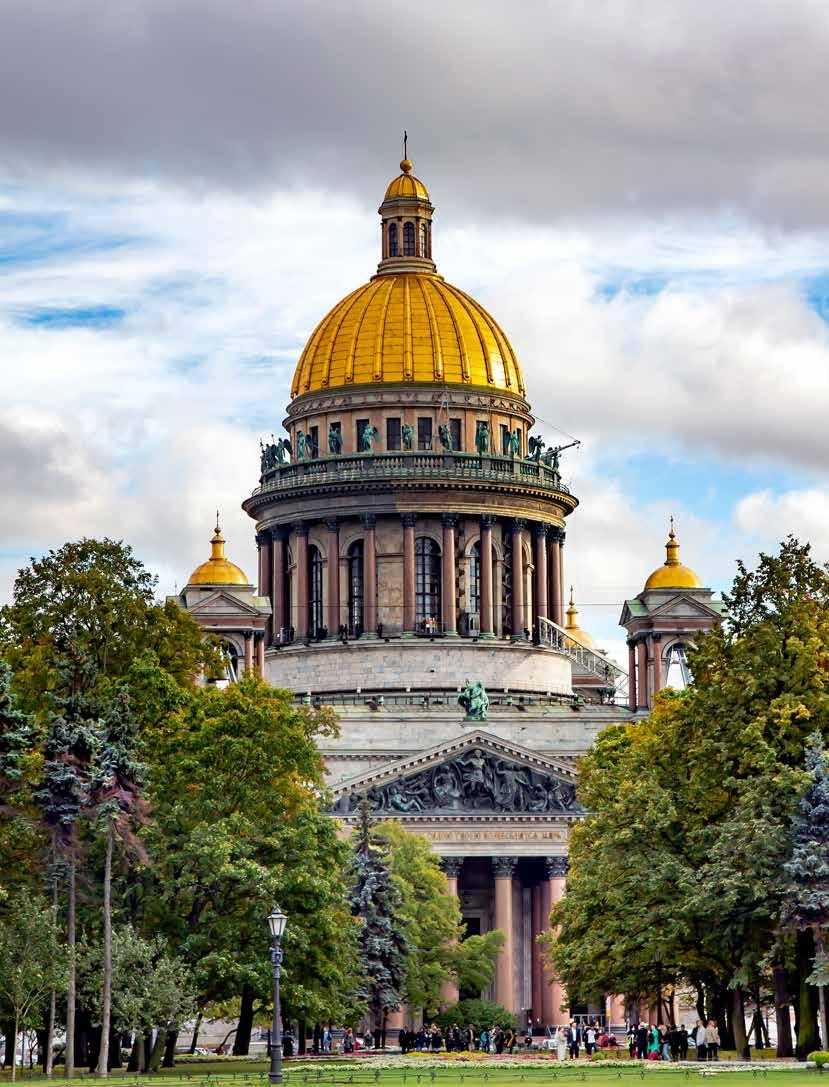
1821>2021
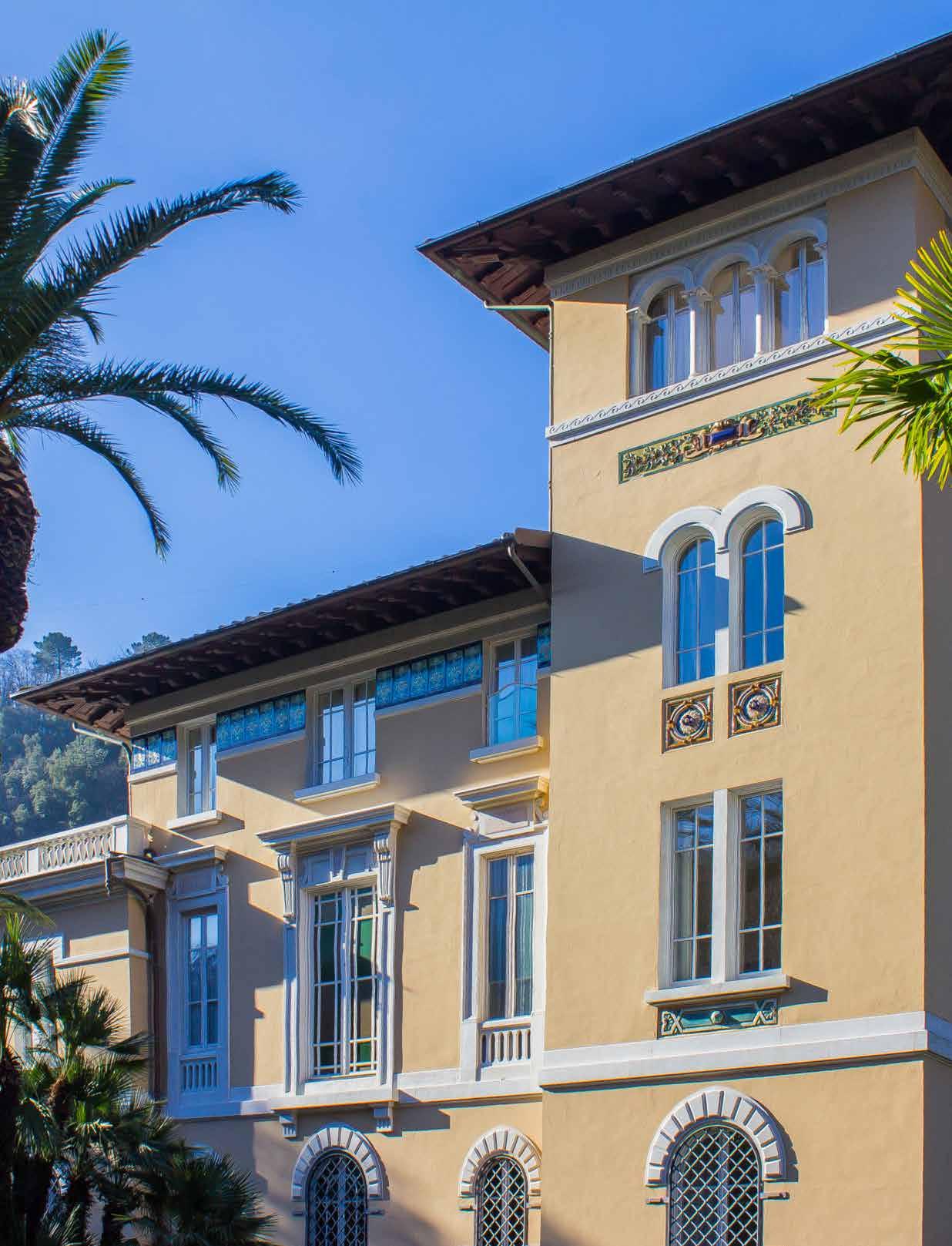
1821>2021
With the decline of the Medici dynasty, the quarries of Monte Altissimo were abandoned for over a century, and it was only around 1820 that Marco Borrini decided to reactivate them, after having bought all the southern side of the mountain (where the Medici had undertaken the excavation) from the Community of Seravezza and after having requested and obtained a loan from the Grand Ducal government for the restoration of the Cosimin road.
The company managed by Bernardo Sancholle Henraux prospered: the technological innovations introduced in the excavation and in particular in the processing of marble, allowed a considerable increase in production and employment. The results of the new technologies were successfully presented by Henraux himself at the Florence Exposition of 1861 and at that of Paris in 1866.
When Bernardo passed away in 1881, his son Roger and daughter Marguerite, married to Lucien Delatre, became owners of the company. The “Héritiers S. Henraux”, a familyrun company, was then founded and a third of the “Società d’Arni” was purchased, which had activated several quarries in the Arni valley, recently accessible by a carriage road. Roger died in Paris on June 17, 1890. His sons Lucien, Albert, Maxime and Jean-Bernard took over the management of the company, assisted by their aunt Margherita and her husband Lucien Delatre, who took over the management. The couple founded and maintained a kindergarten in Seravezza, which still bears their name today, as well as financially supporting the Seravezza School of Fine Arts.
When Lucien Delatre passed away, the management of the company passed to Jean Bernard Sancholle Henraux, who was born in Chanceaux sur Choisille in 1874. The success of the company “Les Héritiers S. Henraux” continued unabated until the severe depression that preceded the First World War, favoured by the resourcefulness of its administrators and by the technological improvements introduced in the sawmills such as automatic distribution looms and in the quarries with the use of helical wire and pneumatic hammers.
The company managed by Bernardo Sancholle Henraux prospered: the technological innovations introduced in the excavation and in particular in the processing of marble, allowed a considerable increase in production and employment.
61 1821>2021
The Henraux villa in Seravezza
Photo by Stefano De Franceschi
 Panorama of Monte Altissimo from Cappella
Panorama of Monte Altissimo from Cappella
1821>2021
Photo by Nicola Gnesi
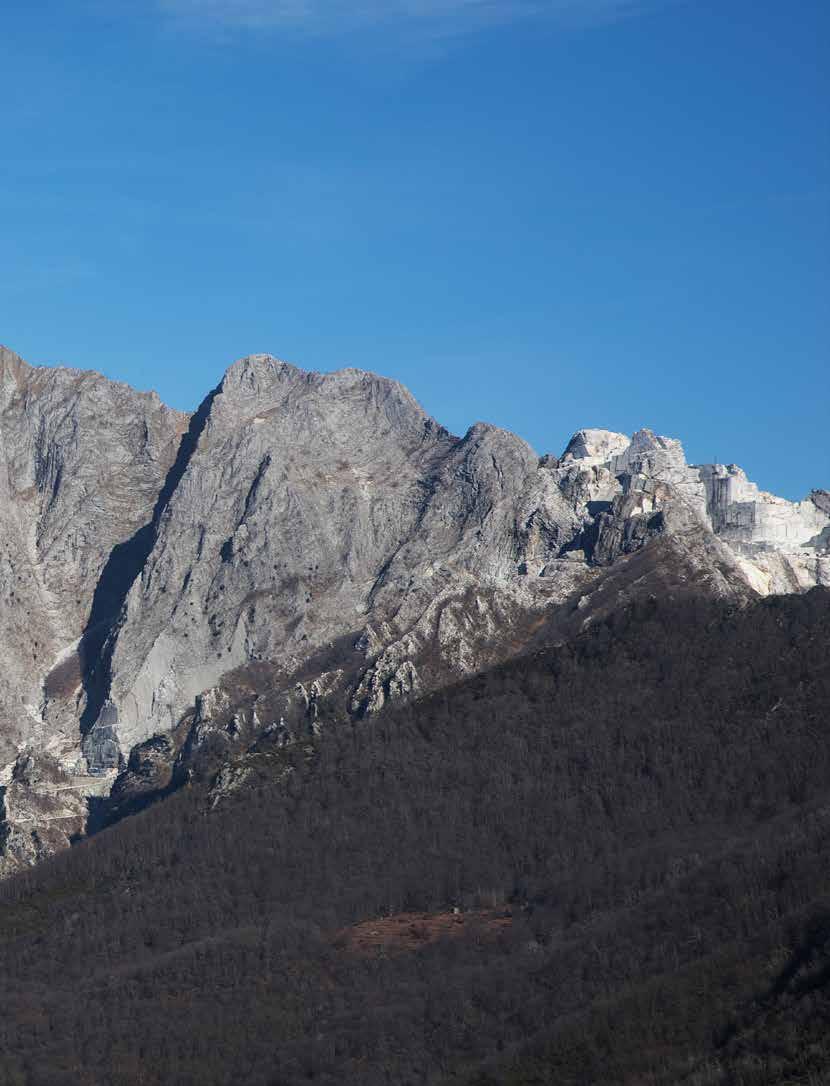
1821>2021
The great French sculptor Auguste Rodin also had the Héritiers Henraux company among his suppliers for a long period starting in 1901 and in the autumn of that year he met Bernard and stayed in his villa in Seravezza.5
The Henraux company, led by Bernard who published a photographic album in 1908 containing marvellous images of the company’s quarries, warehouses and factories,6 maintained a family-like management until 1921 when the new development of the post-war stone sector led to transform the company into a joint-stock company with the contribution of new capital contributed by the Belgians George Henroz and Matteo Van Roggen. With a general power of attorney signed with the notary Charles Tollu in Paris on April 29, 1921, Lucien, Albert, Maxime Sancholle Henraux entrusted Bernard with the task of representing them. The “Società Anonima S. Henraux”, a joint-stock company, was established on 23 May 1921 on the deeds of the notary Luigi Foscarini in Milan.
In the early 1930s, the Sancholle Henraux family departed the company and it became the property of a group of the Société Générale de la Belgique bank. The company name of the “Società Anonima S. Henraux” was replaced, by a resolution of 29 June 1936, with the name “Società Marmifera Italiana Henraux” and in 1940, for reasons connected with the regime’s autarchic policy, again changed to “Italian Marble Society”.
In 1945, after the interruption of activity caused by the war, especially events that hit Versilia on the Gothic Line, the company reported the company name – with a specific statutory provision – under the name “Società Anonima S. Henraux”, a company for shares, with Italian capital, directed and managed by the Cidonio brothers.
NOTES
1 State Archives of Pisa University, 2nd Deposit, Section D, II-9 n. 232.
2 Report by the Chancellor of Pietrasanta Nicolao Cerchi on the state of the arts, manufacturing, agriculture and commerce in the Grand Duchy, March 1768, in the State Archives of Florence, “Carte Gianni”, cit.
3 R. Barbacciani Fedeli, “Historical, political, agricultural and commercial essay of the ancient and modern Versilia”, Florence 1845.
4 R. Barbacciani Fedeli, “Historical, political, agricultural and commercial essay of ancient and modern Versilia”, Florence 1845.
5 We learn this from the essay by Véronique Mattiussi, “Itinéraire d’un bloc de marbre: Rodin et ses fournisseurs”, in the catalog of the exhibition “Rodin. La chair, le marbre ”, Musée Rodin, Paris June 2012-March 2013.
6 B. Sancholle Henraux, “Seravezza, Du Forte dei Marmi à l’Altissimo et au Val d’Arni”, Paris 1908; anastatic reprint in Italian version with introduction by D. Orlandi, Pontedera 2000.
64 1821>2021
FROM ARCHITECTURE TO ART AND BACK
BY TURAN DUDA, FAIA FOUNDING PRINCIPAL DUDA|PAINE ARCHITECTS
Any architectural project that uses stone material, and marble in particular, as at 601 Massachusetts Avenue (Washington DC), is first of all a “voyage of discovery”. Discovery of the specific materiality of each stone and of the strong combination of architecture and art that cannot - and must not - ever be forgotten.
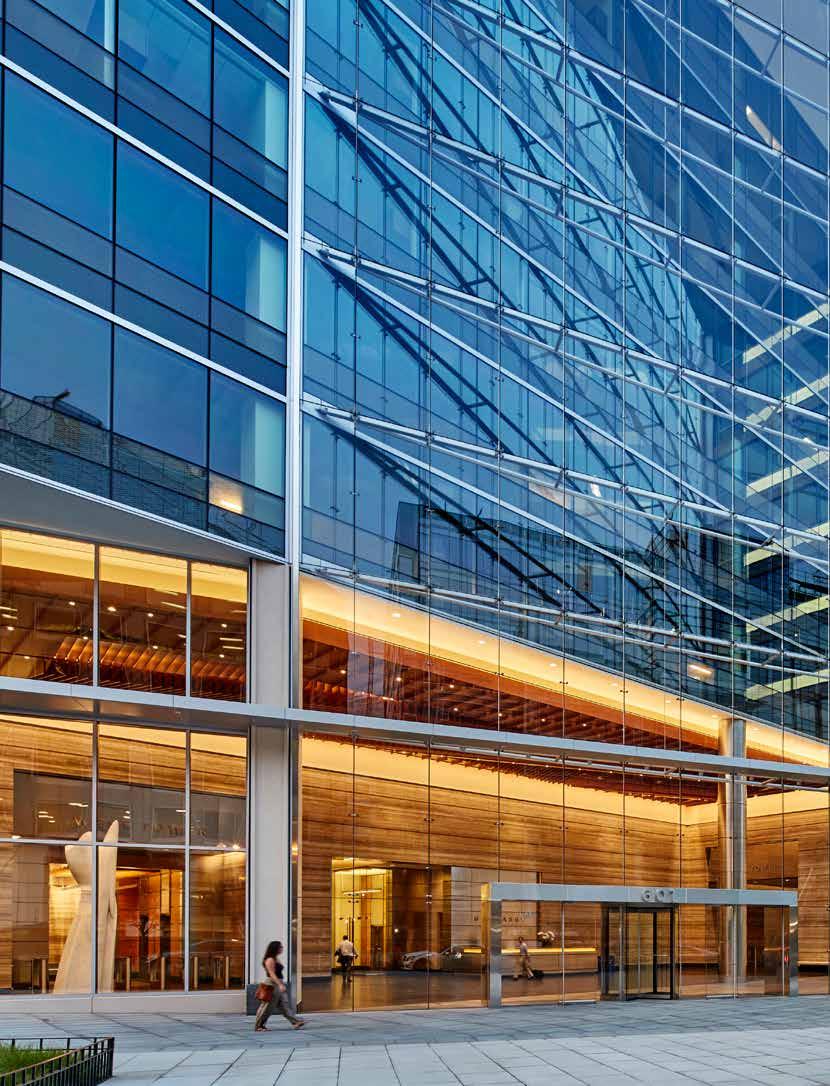
601 Massachusetts Avenue, Washington DC, exterior On the following page, the building’s hall
Architecture
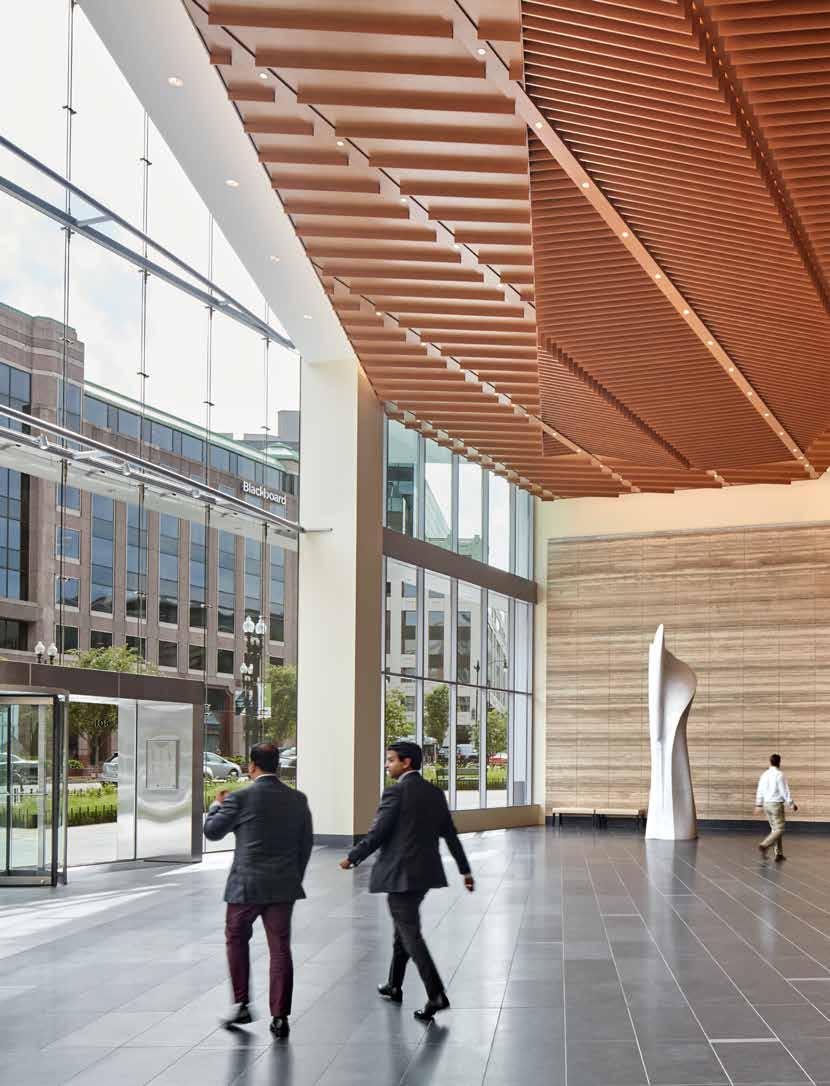
Architecture
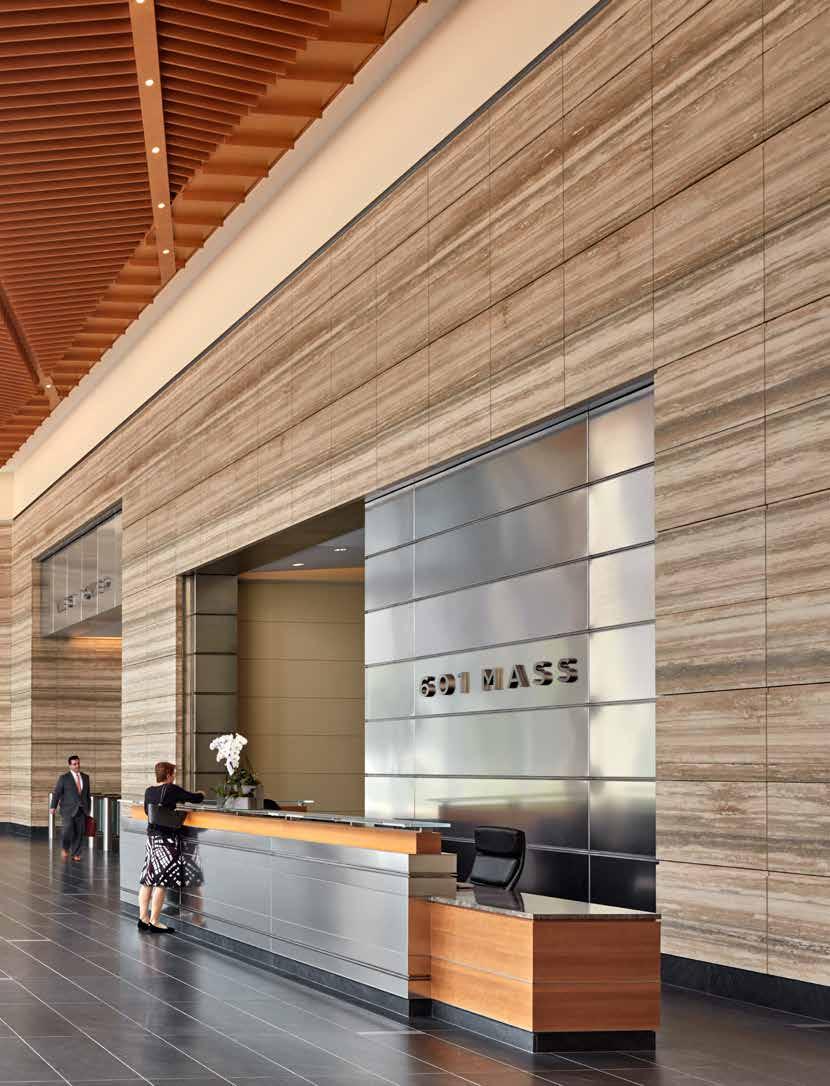
Architecture
I have been working with stone and utilizing it in my buildings for over forty years. For thirty-two of them, I have worked with Paolo Carli – before and after he began directing Henraux. During this time, I’ve experienced the evolution of my own thinking about stone in architecture and, with every visit to Italy, I’ve made new discoveries. I don’t use the word “discoveries” lightly. Each visit exponentially inspires further evolution in my creative outlook on making art and architecture.
The first, and perhaps most important, discovery is an understanding of the materiality of a particular stone. That understanding begins with a visit to the top of the great Mount Altissimo near Pietrasanta, Italy, and a venture into the quarry it holds. Here, every architect can gain awareness of the magnitude of human effort involved in extracting stone in bringing the material down from the mountain and in shaping their vision for that material into reality. We can also begin to comprehend its limitations,
flaws and fundamental beauty. A small stone sample pondered over in the office is revealed in the totality of blocks and slabs. And this often leads to a complete reimagining of how the material will be used.
The second discovery comes from visiting Italy and experiencing first-hand 2000 years of stone in its architecture. The application of marble and granite into architecture throughout history – from antiquity until present time – provides us a lesson in itself. One truism passed down is that stone, shaped over time by each generation, speaks to us. If we listen closely, we see how their voices have changed. A block of marble in Ancient Roman architecture finds modern voice in the hands of a designer like Carlo Scarpa. Whether the transformation happens due to technology or artistic intention, the results are profoundly different.
A third revelation comes from the phenomenon of artists thinking like architects and architects thinking like
begins with a visit to the top of the great Mount Altissimo near Pietrasanta, Italy, and a venture into the quarry it holds.

68
The first, and perhaps most important, discovery is an understanding the materiality of a particular stone. That understanding
Architecture
Above, a view of a quarry at Henraux Right, detail of a marble wall
Architecture
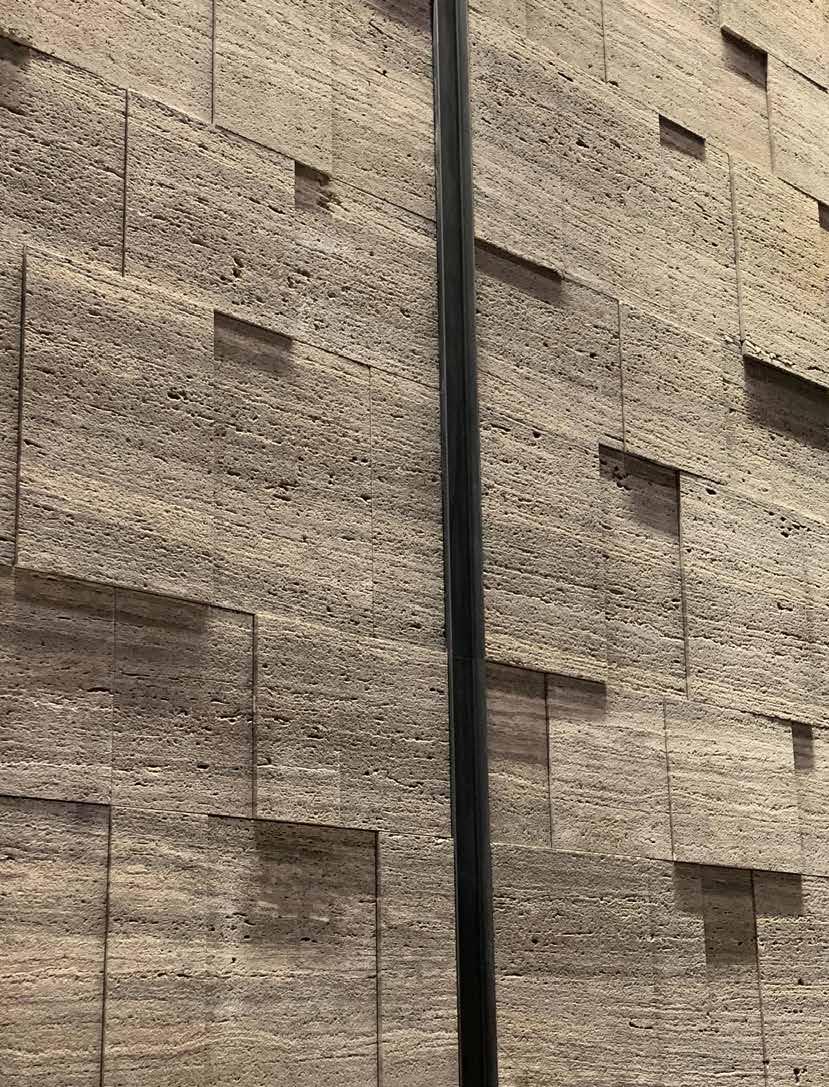
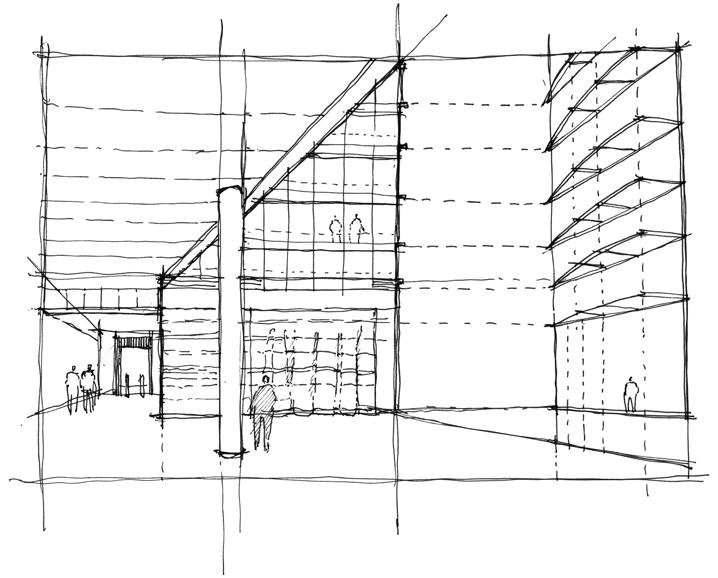
70 Architecture
601 Massachusetts Avenue, sketches
Right, detail of a marble wall
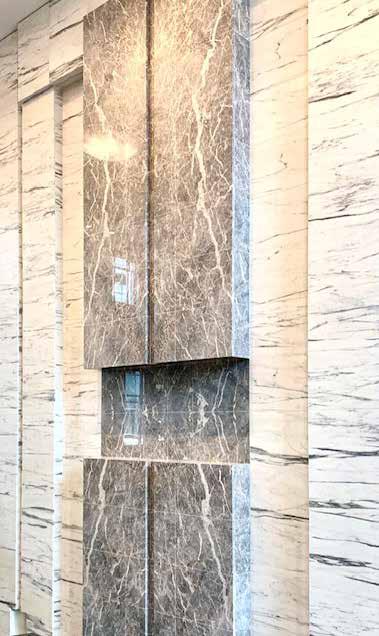
71 Architecture
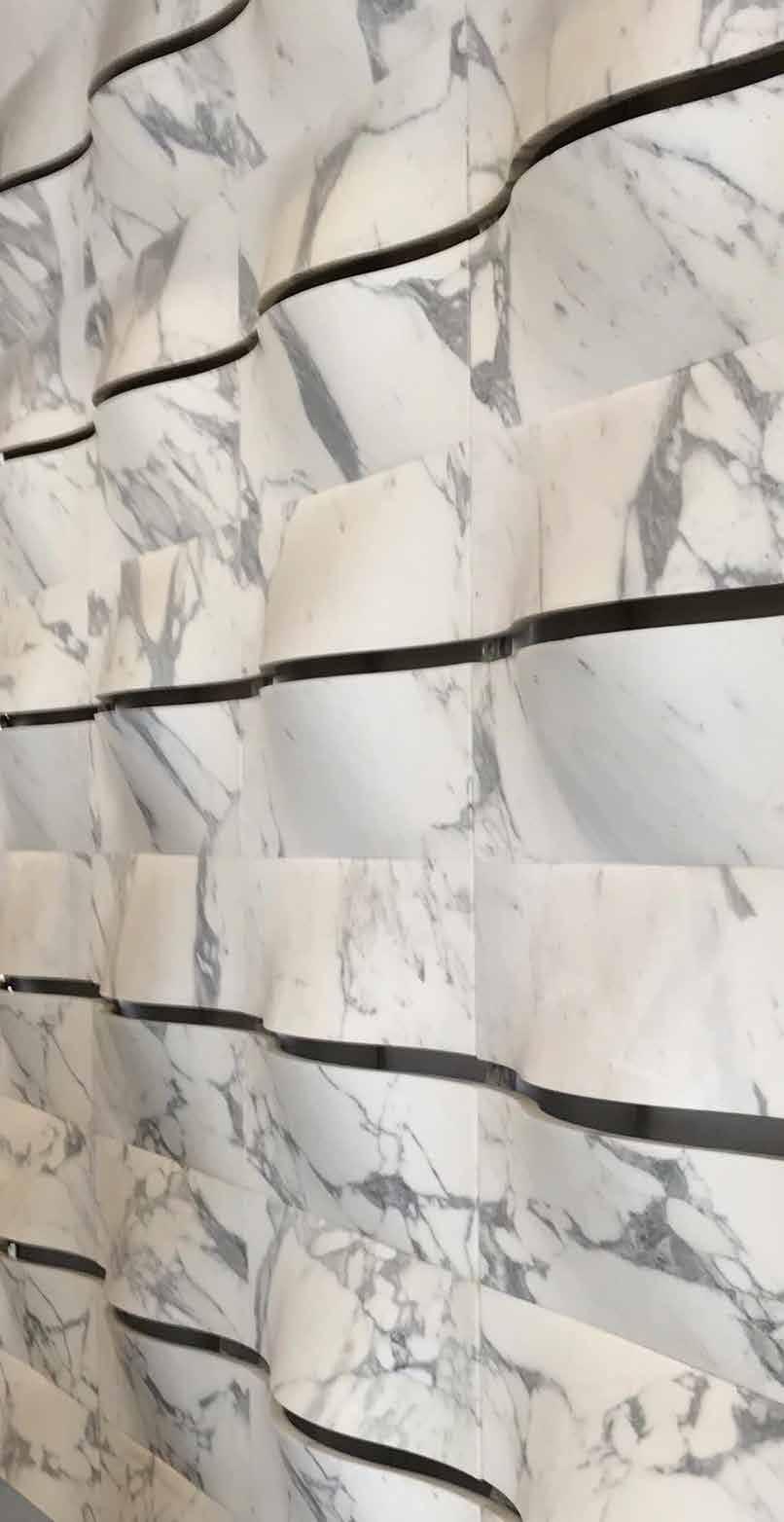
Architecture
Detail of a wall in Bianco Altissimo marble for the Marmomac booth, Verona 2009
artists. As the sculptor Isamu Noguchi once stated: «When the time came to work in larger spaces, I conceived them as gardens». With the expansive notion of gardens, the scale of Noguchi’s work grew vaster and often involved multiple pieces arranged in meaningful spatial associations. The same can be said for Mimmo Paladino and his installation at Piazza Santa Croce, “La Croce, 2012”. Paladino states: «Here I decided to create a place, not sculpture, using available features to which I could add new ones...». This notion of place making and improvising within a given context is a natural inclination to architects, who utilize existing, found and invented objects to create a modern adaptation of an established architectural space. We architects, conversely, either conceive of our buildings as sculptural forms or try to push the limits of enclosure to a new dimension. Here, stone can play a transformational role. When a flat surface of marble is pushed, pulled and shaped to become three dimensional, it invites human interaction and takes on new meaning. The bas-relief created expands the boundaries of simple cladding – it becomes sculptural and emerges as art.
The final discovery comes from the pure experience of seeing art and architecture through the lens of time and movement. The concept is beautifully stated by Noguchi, «My view is that sculpture is the art which can only be appreciated in the raw, relative to man’s motion, to time’s passage, and to its constantly changing situation». This idea – that of movement into and through buildings –intrigues me most. When one enters a room through a framed opening and is then led to an artistic phenomenon meant to be viewed before progressing to the journey’s next episode, the experience becomes cinematic. These artistic moments are only possible when supplemented by an element of surprise. Either that phenomenon is revealed to us unexpectedly, or our conventional expectation of a particular material is altered in a wonderous way.
This idea is well-conveyed in our design for 601 Massachusetts Avenue in Washington DC. Stone art serves as a landmark to orient and guide visitors entering and leaving the building’s voluminous lobby. The vertical white marble sculpture by Giovanni Balderi was essential to our conception of the space – it marks a powerful pivot
73 Architecture
Over the years I have seen Paolo Carli and Henraux pushing the limits of what stone can achieve through their legacy of knowledge about the material and investment in the latest robotic technology.

point at the center of two axes aligned with deep elevator banks. The lobby’s three travertine-wrapped walls end unexpectedly, and the stone comes to life as a three dimensional undulating curtain. These moments are perceived as one moves through the lobby space and take on different meaning whether perceived from a distance or up close. Ultimately it is the process of imagination and invention that makes the use of natural stone a tremendous medium for expression. Over the years I have seen Paolo Carli and Henraux pushing the limits of what stone can achieve
through their legacy of knowledge about the material and investment in the latest robotic technology. Paolo produces the elements of architectural expression while residing squarely in the world of working with artists. His ability to push their, and the material’s, capabilities is testimony to the wonderful sense of experimentation in his stone yard. Every year he invites young artists to challenge him by creating conceptual works of art that further expand the possibilities of sculptural stone. The influence on me has been profound. I am continually inspired to explore new
74 Architecture
The hall at 601 Massachusetts Avenue in a render
expressions of stone in architecture. In Henraux’s exhibition for Marmomac in 2008, the playfulness of many new artists and the technology required to fulfill their ideas in part inspired a wavewall of repeating elements. Ultimately, a simple wire sliced through the white marble of Mount Altissimo to yield a plane that warps and skews with life. Multiples of stone were arranged to create a ribboned pattern that presents unimaginable possibilities for the use of marble in architecture.
I now think of the experience of architecture as a performance with
an adaptable script and numerous, layered moments of discovery. The performance’s cast includes light, material, scale and movement. If I think of stone as the play’s protagonist, I ask, what does it want to say? What is its personality? What human emotion can it evoke? To imagine an inert stone slab as having personality may be surprising, yet we all have a visceral response to the color, texture and patterning of stone. We recognize it has a history and, even better, shaped by human hands, stone gains a narrative that embodies artistic intention.
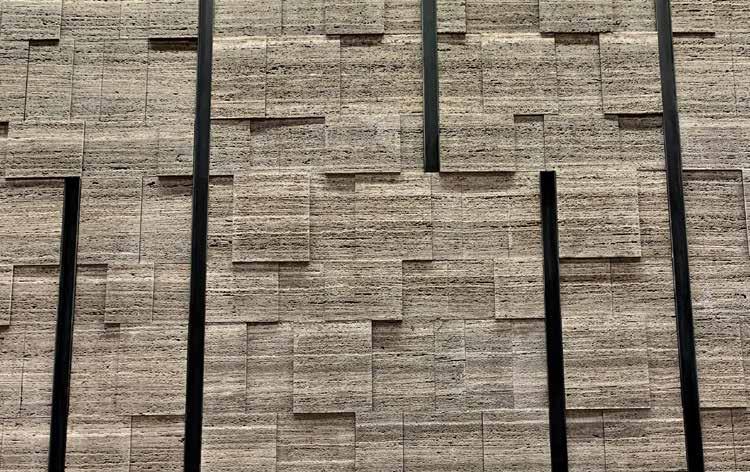
75
Architecture
THE MORAL OF THE STORY ACCORDING TO NEÏL BELOUFA
BY EDOARDO BONASPETTI PHOTOS BY NICOLA GNESI
The relationship between a piece of work and its viewer is at the centre of “The Moral of the Story”, the installation that the Franco-Algerian artist created in Milan in collaboration with the Henraux Foundation. And so the institution is once again linked to one of the most popular names on the international art scene.
76 Art
Neïl Beloufa, The Moral of the Story 2021, Milan, Apple Piazza Liberty. Installation view
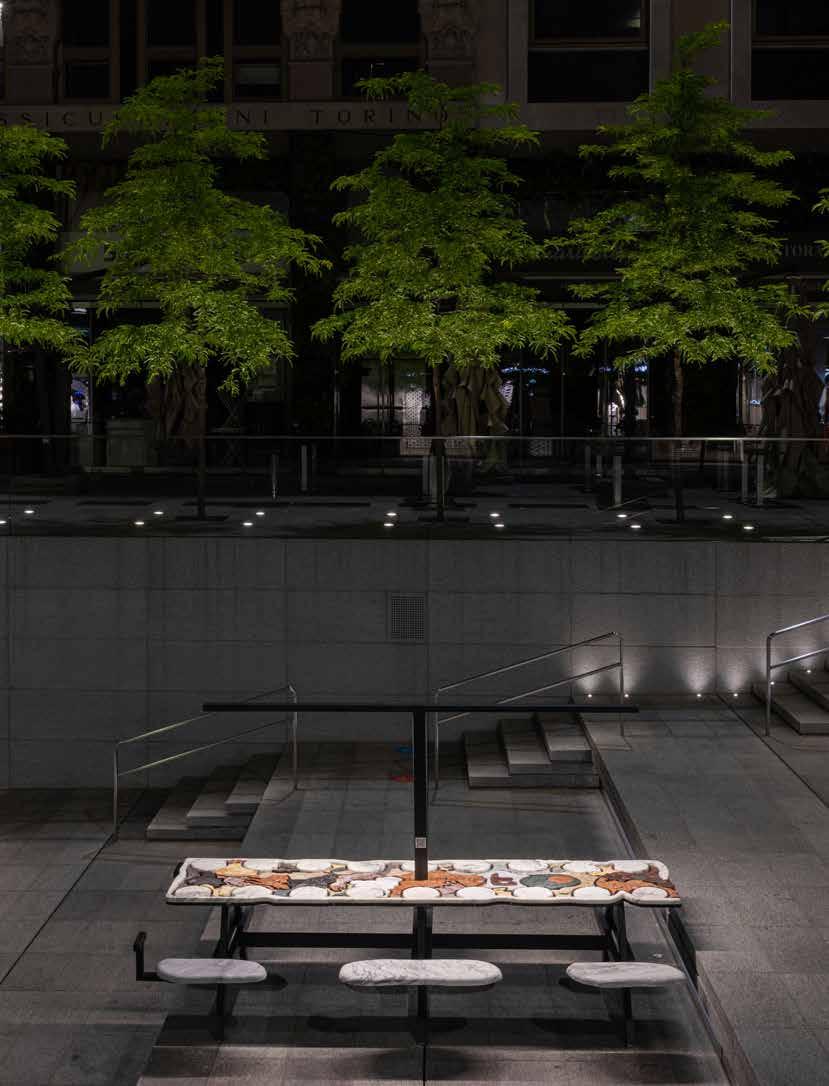
Art
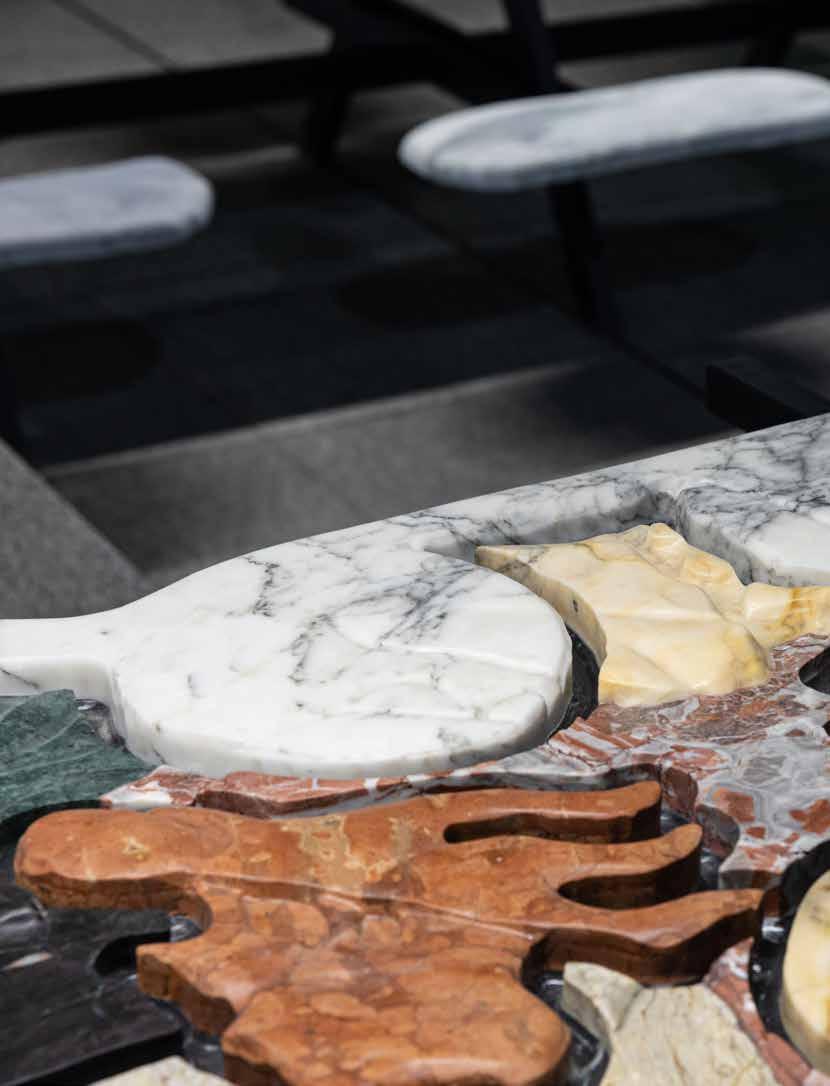
Art
Neïl Beloufa, The Moral of the Story, 2021, Milan, Apple Piazza Liberty. Installation view

Art
The choice of creating seats as elements of street furniture to tell a fairy tale, the use of the grooves of the bas-reliefs to make the surfaces of the tables “dysfunctional” and backgrounds of colour that blur the contours of the figures represented, are all actions that force us to decide what to see or recognise.
Faced with a reality that has become a source of oppression and denial, sometimes it can happen that we do not recognize it or become estranged from it. Another possibility is to deal with problems by altering their mechanisms, forcing their defects and compromises to emerge. We begin with what we can see, we try to make the system work differently and while subverting it from the inside, a critical distance is interposed and a space that is favourable to action is created.
This pro-active attitude, this way of being simultaneously inside and outside, summarizes the ability and talent of the Franco-Algerian artist Neïl Beloufa (Paris, 1985) who, through a practice
that ranges from cinema to sculpture and installation, deals with the paradoxes of contemporary society, revealing systems of representation and offering the observer the tools to draw out revelations and new awareness.
It is with this in mind that the Henraux Foundation presented “The Moral of the Story” in Milan, a project conceived for the public space of the Apple Piazza Liberty amphitheatre. The work consists of four installations decorated with bas-reliefs and inlays of polychrome marble depicting the chapters of a story written by the artist for his daughter. The heroes – a camel, foxes and a colony of ants – face a series of misadventures that Beloufa presents without any explicit
80 Art

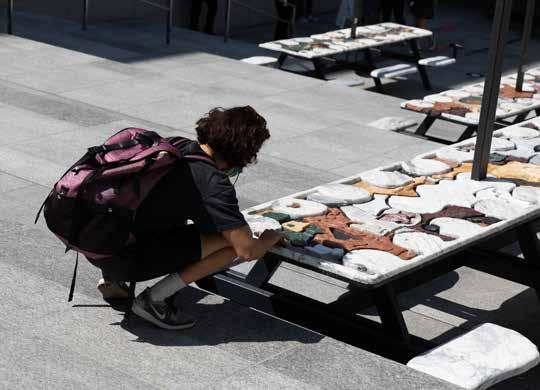
Art
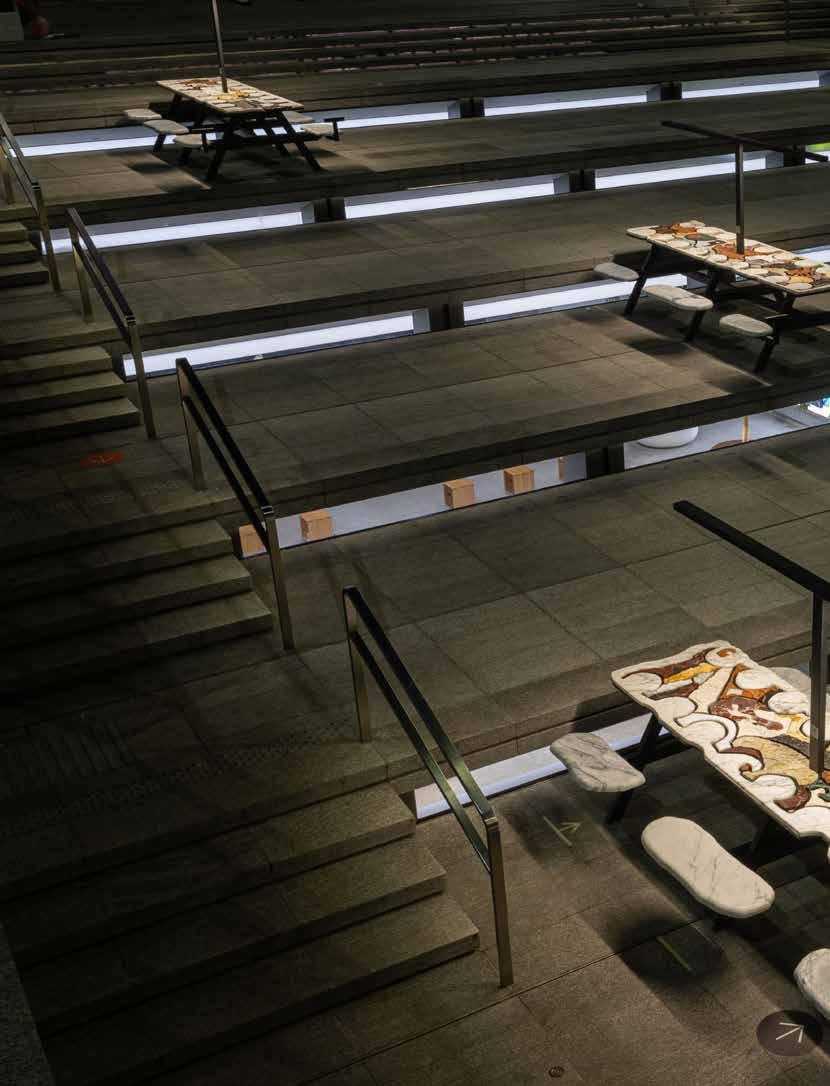
Art

Art
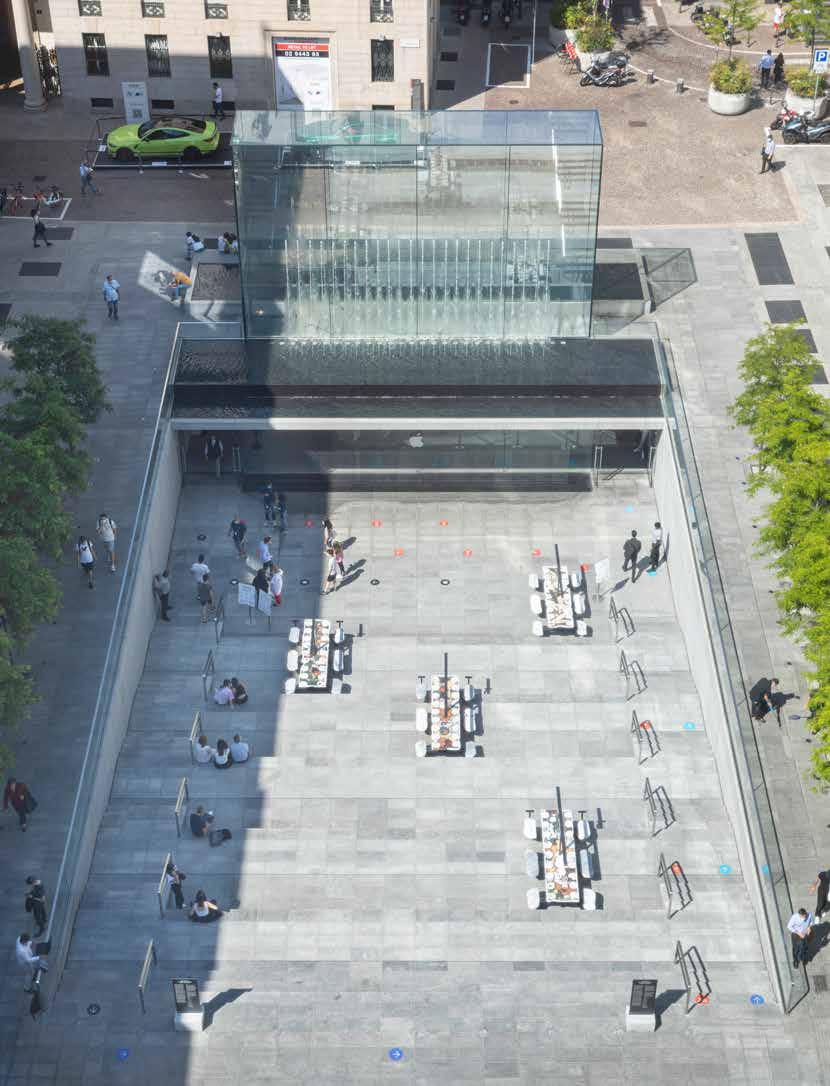
Art
The works, produced by Henraux with advanced 3D marble processing technologies and hand-finished by skilled workers, are accessible both during the day and at night, and can also be explored through smartphones thanks to QR codes that refer to illustrations accompanied by a narrator.
moral judgment, but that deal with social, economic and environmental issues. By utilising the strategies of entertainment to intervene in the way we react to representations and contexts, Beloufa realizes his exhibitions as “open” systems, the result of a practice that adopts intentionally destabilising aesthetic registers. The choice of creating seats as elements of street furniture to tell a fairy tale, the use of the grooves of the basreliefs to make the surfaces of the tables “dysfunctional” and backgrounds of colour that blur the contours of the figures represented, are all actions that force us to decide what to see or recognise.
The outcome becomes a game between reality and fiction in which the visitors themselves decide how to relate to the works and connect forms, stories
and ideas. And so the artist alters the power distance between the author and the public, between the object and the process, offering exhibition models which are more aware and horizontal. The works, produced by Henraux with advanced 3D marble processing technologies and hand-finished by skilled workers, are accessible both during the day and at night, and can also be explored through smartphones thanks to QR codes that refer to illustrations accompanied by a narrator.
“The Moral of the Story” by Neïl Beloufa offers an opportunity for reflection through artistic research and a symbolic language that recognises the value of experimentation and sharing privileged tools for change.
85 Art
Neïl Beloufa, The Moral of the Story, 2021, Milan, Apple Piazza Liberty. Installation view
PHILIPPE, MARBLE AND THE HENRAUX PRIZE
BY JEAN BLANCHAERT PHOTOS BY NICOLA GNESI
An ironic, emotional and vital recollection of Philippe Daverio, a few months after his death, signed by his friend and companion of many work adventures. A homage to the well-known art critic evoking the special relationship that bound him to marble and, starting from 2011, also to Henraux. Alongside Daverio, Paolo Carli created the Henraux International Sculpture prize of which, in 2020, the fifth edition was postponed due to the pandemic.
Philippe Daverio
86 Art
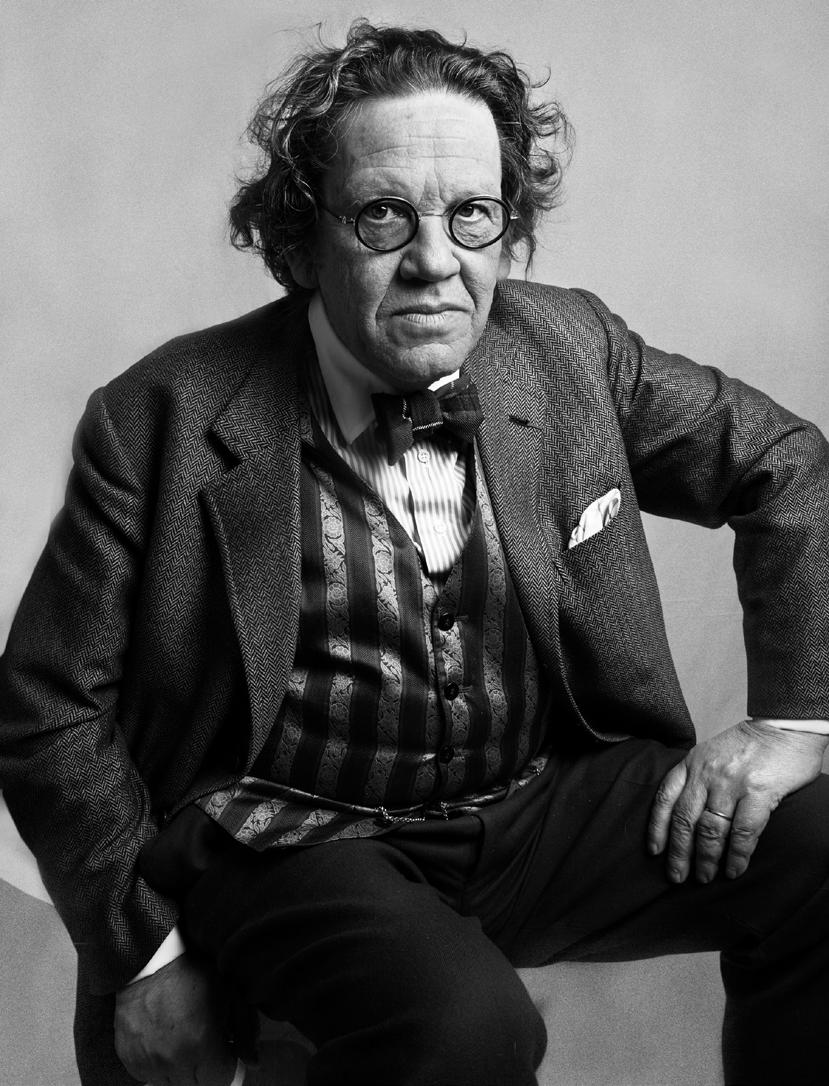
Art
At about six o’clock in the evening of October 4th, 2011, the date on which the Basilica of Sant’Ambrogio in Milan solemnly celebrated the day dedicated to St. Francis of Assisi with a procession, we heard “Cantico delle creature”, set to music by Angelo Branduardi, sung by the choir of pilgrims in procession, arriving in our art gallery located in the Piazza Sant’Ambrogio.
«Laudato si’, mi’ Signore, per sor’acqua, la quale è molto utile et humile et pretiosa et casta» [Praised be you, my Lord, through water, which is very useful and humble, priestly and chaste]. All the inhabitants of the square, including the
architect Luigi Caccia Dominioni, were looking out of the windows, just like at the Palio in Siena. At that moment my phone rang. It was Philippe: «Come immediately - he told me - it is urgent and very important, I have to introduce you to someone». If the faithful had known where I was going they would have sung: «Laudato si’ mi’ Signore, per frate marmo per lo quale ennallumini lo jorno, forte ello è bello et iocundo et robustoso et forte» [Praised be you, my Lord for brother marble for whom you brighten the day, he is beautiful, strong, happy and robust]. Presently, in Piazza Bertarelli, at the Daverio headquarters, Philippe
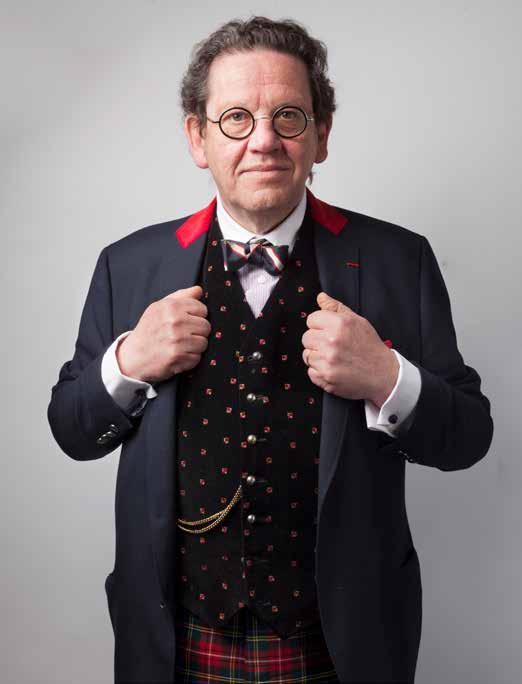
88
Art
introduced me to Paolo Carli and said to me: «I thought of you because we don’t have much time, you have to gather the troops militarily, something you know how to do. The Henraux Foundation Prize is due to open in nine months, in Querceta. Paolo is a courageous entrepreneur, he has put Henraux back on its feet, and I don’t have to explain what it is because you already know it, both as a marble lover and as a Belgian».
Fifty years ago, the then sole administrator of Henraux Erminio Cidonio had the idea of calling some of the most important artists of the time to try their hand at the marble from Altissimo: Henry Moore,
Hans Jean Arp, Joan Mirò, Marino Marini, Jacques Lipchitz and many others. They came to Querceta to “make marble”. Paolo Carli is to marble as Adriano Berengo is to glass. The latter also wanted to bring the great contemporary artists back to Murano following in the footsteps of Egidio Costantini and Peggy Guggenheim.
At this point, Paolo Carli took the floor: «We want to create an international jury for an international prize. I intend to take Erminio Cidonio’s baton and take it into the third millennium. Let’s talk about you. Do you feel like coordinating this project and creating a consensus around

89 Art
Paolo Carli, Jean Blanchaert and Philippe Daverio at Henraux
the Prize? Of course with the constant supervision of Philippe and me. We intend to celebrate the marriage between Henraux and contemporary art once again». I immediately agreed. Paolo Carli, President of the Henraux Foundation, Philippe Daverio, President of the Prize Jury and I, the General Secretary.
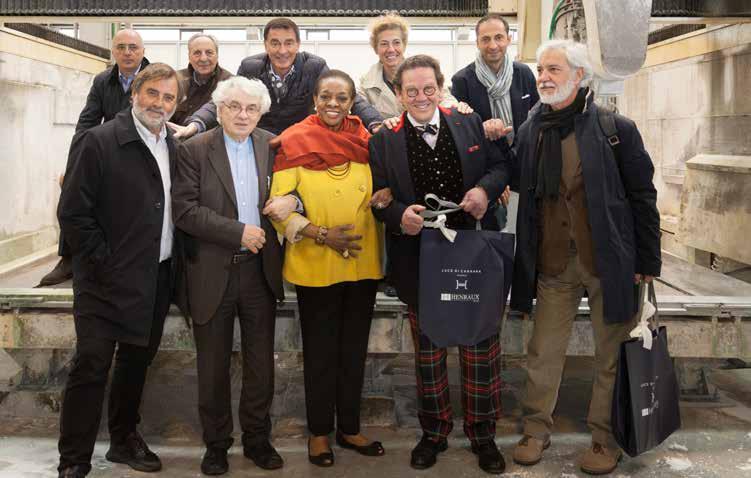
It was not an easy time for the quarries. Ecologists protested because they felt that the mountain was being excessively exploited, this was aimed mostly at the crumbling of the marble to obtain calcium carbonate for industrial uses. Philippe Daverio had clear ideas and issued an epochmaking statement to La Nazione: «Preventing the cultivation of quarries would be like preventing the cultivation of vines on the hills in Chianti. Only arguments made with primordial impulses can limit the ratio and feed certain discourses. The Apuan Alps, from Carrara to Pietrasanta, are beautiful precisely because of that ‘mystical’ snow that colours them white even in summer, making them fascinating to those who look at them. They would be less special
if they were as green as the mountains of Switzerland. The quarries have been worked for millennia and the work that revolves around the world of marble must be safeguarded. Employment and a part of the good temper linked to the anarchic drive of this territory, comes from these quarries. Let’s not confuse ecology with junk talk. There is no ecology in itself, but a relationship between man and nature, which also takes into account territorial productivity».
Henraux is an avantgarde company where robots are the heroes, but that sense of a historical, large family has not been lost. The modellers and roughers, sometimes of the third or fourth generations, are cradled in the palm of its hand. Renzo Maggi is an example of this. Son of a stonemason and father of two philosophers, he was able to look at marble with a contemporary eye without losing the ability to solely create a piece of work, even figuratively, from beginning to end by sculpting it.
In the early 1960s, Philippe Daverio was attending boarding school in Saverne, in the north of Alsace, not far from Strasbourg.
90
Above, The Henraux prize jury from 2016. Clockwise from above left: Roberto Bernabò, Aurelio Amendola, Paolo Carli, Francesca Alix Nicoli, Mikayel Ohanjanyan, Claudio Pescio, Philippe Daverio, Marva Griffin Wilshire, Mario Botta, Gianluigi Colin
Art
Right, Philippe Daverio with Paolo Carli
Over six years, Philippe Daverio and Paolo Carli formed a duo comparable to the most important men’s doubles in the history of Italian tennis: Pietrangeli and Sirola.
He studied and lived there from the age of thirteen to sixteen. He discovered that just a twenty minute walk from the school were quarries of travertine marble and natural stone from which many cathedrals in France had been built. Daverio often managed to escape to the quarries from a hole that he had dug under the fence that surrounded the religious institute and he delighted in this sea of stone. Being silent alone in the deserted quarry was one of the most important subjects of his course of study. When he met the Apuan Alps, marble was already in his heart.
It took his Daverian energy, enthusiasm and competence to break the ice, to conceive and affirm the Henraux Foundation Prize, involving great Italian and international art figures, from Mario Botta to Jan Fabre, from Christos Joachimides to Gabriella Belli. Over six years, Philippe Daverio and Paolo Carli formed a duo comparable to the most important men’s doubles in the history of Italian tennis: Pietrangeli and Sirola. Since the fourth edition, in 2018, the two-year Prize is chaired by Edoardo Bonaspetti. Edoardo, as a boy, followed the episodes
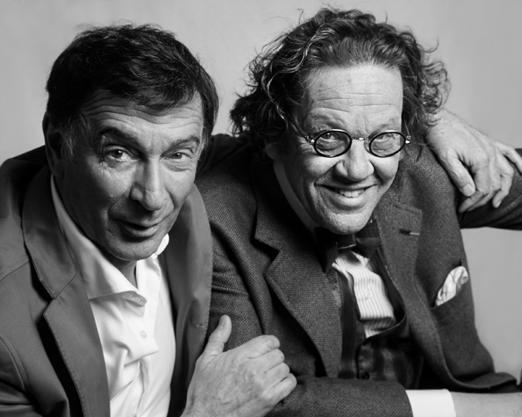
In September 2011, having landed in a helicopter with Paolo Carli on the large and immaculate Piazza Della Cava Cervaiole, on Monte Altissimo, his mind returned to the Saverne sunsets and he decided to throw himself body and soul into the adventure that was the Henraux Prize. The Italian spumante, albeit good, is to the natural stone of Alsace like the champagne of Reims to the statuary white of the Altissimo.
of “Passepartout”, a programme by Daverio on art, history and anthropology with passion on Rai 3. Today, the new president is projecting the Henraux Prize into a contemporary future, adding to that magnificent museum collection that began in the times of Erminio Cidonio and was continued by Philippe Daverio under the aegis of Paolo Carli. Since the world began, history has been written in marble. Acropoli docet.
91 Art

Design
VILLA IL GIOIELLO:
the restoration of a historic villa in Florence, between refined atmospheres and ancient intimations
CURATED BY PIERATTELLI ARCHITETTURE
PHOTOS BY NICOLA GNESI
The restoration project reinterprets an ancient residence giving it a new value: historical notions are combined with contemporary functions, including refined and elegant material compositions.
93 Design
Left, guest’s bathroom in Arabescato Altissimo marble
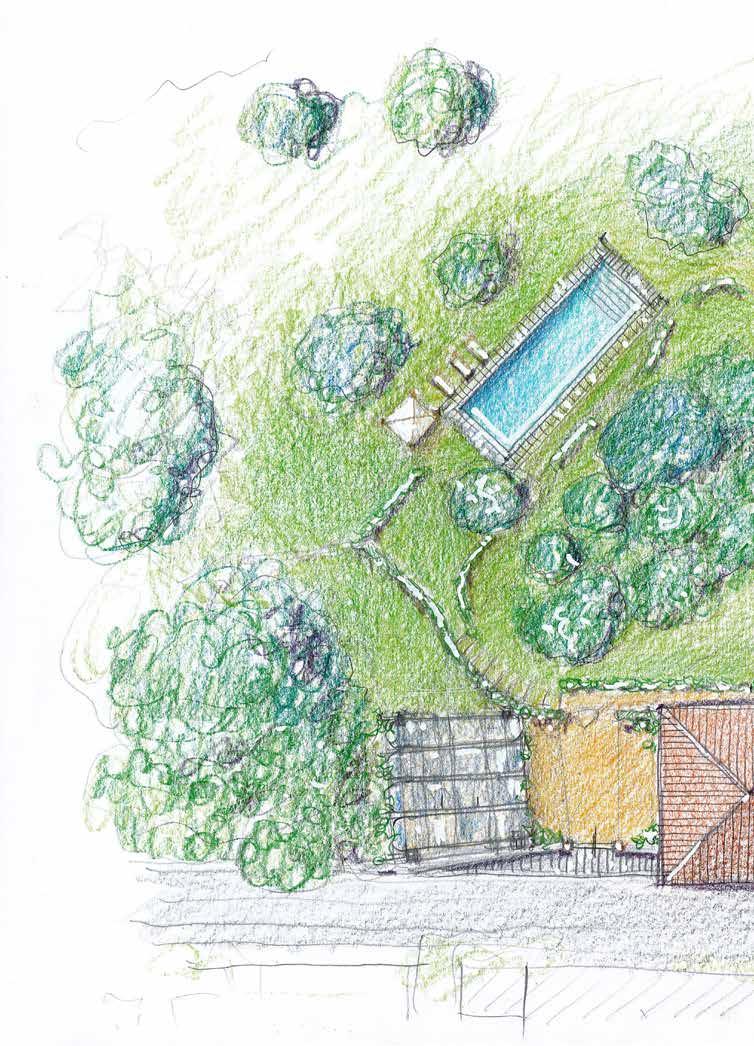
94 Design
Sketch of the exterior of Villa il Gioiello

95 Design
Among the hills around Florence and the suggestive Tuscan landscape, Villa Il Gioiello is located in one of the most exclusive areas of the city, along a narrow and winding road bordered by characteristic irregular stone walls. The building complex, located near the historic centre, belonged to the Vettori in the 1400s and 1500s: the restoration project by Pierattelli Architetture leaves its historical soul intact and gives rise to an evocative and contemporary single-family residence. The intervention of the Florentine studio renews the structure, rebuilding and restoring the original elements, and gives the interior spaces new functions. If, on the one hand, the features of the era remain visible – the external loggia overlooking the greenery, the arches and the stone
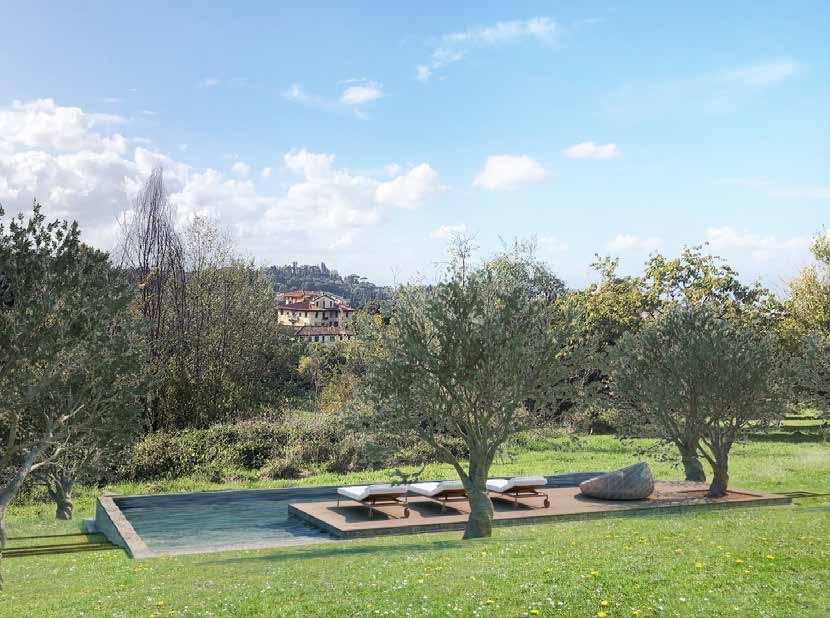
fireplace in the living room –, on the other hand, the rooms take on a new aspect through the play of surfaces and the skilful combination of natural materials such as marble, travertine and Canaletto walnut wood.
The project rediscovers and enhances the history of the environments, preserving the lived-in atmosphere thanks to a timely and accurate intervention.
The original floors and wooden beams have been reconstructed, but treated in order to keep the charm of ancient elements alive; the floor is from reclaimed Indian solid teak tiles, cleaned, but leaving still visible traces of their experience.
The inclusion of new architectural elements, contemporary and functional, alongside custom-designed furnishings by
96
External render of Villa Il Gioiello
Design
Right, guest’s bathroom in Arabescato Altissimo marble
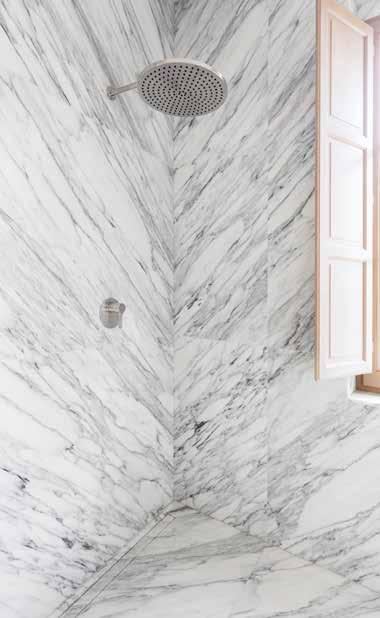
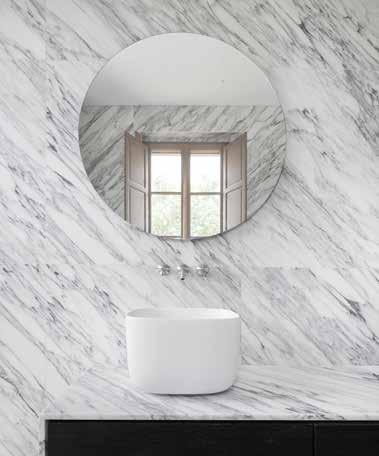
97 Design

98 Design
Vasca in marmo Verde Alpi, design Humbert & Poyet
Above and right, master bathroom in Statuary Altissimo and Verde Alpi marble
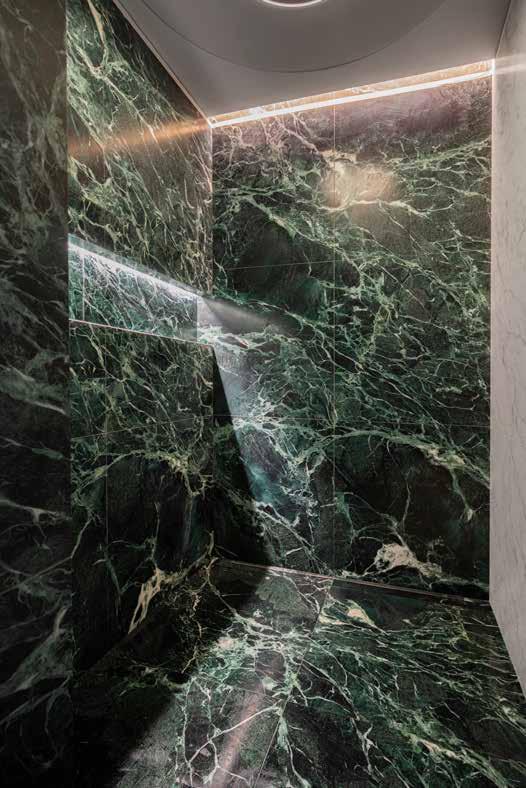
99 Design
History and signs of time, together with the enveloping presence of the landscape, define the rooms situated over five floors and a total area of 700 square meters. The spaces tell of a distant past through a sophisticated design interpretation.
the Florentine studio, creates a delicate and balanced contrast of memories, stories and encounters. The villa thus presents itself as a place of timeless charm, the sum of stylistic and historical stratifications. History and signs of the time, together with the enveloping presence of the landscape, define the rooms situated over five floors and a total area of 700 square meters. The spaces tell of a distant past through a sophisticated design interpretation. As large and airy as at the time it was built, the rooms on the ground floor host areas intended for conviviality: the living room, located in a spacious double-height hall and surmounted by a fascinating cross vault; the kitchen revisited with the warm tones of wood and refined touches of marble; the dining room, open to the outside through three arched windows, includes a corten staircase designed by the studio and built by Niva, one of the most important producers of complex staircases in the world.
Most of the furnishings are made to measure, designed by Pierattelli Architetture to integrate perfectly with the style and needs of the space. Colours, materials and shapes have been chosen following the architectural project: the restoration is developed across multiple levels, ensuring stylistic continuity capable of making the entire project unique. Handcrafted by Carimati Arredamenti, the furnishings are characterized by clean and essential lines: they fit in the interiors with refinement and measure, harmoniously interacting with the existing fixtures and architecture. Walnut wood, with its
materiality and elegance, is combined with brass finishes, which give the accessories a further touch of refinement.
The custom-designed furnishings include the boiserie in the master bedroom and the furniture in the bathroom and living room. A large geometric bookcase in Canaletto walnut was designed for the library on the first floor, with metal sides and shelves equipped with LED strips.
On the mezzanine floor, new areas dedicated to leisure have been added, such as a home cinema and a hi-fi room with furniture designed by Pierattelli Architetture. The possibilities for relaxation and well-being are extended to the basement, where there is a gym with a sauna, while the sleeping area occupies the first floor.
The evocative master bedroom, opening onto the loggia and the panorama of the Tuscan hills, is a space to discover, with hidden corners, which the new surfaces and furnishings render refined and intimate. A staircase in Canaletto walnut wood with transparent parapet and organic shapes, designed by the studio and made to measure by Niva, characterizes the environment, while the flooring is made up of recycled tiles, surrounded by an Indian teak wood frame. The attention to detail shines through in the Canaletto walnut wood paneling on the ceiling and wall, where a hidden door leads to the walk-in closet.
The attic houses the owner’s study and a guest apartment: the first is accessible from the staircase in the sleeping area, the second from the corten one in the dining
100 Design
Attic bathroom in cross-cut Travertino Romano
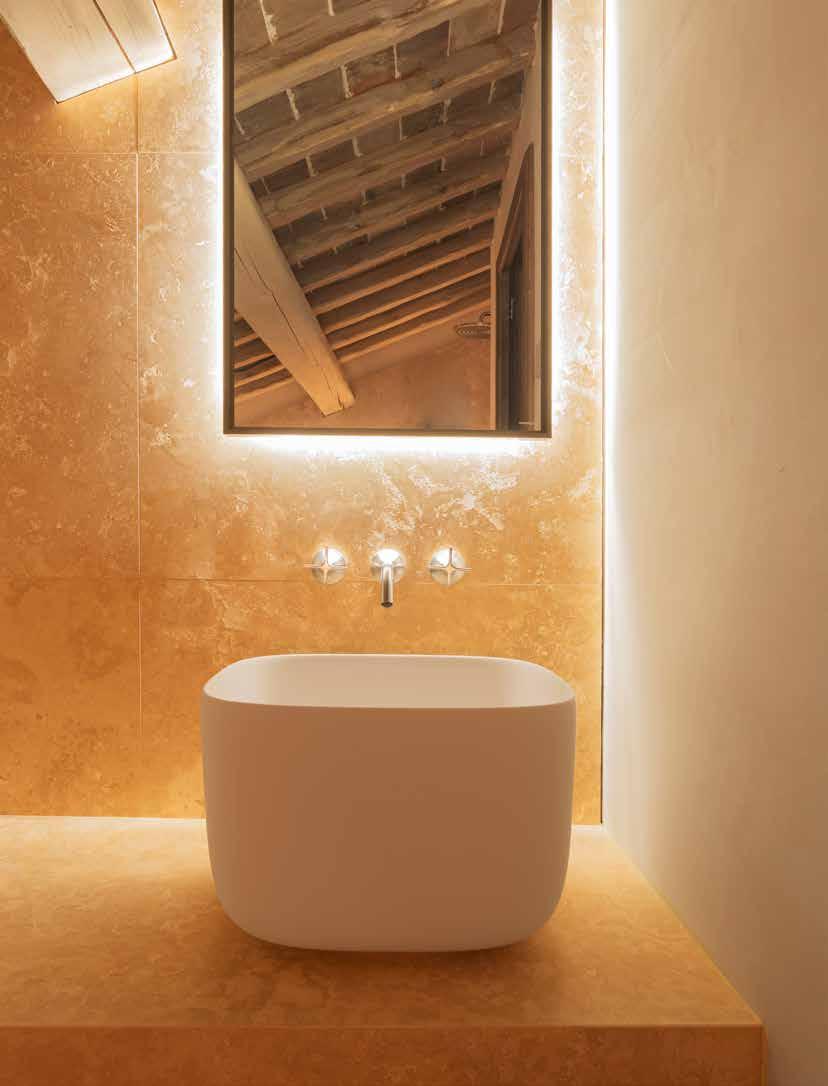
room. Equipped with a bedroom with zenithal light, bathroom and living area, the space for guests was created with the construction of a new pass-through attic which allowed an increase in the surface of the villa.
Pierattelli Architetture has dedicated the utmost attention to the design of the bathrooms, which become welcoming places, with modern and luxurious features.
The master bathroom on the first floor is embellished with a two-tone coating: the chromatic contrast of the slightly veined Statuario Altissimo del Monte Altissimo marble and the Verde Alpi marble gives rise to a unique, unexpected and sophisticated environment.
The warm tone of Canaletto walnut and the reflective brass emphasize the welcoming atmosphere. The shower, designed by Michael Neumayr for Dornbracht, is equipped with the Aquamoon system, which produces four modes of water jets alongside scent emissions, offering a multisensory experience.
Marble is the protagonist of all the bathrooms in the villa. Travertine marble was chosen for both the cinema bathroom and the attic bathroom: in the first with a vertical grain counter-pitch, in the second Nuvolato travertine cut into the pitch.
A candid white Arabescato Altissimo marble, characterized by its strong veins, defines the service bathrooms and those of the children on the first floor. An ancient material with timeless elegance, the marble used for the villa is signed by Luce di Carrara.
Marble fits into the spaces designed by the Florentine studio with versatility and elegance. A material, but also a language that distinguishes the project: a unicum from which new and personal solutions are developed. Pierattelli Architetture has chosen Luce di Carrara marble for the preciousness of the materials and the Made in Italy quality of the products, as well as for the brand’s ability to create customized and tailor-made solutions. Regarding the furnishings and accessories, Vaia taps by Dornbracht, furniture and mirrors by Antonio Lupi, the Sfera Newflush bathroom fixtures by Catalano and the radiators by Tubes were chosen. The soft and enveloping shapes of Bull, Urnamood and Poggio designed by Antonio Lupi have been included for the washbasins.
The garden has been redesigned and extended. Some trees have been replaced and the hedge that was initially located near the villa has been moved and lowered with the collaboration of a landscape architect and a carport has been built.
102 Design
Above, cinema bathroom in vein-cut Travertino Romano
Below, attic bathroom in cross-cut Travertino Romano
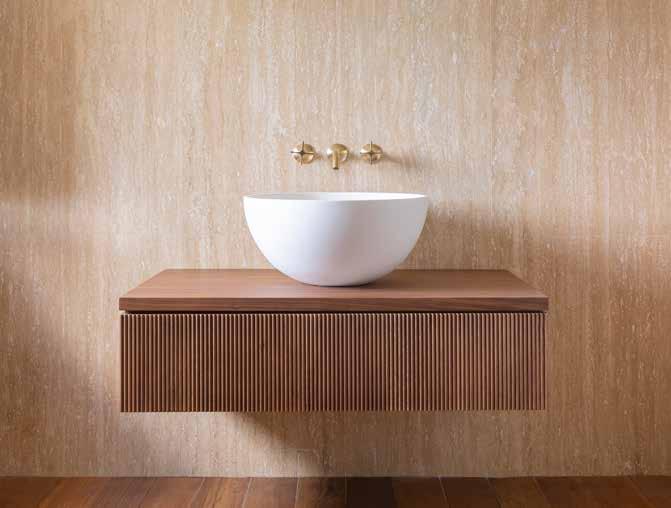

Design
TO SCULPT. NEW TECHNOLOGIES FOR STONE SCULPTURE IN APUO-VERSILIAN WORKSHOPS
BY VALENTINA FOGHER PHOTOS FROM FOGHER ARCHIVE
As a preview for “Marmo”, an excerpt from the new book by Valentina Fogher. Central to the extract is the evolution of the roles of artist and craftsman, following increasingly progressive automation: through the use of robots, the sculptor also becomes a designer and the craftsman “digitizes” himself to become an expert in mechanics.

104 Art
Anthropomorphic arm in Stagetti Studio, Pietrasanta
(*)

Art

106 Art
Sculptural activity in Versilia has become more and more lively since the early 1900s with the opening of numerous workshops for the processing of marble and the consequent specialisation of the craftsmen, who dedicated themselves in particular to classical figurative statuary. This sector was at a certain point marked by a particular episode: the arrival of Henry Moore at the Henraux company in Querceta for the creation of “Reclining Figure” in 1956, for the UNESCO headquarters in Paris. The transformational work of this sculpture gave rise to prominent international productions of contemporary marble sculpture: since then, the Apuan-Versilian area has become a favourite destination for many artists from all over the world. In this way, a complete revaluation of marble occurred in the field of sculpture and this led to the creation of some specialized workshops dedicated almost exclusively to contemporary sculpture, with the consequent investment in the appropriate equipment.
Most of the tools used today in stone carving are the same as those used by the Egyptians onwards – tip, cinder, step, drill, bush hammer, rasp, file – and various abrasives, such as sand, pumice stone or emery as was preferred by the Greeks. The collaboration between the artist and the craftsman entrusted with the execution of the sculpture, became fundamental over the centuries, from the first idea, the possible creation of the sketch in clay or wax to the final finish. It is exactly in this area in which there has been a continuous and progressive evolution of stone processing techniques, especially through the introduction of automated systems, that has been perfected thanks to computers and robotics. The artisan workshops of Carrara, Massa, Seravezza and Pietrasanta have always competed in the use of ingenuity for the completion of their works. At the time of their most intense production, at the turn of the 1800s and 1900s, some of these studios could even employ over a hundred craftsmen, each
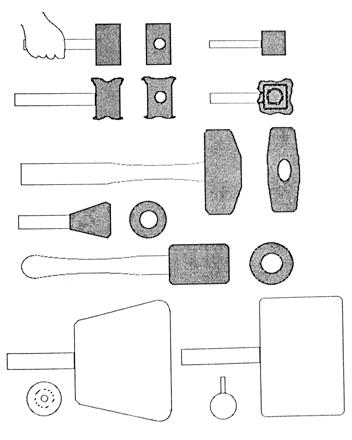
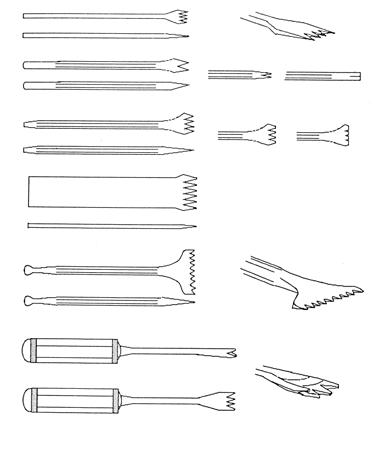
107 Art
Illustrations of tools
dedicated to their own distinct tasks. And through the evolution of work, more and more specific machinery was gradually introduced, to assist the craftsman in their duties.
As a result, the adoption of the so-called “automation” was decisive for sculpture, considered as the set of techniques and methods to replace or reduce human intervention in a work activity. This, applied to stone sculptural processing, is divided into the sector of numerical control machines, which from the roughing of the block can arrive at the quasi-finishing of a piece, and that of robotics, through the use of anthropomorphic arms.
Numerical control machines (CNC or computer numerical control) are machine tools, managed by an integrated computer, which directs their movements and controls the functions according to a pre-set work program. Anthropomorphic robots, on the other hand, are part of the larger family of industrial robots, which according to the ISO TR / 8373-2.3 standard are defined as «manipulators with multiple degrees of freedom, automatically governed, reprogrammable, multipurpose, which can be mobile, or installed on-site for use in industrial automation applications».
Consequently, the machine tool manufacturers have adapted to the stone sector, modifying the equipment at request. The craftsmanship of traditional labour in marble processing is thus becoming craftsmanship of the digital age: the machine is a mechanical extension of the craftsman’s arm, which is now paired with new technologies. This involves the complicated work of understanding which activities the robot can perform because the machine must be constantly
controlled and programmed according to the cut and veining of the marble block, applying suitable cutters or tips, to be replaced before wear. On the other hand, anthropomorphic robots are characterized by very high automation, so that their control and structure allow considerable mechanical flexibility and guarantee the coverage of areas of the surrounding space that cannot be reached by other types of machines: they are able to reach one exact point with different configurations of the axes and also to maintain high levels of precision and repeatability, resulting in a sculpture completed to almost 90% of its final execution. The finishing work, on the other hand, is still manual, because at that point, the human hand, given the variety of tools to be used, is more skilled and refined than the machine. Most artists willingly adapt to the “evolution” of their trusted craftsmen, also because the speed of execution of the work of the robots greatly contributes to lowering labour costs and reducing production times. As Adolfo Wildt teaches us in his “The art of marble”1, most artists entrust the creation of their sculptures to the artisans, if not in full, at least for the first sequences of the processing, that is, those of roughing and punctuation, which are generally very tiring and take away precious time, for those in a full creative streak. On the other hand, the craftsmen have understood that they themselves can rely on machines to reduce fatigue, shorten processing times, improve productivity and avoid possible human errors. On the other hand, this also involves a high investment for the initial cost of the machines, with related maintenance problems and greater basic preparation.
108 Art
The craftsmanship of traditional labour in marble processing is thus becoming craftsmanship of the digital age: the machine is a mechanical extension of the craftsman’s arm, which is now paired with new technologies.
3d file of a sculpture

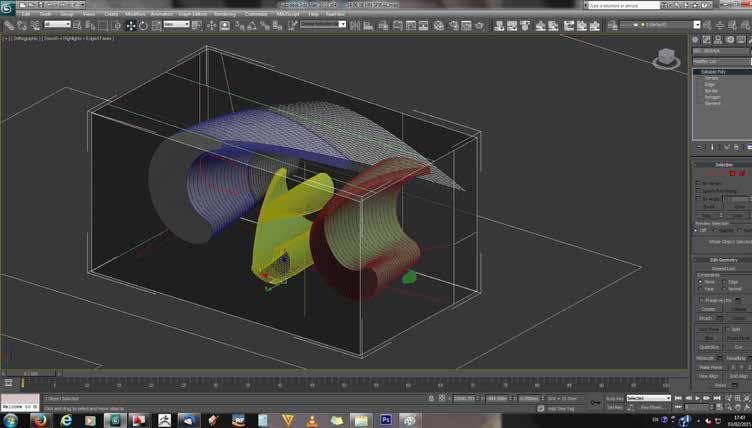
109 Art

Art
This meant that the traditional figure of the rougher has been instead replaced by that of a computer operator, who through new software is able to program and control the computers integrated into the machines themselves. This transition was in some cases traumatic and in others, it led to a stage of advancement. If many artisan studios have found themselves closing down, because they are unable to keep their staff, in others, automation has generated greater independence and intergenerational family management.
The most innovative artists have even gone so far as to learn how to create their sketches on computers themselves, and then print them with 3D printers or send the files directly to the workshop, in a purely “objective” way, from the artist to the machine, without any intermediate stages of external manipulation.
The image of the craftsman, in his traditional meaning, is destined to slowly disappear, and with him, all his generational knowledge and experience.
In his evolution, the craftsman has “digitized” himself, he has become a programmer, an expert primarily in software, electronics and mechanics. Putting the performative abilities of software and robots to the test more and more has meant that even the sculpture itself surpasses new goals every day, leading to an emerging development of research in the technological field at the service of creativity, in a constant challenge between man and machine, and thus generating an investment for future generations of artists and “employees” of sculpture, in which this will no longer be synonymous with heaviness and majesty, but also with lightness and adaptability. After all, the chisel and the anthropomorphic arm are both just tools. As Marshall McLuhan put it: «Every invention or technology is an extension or a self-amputation of our physical bodies [...] this extension requires new proportions or new balances between other organs and body extensions2».
NOTES
(*) Upcoming volume for Pacini Editore, Pisa.
1 A. Wildt, “L’arte del marmo”, Ulrico Hoepli Editore, Milano 1922, II ed., pp. 8-10 [
2 M. Mc Luhan, “Gli strumenti del comunicare”, Il Saggiatore, Milano 1967, p. 9 [Understanding Media: The Extensions of Man, Gingko Press, Berkeley 1964].
111 Art
The latest generation tools of an anthropomorphic arm

Architecture
MICHELUCCI, MARBLE AND DYNAMIC SPACE
BY CHIARA BEVILACQUA PHOTOS BY NICOLA GNESI
The author sketches a portrait of one of the most important designers of the twentieth century: whose solitary and eclectic character (in addition to being an architect and urban planner, he was also a considerable engraver) allowed him to develop a personal voice and prevented his work from being assimilated and assimilable to particular trends.
113 Architecture
The
On the following page, a detail of a mosaic on a wall
exterior of the San Giovanni Battista “dell’Autostrada” church.
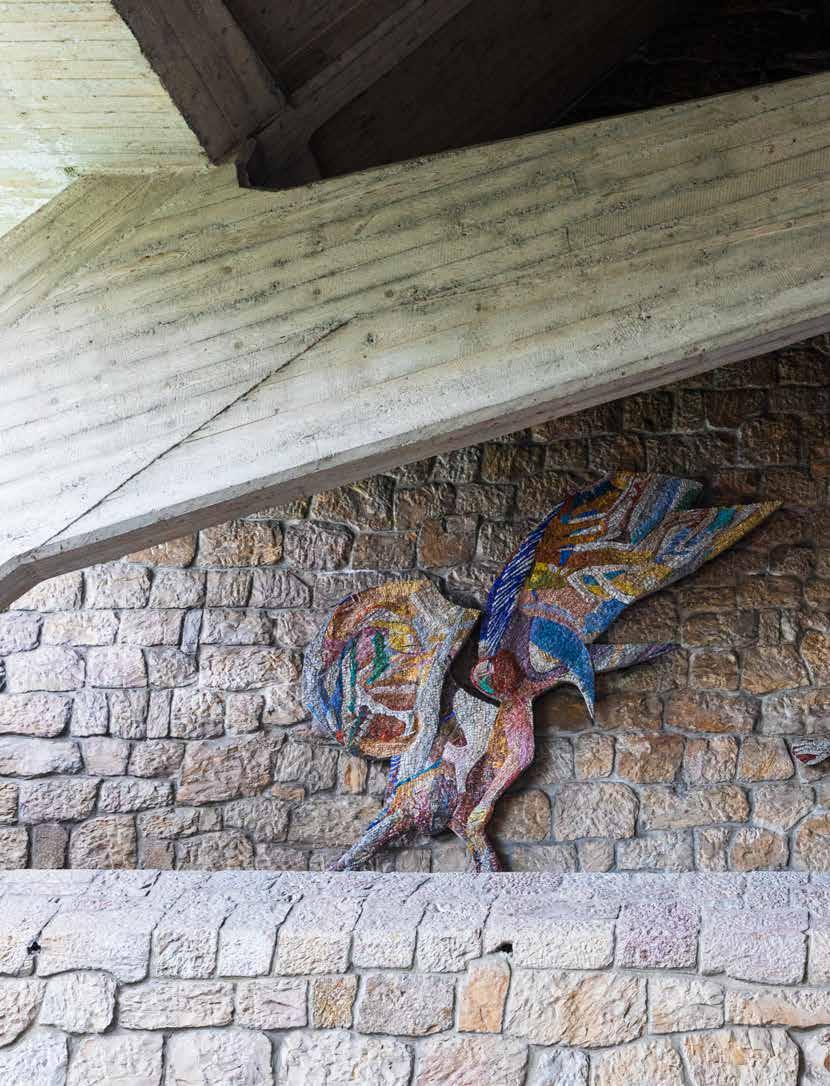
Architecture
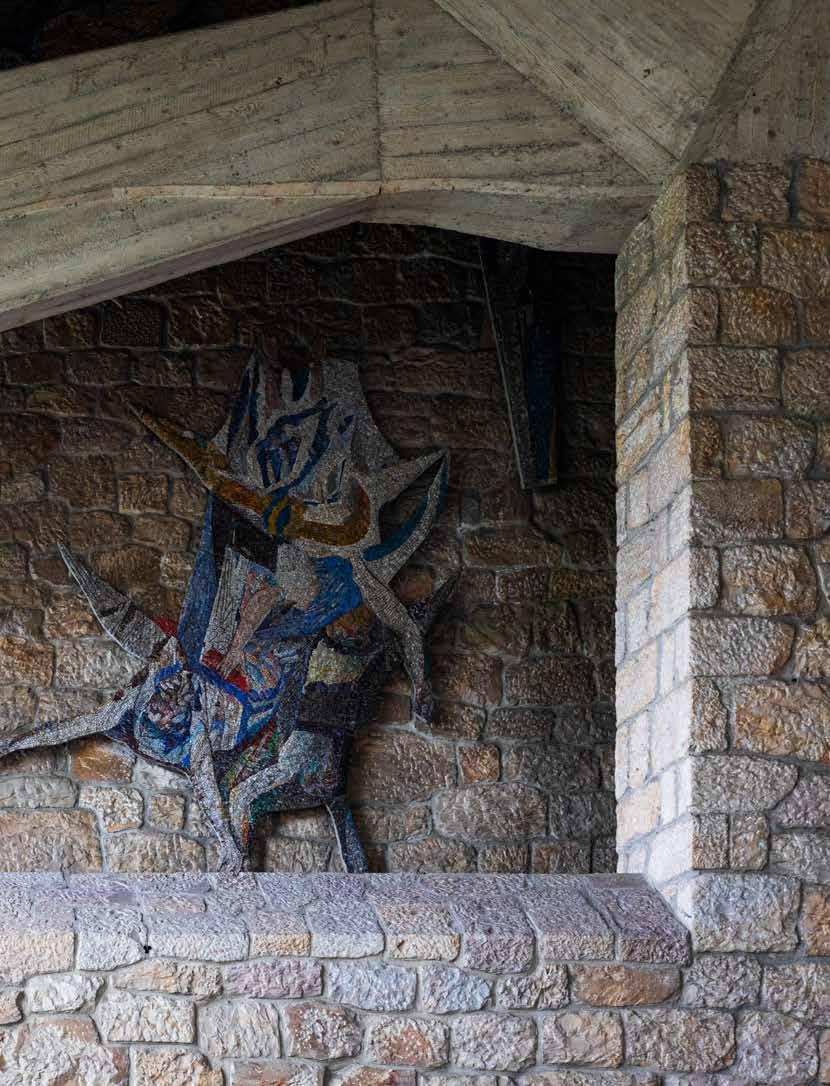
Architecture
For Michelucci, architecture is not the manifestation of the individuality and skill of the designer but rather a consequence of the collaboration of professionals and experiences linked by a common goal: the construction of space on a human scale.
Giovanni Michelucci (Pistoia, January 2nd, 1891 – Florence, December 31st, 1990) is one of the greatest architects of the twentieth century. He taught in the Faculty of Architecture at the University of Florence for many years and for some time in the Faculty of Engineering at the University of Bologna. Forming the basis of Michelucci’s experience there was an artisan tradition gained in the foundry of his paternal grandfather which allowed him to learn processing techniques such as turning and shaping, in addition to attention to detail and finishing. He was born in the century that saw a wide diffusion of steel, a material of which he appreciated the versatility. Michelucci assiduously follows the construction sites where he observes and learns, moved by a desire to enter the construction process and to establish a direct relationship with the workers. The architect carefully reflects on the constructive aspects of architecture, fixing them in expert photographic shots during his travels. For Michelucci, architecture is not the manifestation of the individuality and skill of the designer but rather a consequence of the collaboration of professionals and experiences linked by a common goal: the construction of space on a human scale. He shows a natural inclination to break down a work to understand the secrets of construction and technical details. However, Michelucci does not only look at the detail:
he, in fact, meticulously reflects on the dynamics of “city-architecture” in order to highlight the importance of the complete integration of what has been built with the natural environment. He adopts the formal and constructive logic of architectures seen and studied, not to replicate them, but to assimilate the constitutive mechanisms and rework them through an original and completely personal compositional action. Most especially in Michelucci’s latter work, it is possible to trace an exemplary fusion between the conception of space, structure and form that eliminates the boundaries between inside and outside. In Michelucci’s vision, space is conceived in a dynamic sense. In fact, it becomes the “space of life”, that is, the only space capable of creating a real connection with man. By enclosing everything in the human dimension, the concept of the city according to the architect is also easily defined: he loved to define the city as history in constant evolution, the result of stories and traditions deriving from particular relationships that over time have created its structure, substance and essence. The city becomes changeable, resolved every day through the lives of its inhabitants, capable of retaining its singularity over time even despite the inevitable change.
Undoubtedly the project for the Church of San Giovanni Battista “dell’Autostrada” is of great importance. Halfway between
116 Architecture
The interior of the church Photo Henraux Archive

Architecture
Michelucci breaks down the “walled box”, interpreted as an obstacle to the continuous change of space and the flow of life and identifies a predominant architectural value in the system of paths.
Milan and Rome, where the Autostrada del Sole meets the Firenze-Mare motorway, the node where the church was built, commemorates more than one hundred workers who died during the construction of that great public work.
In 1958 the task is entrusted to Lamberto Stoppa but some controversies come to light that arouse oppositions and reservations to his project. As a result, the proposal is made to Michelucci, who after several doubts accepts. The first sketches date back to 1960 and the concept on which Michelucci bases his proposal is made clear in his own words: «The structural concept that inspired me is simple, it seems to me, and I made it clear in the first sketch I made: a curtain carried by sticks 1»…
The theme of a curtain derives from biblical archetypes even if the architect pursues and bases his work mainly on an idea of space. Michelucci clarifies the genesis of the project that develops from the internal towards the external: «A tent, a tent of the Bedouins or Israelites in the desert that can analogically signify transit and not the definitive abode of men on earth. I say can, because this form is a result and not a premise. I did not start from the idea of a curtain and then subject the internal structure to it, but the shape began to take shape as a result of the internal fabric2». Recurring themes are found in many of the
architect’s projects: the path and the curtain become cornerstones of Michelucci’s compositions. They are religious symbols, they recall the transience of man’s life and his temporary passage on earth in transit towards God, they are also a metaphor for a humanity devoted to nomadism, in search of cultural stimuli and improved living conditions. Freed from the traditional concept of building, Michelucci breaks down the “walled box”, interpreted as an obstacle to the continuous change of space and the flow of life and identifies a predominant architectural value in the system of paths. Space becomes a path, architecture becomes a spatial experience over time. By December 1960, the drawings for the church finalised the project, consolidating its definitive layout. In the study of the paths, there are no prevailing directions over others: it is a building whose image is complete from any perspective one observes it. It is an organism that focuses the space and the landscape, attracting the faithful in a perception that cancels any typical perspective progressions. In this project the traditional constructive hierarchies have been abandoned; in fact, there are no distinctions between walls and roof, between loadbearing structures and supported elements; the distinct succession of the facades – front, back and sides – is no longer evident and also the separation
118 Architecture
between inside and outside tends to fade. The curtain does not have a unique shape; it is a consequence of the nature and development of the supports. There is no distinction between the base and the roof or between the facade and the secondary fronts. The roof at the highest level is linked to the main beam, while on the other side it rests on the concrete trusses set on the wall that delimits the wedding chapel. Michelucci has strong links to the environments of the Apuan quarries. There are numerous drawings that confirm the presence of the architect in the quarries in order to choose marble to be used for his works: some drawings dating back to May 1972 see him involved in the design of a Michelangelo Memorial on the Apuan Alps, a work that has never been built and is still only preserved through preparatory sketches and a plaster reconstruction made by Bruno Sacchi and “Studio Forte 63”, kept at the Michelucci Foundation in Fiesole. Furthermore, his collaboration with Henry Moore in the realization of the memorial project on the Apuan Alps and numerous photos of the Church of San Giovanni Battista in the photographic archive of Henraux S.p.A., suggest a direct collaboration with the latter.
It is also possible to find the themes so dear to Michelucci within the project of the memorial to be erected on the Apuan Alps,
dedicated to Michelangelo on the occasion of the fifth centenary of his birth, and they are also present in the project of the Church of San Giovanni Battista. Again the tent, the paths and the elimination of any boundaries between inside and outside, between the natural and the built. Architecture becomes a powerful means through which the designer, in collaboration with the builders, must express their values. In the projects of the first “Michellucian” phase, which mainly concern the 1950s, the relationship with the context plays a predominant role, an aspect that will remain dense even in subsequent projects where each element is structured according to the place of location. His great ability to choose materials in relation to the place and the use of construction techniques that aim at respecting the past tradition is also essential.
In Michelucci the important and continuous search for the archetype emerges. A recurring theme of the tent, found in many of his sketches and created in the Church “dell’Autostrada”: a theme that recalls a sinuosity that has been achieved through the use of materials often considered limiting in creating certain shapes, as well as clear references and search for continuity with softness often only transmitted by the perfection of natural elements. Worthy of note is the archetype of the dendriform pillar that Michelucci uses in the
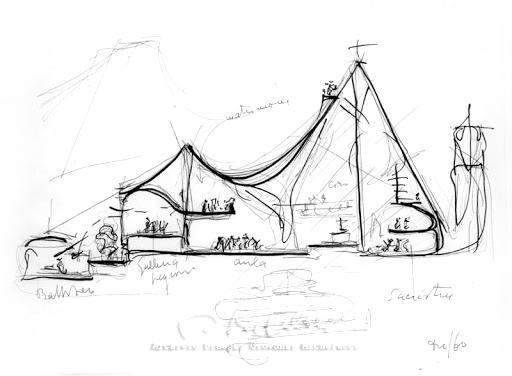
119 Architecture
A sketch of the San Giovanni Battista church
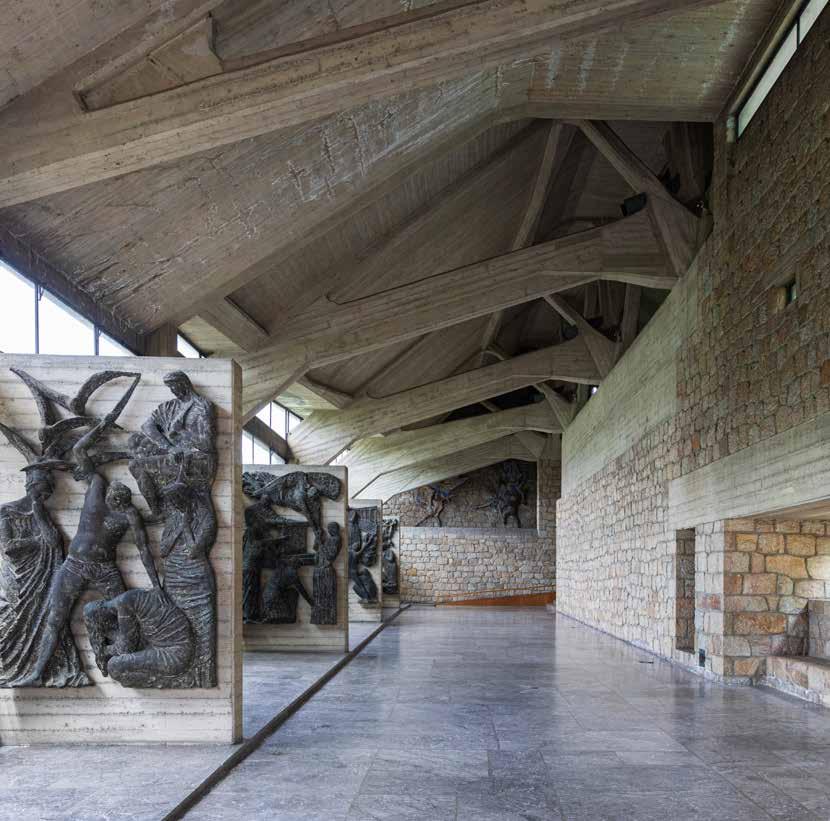
Architecture A view of the interior of the church
Church “dell’Autostrada” to support the magnificent sail roof which also performs an evocative function recalling nature and its leading role in the architect’s unified thoughts. At the basis of the ideas of the elder Michelucci there is the certainty of the complexity and universality of nature, whose laws are safe for him. Nature becomes the backbone of his projects, entering his creative spirit with ever greater intensity. It is not simply what surrounds us and which offers us landscapes and scenarios of great beauty, but rather an indispensable stimulus for human action that allows for a necessary orientation: «... Nature is what, entering into us, triggers such an evolution such that we realise that everything is wrong».3 Michelucci maintains the importance of adhering to the earth and of finding inspiration in the earth without seeking – through architecture – those “heights” that would always be at a disadvantage compared to the majesty of nature. A particularly strong concept in the study for the Michelangelo Memorial. He goes several times to the Apuan Alps to experience those sensations that he will then be able to express in his projects. An attentive observer, he captures in photographic shots what strikes him about the places he visits in search of the “voices” of the quarries: «I travelled
coasts and ridges to realise the points of view, but also to have precise sensations in relation to things both nearby and far away. At a certain point you have a quarry, a large quarry, opposite, where you can see the work. Then one feels that work, real work (you see people moving, you hear the blows of the bat) has a precise function and physiognomy: and in the face of this, let’s say intellectual work can appear, here, out of place and out of range. You carry around an object that seems important to you, and here it is false (…). And this happens because here we change ourselves, we strip ourselves of many things. Here there are forms: forms that astound (…). My discourse is therefore to adhere to the earth and to find in the earth the reasons for a poetic fact, to descend there with these forms, with these paths. It is useless to seek heights up here; you can never compete with this world: you don’t do it; it would look bad4».
This design attitude favours that the extension of space, the premise of the late Renaissance composition, through a spatial fluidity and through the presence of contrasting elements such as the supports of a curtain that opens to accommodate a landscape that is impossible to delimit neither from a physical point of view nor from a cultural or mental one.
NOTES
1 F. Borsi: “Giovanni Michelucci, interview”, Firenze 1966.
2 G. Michelucci, in «Chiesa dell’Autostrada del Sole “San Giovanni Battista”», edited by E. Pierattoni, Idest, Campi Bisenzio 2003, p. 26.
3 G. Michelucci, interview by M. Lupano, Conversation with Giovanni Michelucci, in “Domus”, 720 (1990), p. 24.
4 G. Michelucci, in P.C. Santini, “The last Michelucci and an idea for Michelangelo”, in “Ottagono”, IX, 34 (1974), p. 103.
121 Architecture
STONE SELECTION AND APPLICATION IN THE DESIGN OF 300 COLORADO, AUSTIN, TEXAS
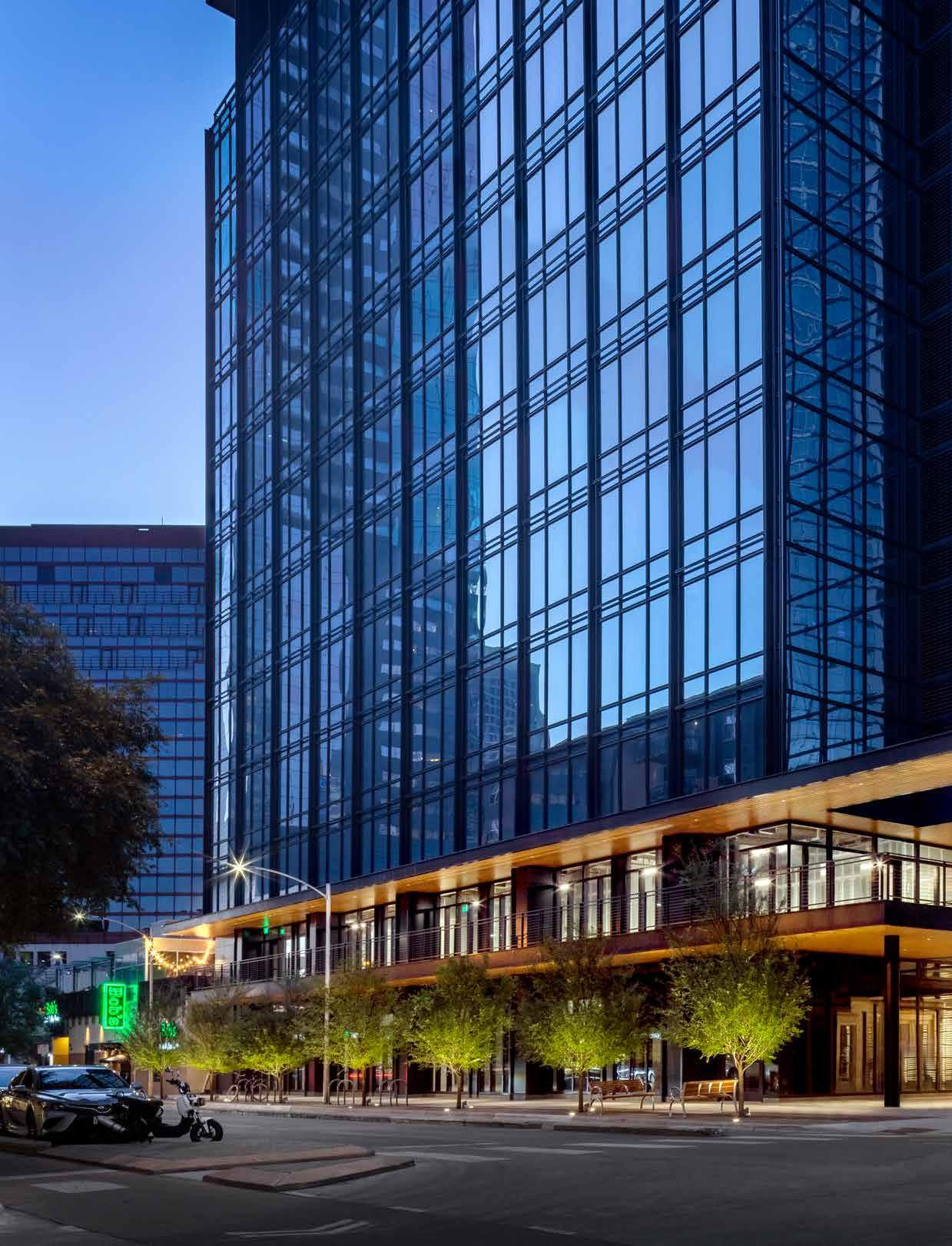 BY PICKARD CHILTON
BY PICKARD CHILTON
The participation of the Pickard Chilton studio in the city of Austin for the construction of the “300 Colorado” building is characterized by a great deal of attention to details. Especially in the choice of materials, which combines quality, functionality and beauty of the spaces. For this, the Italian marble, and that of Henraux in particular, seemed the most natural choice.
Architecture

Architecture
External view of the “300 Colorado” Building in Austin, Texas
Pickard Chilton understood that the building needed to distinguish itself not only in the quality of its architecture and amenities, but in the beauty of its lobby.
Pickard Chilton has a long and distinguished history of collaborating with Cousins Properties that dates back to one of our first projects, The Pinnacle, a 41,800 m2, 22-story office tower in Atlanta, Georgia. Considered by Cousins to be a “signature” building in their portfolio, The Pinnacle’s interior finishes had to convey the caliber of the exterior architecture. The welcoming lobby is finished in Fior di Pesco Carnico marble which also extends into the elevator cabs.
If there is one constant that runs through the Cousins’ impressive portfolio of projects it is their long standing respect for the value of natural stone and what it brings to each of their projects: inherent beauty, timelessness, and an ability to convey a sense of elegance and durability.
Until recently, Pickard Chilton had worked primarily with Cousins’ in Atlanta, Georgia.
In 2017, the firm was commissioned by Tim Hendricks, Senior Vice President and Managing Director of Cousins’ Austin office, to design “300 Colorado”, a new 32-story, 132-meter tower comprising 17 floors of Class A office space atop a 13-story parking podium.
In a very heated and highly competitive office development market, “300 Colorado” was Pickard Chilton’s first foray into this dynamic city and understood that the building needed to distinguish itself not only in the quality of its architecture and amenities, but in the beauty of its lobby. Offering the building’s first impression, the
lobby itself would come to be representative of the tenants that would ultimately occupy the office tower.
At the initiation of the project, it was immediately apparent that Mr. Hendricks and Jon Pickard both had an appreciation for the integration of natural stone and, more specifically, Italian stone. In discussing preliminary concepts for the lobby, both agreed on the desire for a timeless stone to define the primary character of the lobby.
Mr. Hendricks, with nearly three decades of development experience, enjoys an extensive history working closely with stone supplier Henraux, specifically Paolo Carli. The project team’s deep knowledge of stone, finishes and applications allowed for informed yet timely decision making in terms of stone selections.
“300 Colorado”’s design includes a complimentary mix of stone for the main lobby floor, walls and accent features. In August of 2019, Mr. Hendricks and Mr. Pickard collaborated with the Henraux team in selecting beautiful stone that met their design aspirations.
For the main lobby interior walls, Italian Roman Travertine was selected for its timelessness, natural beauty, and strong horizontal vein character. This material has a strong historical precedent to past iconic architectural monuments in Rome such as the Colosseum, St. Peter’s Basilica, and the Trevi Fountain. One key challenge the design team and Henraux met with this material included wrapping a consistent
124 Architecture
View of the building’s hall
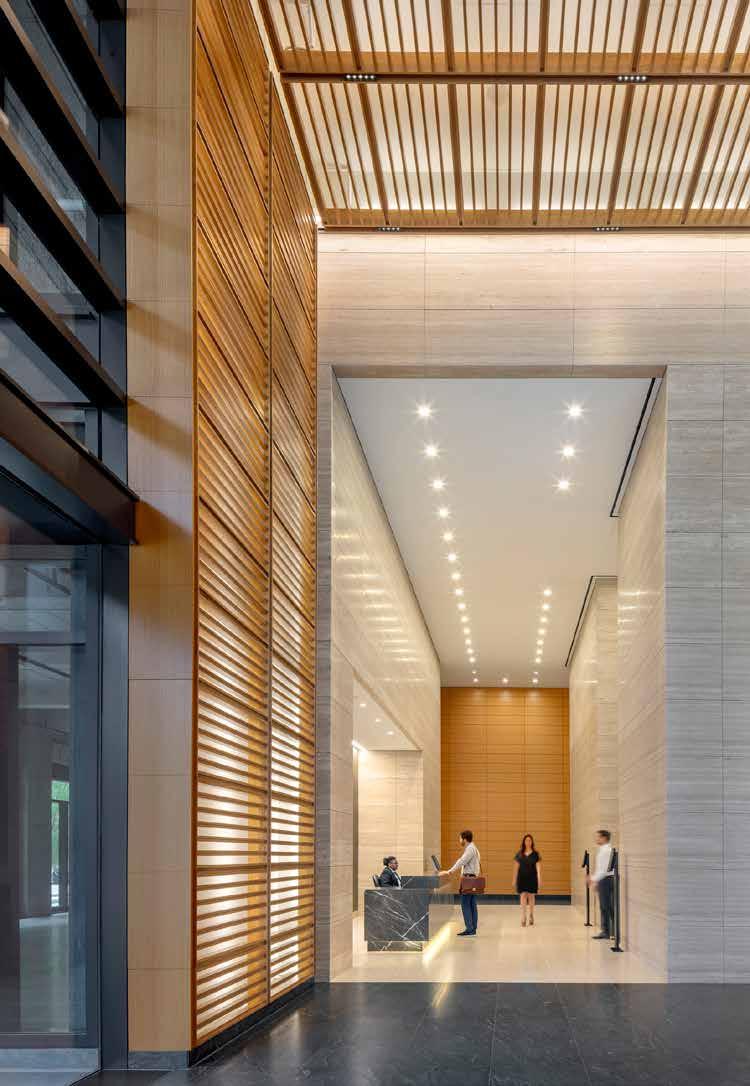
Architecture

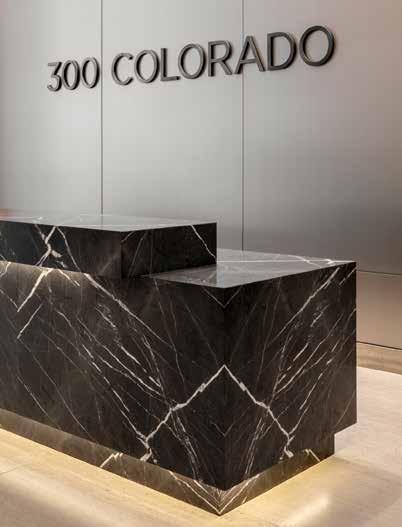
126
desk Architecture
The reception
Henraux took extreme care and paid close attention to the detailing of the desk by preparing for the design team a fully mocked-up desk for review during a trip to Henraux in Italy in October of 2019.
horizontal vein across multiple faces of the lobby and up the full 6,7 meter-high lobby walls. This horizontal pattern was further accentuated by an expressed horizontal rabbet reveal joint. Vertical stone joints were simple butt joints.
Jet Mist granite from the United States was selected as the main stone for the lobby floor. This particular stone was chosen for its color, durability and elegance. The crosscut nature of this stone highlighted the dark background with gentle white veining interspersed throughout the floor pavers. It set a strong complementary base for the wall’s light earth toned Roman Travertine. The tower elevator lobby floor area is accented with vein cut Jesenice limestone from Italy. The light colored stone provides a contrast to the adjacent Jet Mist granite, offering a visual clue to the use change in the space for occupants.
As the centerpiece of the lobby, the main reception desk unites Henraux craftmanship to beautiful stone. Crafted of Graphite marble from Italy, this stone features a strongly contrasting crosscut veining with a soft leather finish. The form of the desk comes alive with vein-matched outside corners creating the look of being carved from a single solid block of marble – yet it is crafted of 2 cm thick material. Henraux took extreme care and paid close attention to the detailing of the desk by preparing for the design team a fully mocked-up desk for review during a trip to Henraux in Italy in October of 2019. The mock-up, based on design sketches by Jon Pickard, confirmed for the team that the desired vein
matching across all faces of the desk was attainableand elegant in its built form. During this stone viewing trip, Henraux also prepared extensive dry lays of all the project stones for “300 Colorado”’s lobby wall, floor and feature reception desk. In collaboration with Henraux, ISCS SA Stone Consultants’ Raoul Luciani provided his expertise in blending and coordinating the dry lay procedures throughout stone fabrication to carry out the design intent communicated by Pickard Chilton and Cousins.
Astra Gray marble from Italy with a honed finish was used in the restroom vanities. This stone was selected for its cool gray complimentary color which blended well with the balance and tonalities of the bathroom finishes.
During their time at Henraux, Tim Hendricks and Jon Pickard warmly reflected on a pair of Versilys marble entrance door pulls at the entrance to the Luce di Carrara showroom at Henraux, Lucca, Italy. In recognition of the years of friendship between the companies, Mr. Hendricks and Mr. Pickard decided to model similar Versilys marble accents for the lobby entry door pulls at “300 Colorado”. Furthermore, in homage to Henraux, they elected to engrave a “HX 1821” logo onto the door pull, in addition to the building’s name.
“300 Colorado”’s recent completion will now allow tenants and visitors alike to access and appreciate the details of its highly crafted lobby – a showcase of the versatility and elegance of stone.
127 Architecture
PHOTOGRAPHY AS A LANGUAGE OF VISION AND A SENTIMENT OF TIME
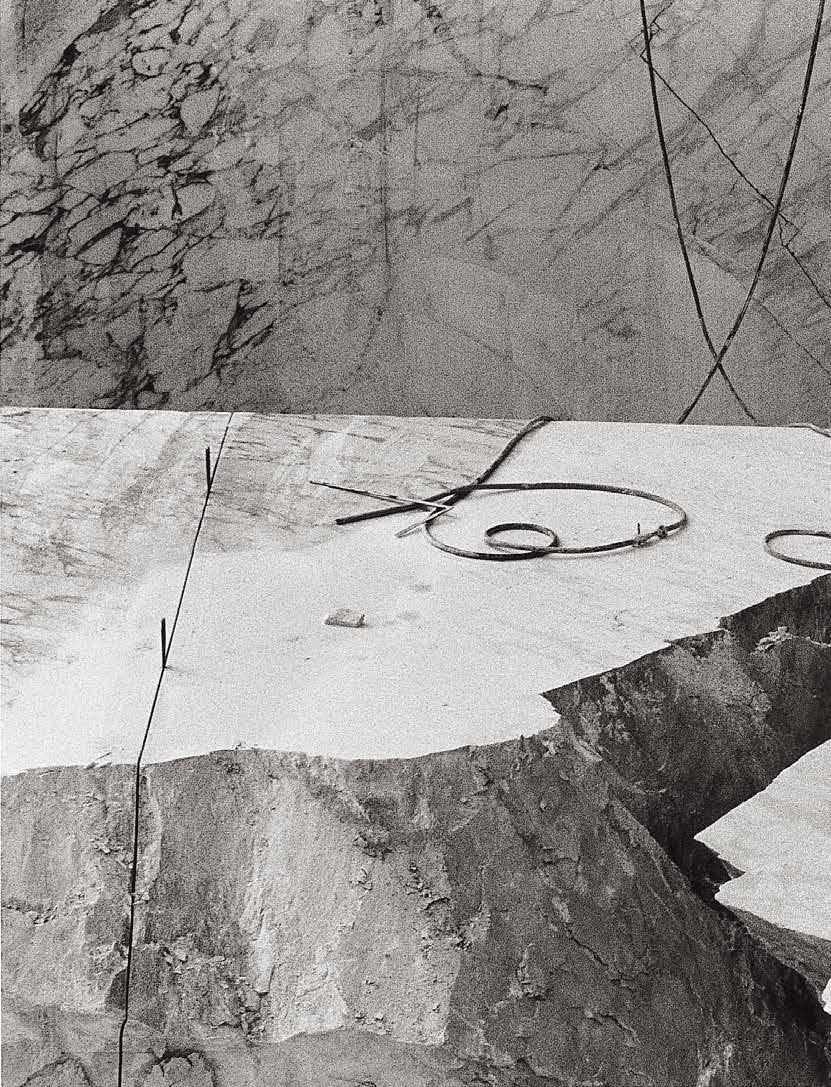 BY COSTANTINO PAOLICCHI PHOTOS BY GIOVANNI UMICINI
BY COSTANTINO PAOLICCHI PHOTOS BY GIOVANNI UMICINI
A memory of the great photographer a few months after his death. A portrait full of sensitivity, because its subject was full of professional and human sensitivity. His youth in Florence, the transfer to Padua and the passage - in his nomadic life - from Seravezza, of which in his shots he had been able to reflect the fatigue of living and profound humanity.
Art

Art
The celebrated photographer Giovanni Umicini passed away on the night between Thursday 17th and Friday 18th September 2020. He had just turned 89, having been born in Florence on 18 July 1931. Umicini had moved to the city of the Saint in 1953, taking over the technical direction of the Kodacolor laboratory. He was tied to Padua by an intense relationship and he had dedicated the photographic exhibition “Per Padova’’, to his adopted city. It is a synthesis of a work of over fifty years, exhibited at the Museo Civico del Santo for about four months between 2007 and 2008 and then made permanent on the top floor of the San Gaetano cultural centre in via Altinate. Umicini possessed and preserved the apparent roughness of character and simplicity of manners of the Tuscans, the curiosity to know and experiment, the ability to establish deep and lasting human relationships, the instinctive sensitivity for harmony and love for the beauty that manifests itself in infinite forms and ways and unexpected places and situations.
Umicini arrived in Seravezza in 2003, it is a small town wedged between the mountains of Versilia, an ancient Florentine enclave where the Medici worked to enhance the local marble, and where Cosimo I had a villa-fortress built around 1565. The reason for his visit was that the city had set up his personal exhibition “Street Photography” in the rooms of that same villa.
The following year he returned there together with his friend and “life coach”, the American photographer Walter Rosemblum, who presented an extensive anthology show at the Palazzo Mediceo.
From that point, Seravezza in this secluded corner of north-western Tuscany, with its mountains and its people, entered his blood and awakened in him feelings of belonging, that instinct that comes from distant roots never denied or forgotten, so much so that – to those who asked him the reason for having such a demanding job in the Cervaiole marble quarries, where he spent several years – he declared straight away: «I wanted to pay homage to my land».
It was a tribute that did not concern the territories of the Arno, the cities of art and not even his birthplace Florence, but a quarry in Versilia high above the sea in the heart of the hard and sharp Apuane mountains, because perhaps here Giovanni Umicini had exemplified “his” Tuscany, which appears distant from the places and landscapes the world identifies as the cultural geography of the region. They were built by the skilful hands of many generations of peasants and master masons, their geometric perfections seem to exclude those passions and torments, that roughness and that fatigue of living which instead Umicini had sought and found in the ferment of large cities, such as New York; in the frenetic bustle of men along the streets and squares, where life flows and reveals itself in its many contradictions; where humanity has a thousand faces, where it
130 Art
Umicini possessed and preserved the apparent roughness of character and simplicity of manners of the Tuscans, the curiosity to know and experiment, the ability to establish deep and lasting human relationships, the instinctive sensitivity for harmony and love for the beauty.
A photo by Giovanni Umicini, 2007

Art
The cities of Umicini are New York, Paris, Berlin, Padua, but they are above all the cities of man, everywhere in the vast world united by similar needs, crossed by passion, pain and ephemeral happiness.
is easier to observe and meet different people, and to grasp the emotions, impressions of their weary experience, that “decisive moment” that is given by a smile, a look, even an imperceptible sign that in the urban macrocosm remained as a trace of their presence or their passage.
Umicini was hungry for humanity. He was born with the instinct of a traveller and an explorer: a Livingstone with no more lands left to discover, nor mysterious sources, but who was in constant motion to find the reasons for life, the origins of pain, to search inside his own recollections and memory for clues to a communion of intentions and destinies with other men and women, friends who are unknown but found because the fatigue of living made them equal and close.
The simplicity with which Giovanni Umicini approached others in his work was to create images through the lens of a camera, fueled by the respect that he placed as the foundation of all his actions and all his research. Simplicity as a virtue, as a positive disposition of the soul, as a willingness to open up to the world, to life, to affections. Umicini’s photography is part of the New York School’s “Street Photography”, which was headed by Weegee, Helen Levitt, Robert Frank, William Klein, Walker Evans up to Walter Rosenblum, and which indicates the creative dimension, the generative humus of all the emotions that arise from the acts and gestures of everyday life and belong to the eternal life of man and the world.
Because of this vocation and natural inclination, it is humanist photography that acts out of a need for love towards individual and collective life, where it concentrates all its capacity for an investigation to suggest reflections and to calmly show its revelations.
Giovanni Umicini’s Street Photography considers the thoroughfares, squares and buildings where the spirit of a city comes alive, in places belonging to men, where they consume their time and their stories. The cities of Umicini are New York, Paris, Berlin, Padua, but they are above all the cities of man, everywhere in the vast world united by similar needs, crossed by passion, pain and ephemeral happiness.
It was mentioned earlier that Umicini was born with the instinct of an explorer, but there was a rather different disposition to universal sentiments in him, another virtue that made his experience, his voice, the expressive force of his photography so actual and shareable: the vocation of a nomad. This means, of course, participating unconditionally in the events of others, in history and contemporaneity, and through the poetics of images distilled from symbols derived from memory and tradition, from a mass of experiences, from the roots of love and affection, carrying out a message of eternity.
Photography was the “language of vision” for Umicini, a fundamental communication tool for every scientific discipline and for all the activities of mankind. For this reason, his photographic technique was based on clarity and honesty and was therefore extraneous to method tricks and excluded artificial manipulations.
In the summer of 2008, Henraux set up a splendid exhibition in the Grand Ducal Stables of Seravezza: “Cervaiole. The mountain that lives” which summarized the work that Umicini had developed for some years in close contact with this quarry and its quarrymen. The photographer, although used to dealing with the lives of others in every part of the world, had initially found a polite distrust from those men. The quarrymen of the Cervaiole, he said, never stop, each one gives the impression of knowing exactly what he is doing and why he is doing it, and everyone proceeds with that fast and confident pace of people who have always been accustomed to carrying out those tasks, to confront themselves with that harsh and insidious environment as if it were just a small matter.
132 Art
A photo by Giovanni Umicini, 2004
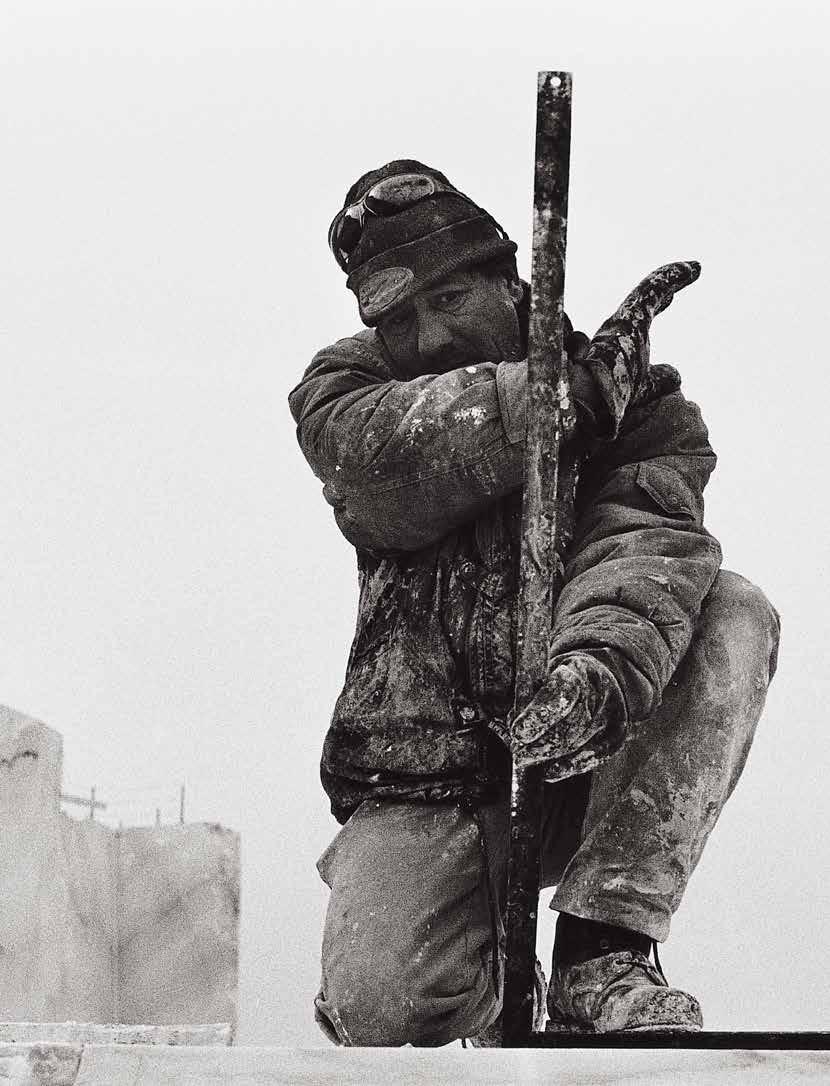
Art


134 Art
“Why is he here?” they wondered. “What is he looking for in this pebble?” and then they understood that what Giovanni Umicini was looking for up there, on that bare and splintered peak, beaten by the wind, was the truth of their immutable and almost timeless microcosm.
Umicini approached their daily toil with the utmost respect, he observed their movements, gestures, procedures, studied their faces and expressions, listened to their voices in the concert of sounds, noises, silences. He shared the cold and the heat, the fog that makes the contours of the quarry as creepy as the ruins of a grim castle. The quarrymen saw him many times, for days in a row, over several consecutive years, moving among them with discretion, without interfering, following a project of his to be realized little by little with his camera: a man advanced in years, his own face hollow and severe that seemed carved in stone, and always seemed clouded like the sky of the Cervaiole. “Why is he here?” they wondered. “What is he looking for in this pebble?” and then they understood that what Giovanni Umicini was looking for up there, on that bare and splintered peak, beaten by the wind, was the truth of their immutable and almost timeless microcosm, as vital and complex as the streets of the cities the photographer had explored to discover the essence of man.
They felt that his presence had many meanings, all close to their simple, laboured stories and that with his photographs (some of which were already printed and exhibited in the cafeteria), with their portraits, delivered to each as a tangible sign of affection, of a special friendship, he intended to tell their daily gamble with an uncertain future, with the fate that binds them proudly to that ancient profession on the white mountain. Giovanni gathered the meanings of their lives, he revealed it with that solicitude and delicacy that is proper to the highest poets and spirits. He had become one of them, to narrate – in the most appropriate way, finally! – and pass on a centuries-old adventure that is always new and different, as time and seasons, as the smile of dawn and the fading of the sky at every sunset.
135 Art
Photos by Giovanni Umicini, 2006
ORGANIC FORMS, MARBLE AND METAL. HANNAH LEVY’S SCULPTURE IN NEW YORK
BY CECILIA ALEMANI
Commissioned by the High Line of New York in 2020, the work “Retainer” by Hannah Levy, created in collaboration with Henraux Foundation, was inaugurated this spring.
Cecilia Alemani, who directs the High Line Art and will be the curator of the Venice Biennale in 2022, interviewed the artist for “Marmo”.
136 Art
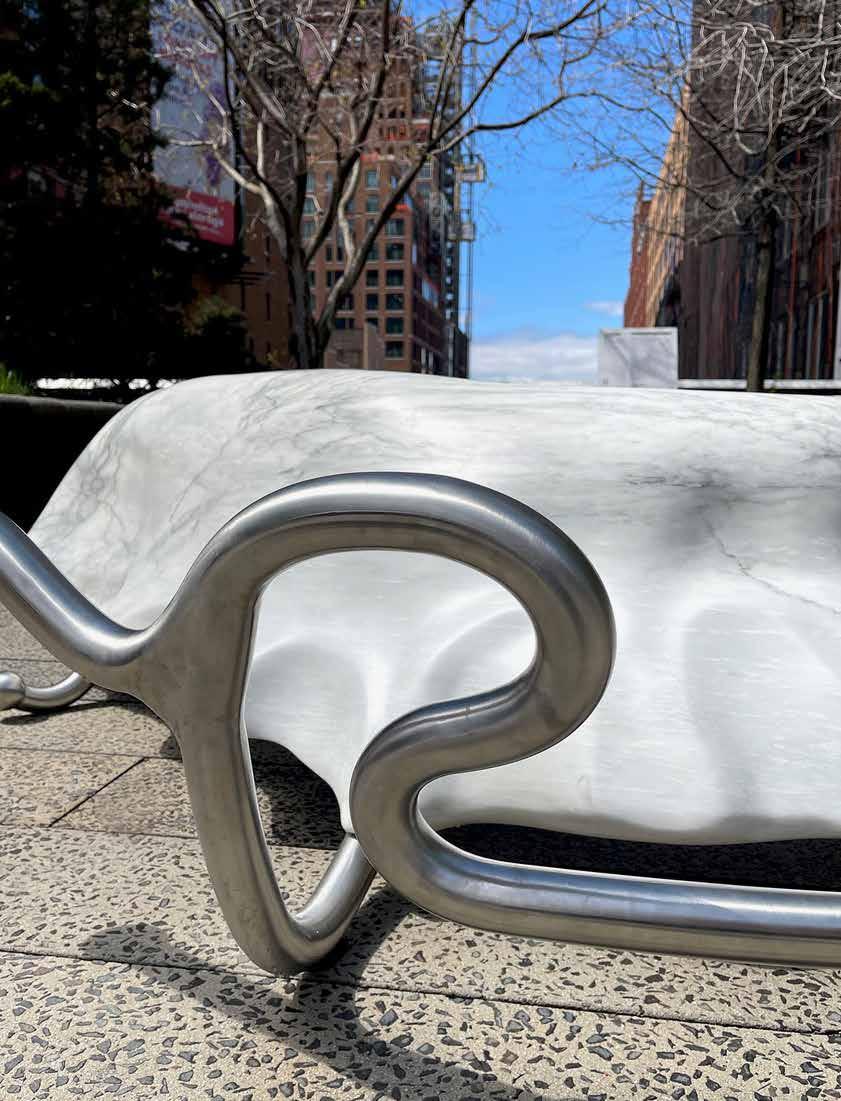
Art
Hannah Levy, Retainer, 2021, detail. Courtesy: Friends of the High Line

Art
«I love marble as a material because of its huge sculptural history and its ability to take on such different characteristics depending on its shape, texture, and color».
Cecilia Alemani: Tell us about the inspiration for “Retainer”, the artwork you made for the High Line in New York. Hannah Levy: The work made at Henraux is based on an orthodontic dental retainer. I often cast organic forms paired with curved metal in my sculptures and I like that the retainer is an example of a preexisting cast organic form, the negative of a mouth’s interior, paired with a curved metal structure. I’m also interested in the context of a form. The retainer is especially interesting to me because of its existence as an adolescent, sociocultural indicator.
C.A.: Have you used marble before?
H.L.: Yes, I have made hand carved alabaster pieces before and also worked with water cut marble slabs on a much smaller scale. I love marble as a material
because of its huge sculptural history and its ability to take on such different characteristics depending on its shape, texture, and color.
C.A.: How was your visit in Italy to the Henraux quarry? What was the most surprising aspect?
H.L.: I loved visiting the quarry last year. I’ve never seen exactly where the materials I’m working with came out of the ground, seeing the process of creating what I usually consider a “raw” material gave additional weight to the experience of working in marble. The size of the mountain, and the history of the stone collected there through the centuries is almost impossible to imagine until you see it in person. I was shocked by Monte Altissimo’s scale and
139 Art
Hannah Levy, Retainer, 2021. Courtesy Friends of the High Line
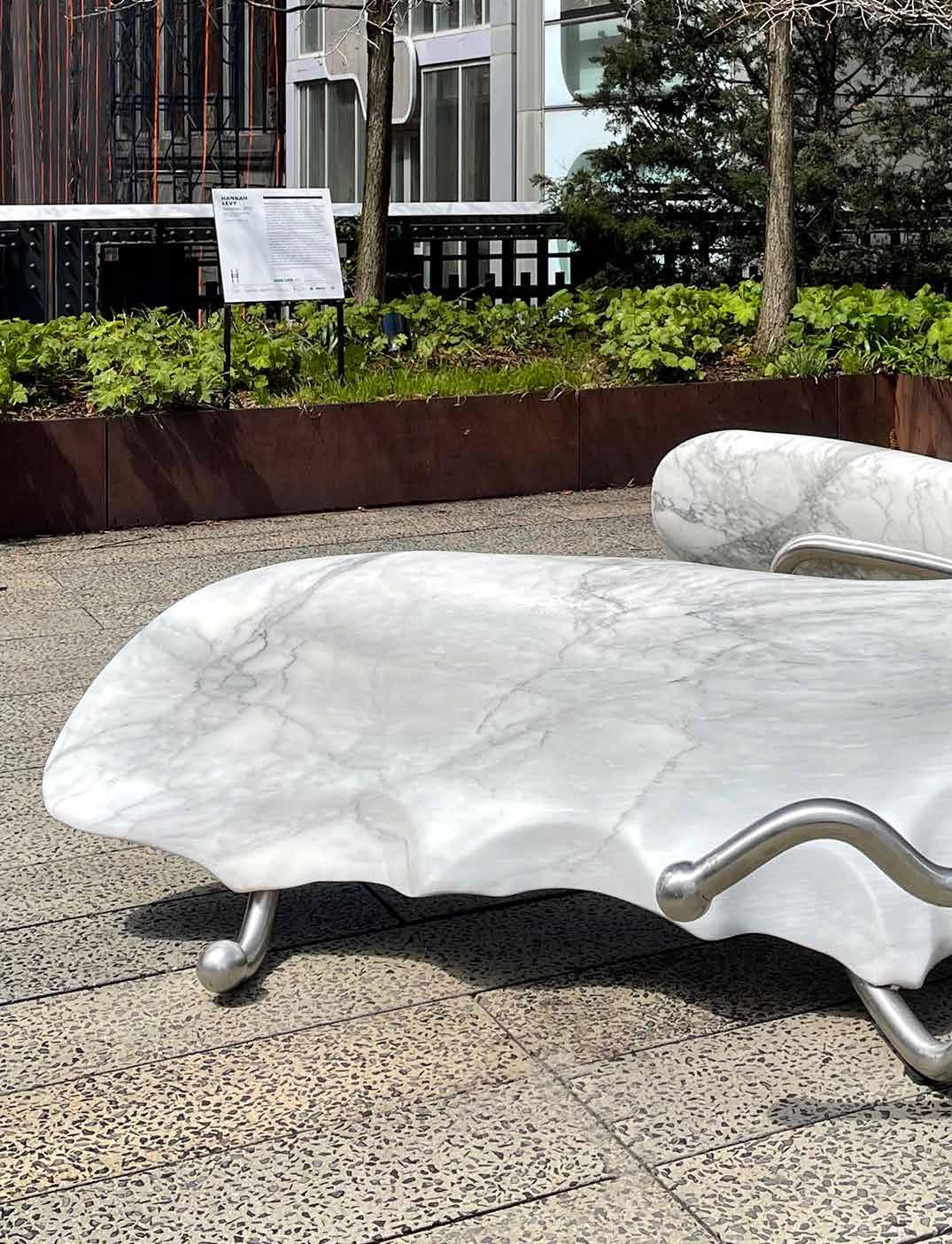
Art
beauty. There are parts of the mountain that are so impossibly monumental that it’s almost other-worldly. I feel so lucky to have been there, it’s the last time I traveled before the pandemic and I’m so grateful to have had the opportunity.
C.A.: Was there anything surprising by working on such a large scale?
H.L.: I usually make all my work by hand, so it’s a very solitary process and there’s a limited maximum size that I can make, working alone and with my tools. I start making a piece with a loose idea of the final product. What comes out isn’t exactly what I had in my head at the beginning because the fabrication process allows for a kind of physical rethinking of the original idea. When working at such a large scale, a lot of that space for spontaneous reconsideration is lost because the fabrication of the work relies on many hands that are not my own. The kind of “problem solving” point of fabrication needs to happen in the planning phase of the piece rather than throughout the making process, and communication and collaboration become really important. It takes artmaking from a very isolated experience to something much more collaborative.
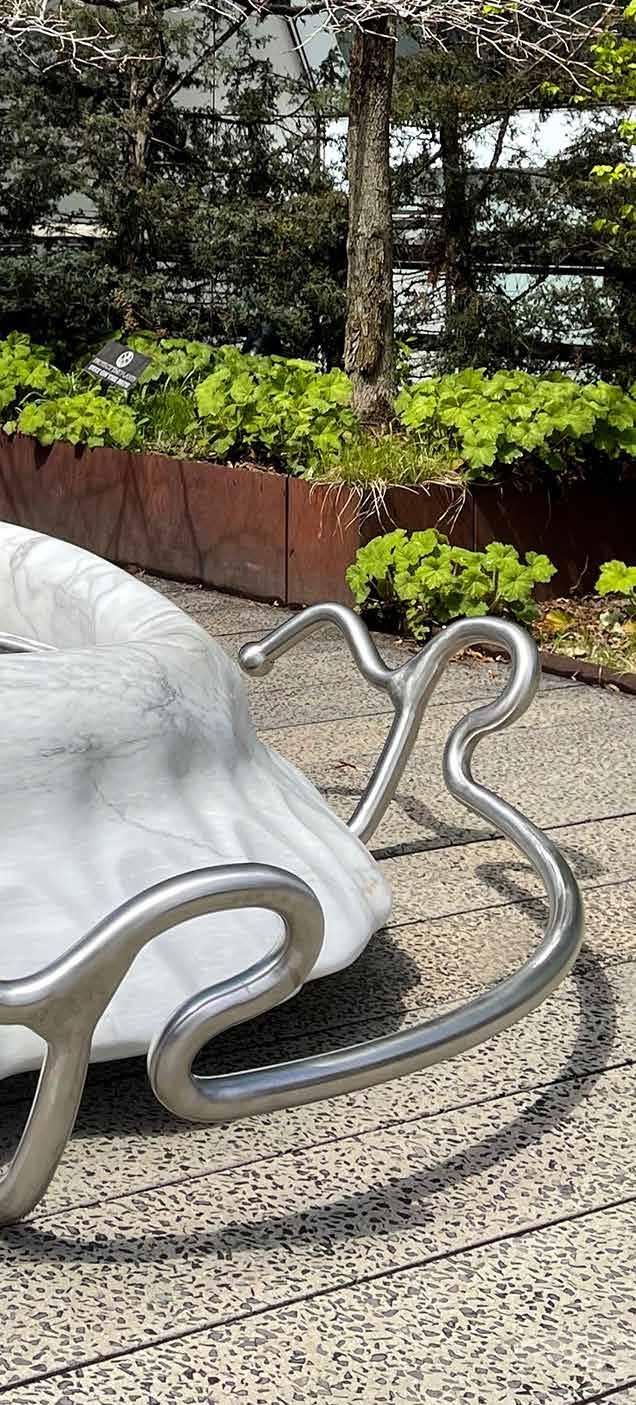
141 Art
Hannah Levy, Retainer, 2021. Courtesy Friends of the High Line
«My references range from modernist designers, to home depot grills. I like finding aesthetic similarities between unexpected items and focusing on objects whose design subtly reveals some underlying societal values».
In this case, the team at the High Line and Henraux made navigating any possible challenges really seamless. I think this new collaborative process will be very instructive for any future, large scale projects.
C.A.: How do you imagine people will interact with the work?
H.L.: I’ve imagined the piece existing as a kind of bench, so I think people will sit on it. The retainer has been enlarged so the marble stands at roughly bench height and the steel is the width of a public handrail. In conceiving of the piece, I wanted to make a work that felt suited to a public space. By its nature the High Line invites physical interaction between viewers and artwork. There’s always a kind of flirtation between sculpture and furniture in my work, in creating this piece for the High Line I’ve stretched that relationship in a new way. Creating a work that can literally be sat on is a way of embracing the interactive and public nature of the space and the tension between object, art, and furniture that exists in my work.
C.A.: In your work there is always a dialogue, if not a clash, between soft and sensuous materials like rubber, silicone and in a way also marble, and cold materials like stainless steel. Can you talk about this?
H.L.: I love a contrast in materials as a sculptural tool. To me, a point of access to a sculpture is often a visual representation of familiar sensual/tactile interaction. We exist in soft, organic bodies, that are constantly interacting with or being constrained by various outside elements, metal chair frames, medical devices, gym equipment are all instances of bodily interface. When a soft, fleshy object is pinched or stretched over cold polished steel, we inherently know the feeling of that interaction. I like the retainer as an example of this contrast because it not only contains an organic form suspended on a steel structure, but also it is used to retain, constrain, or reshape a physical body through a slow and constant application of pressure. There is something inherently sculptural incapsulated within the structure of a medical brace.
C.A.: What do you look at for inspiration?
H.L.: I find inspiration in many different areas. It could be a swing, a handrail, a treadmill, or a chandelier. My references range from modernist designers, to home depot grills. I like finding aesthetic similarities between unexpected items and focusing on objects whose design subtly reveals some underlying societal values.
142 Art
Hannah Levy next to the sculpture
Photo by Nicola Gnesi
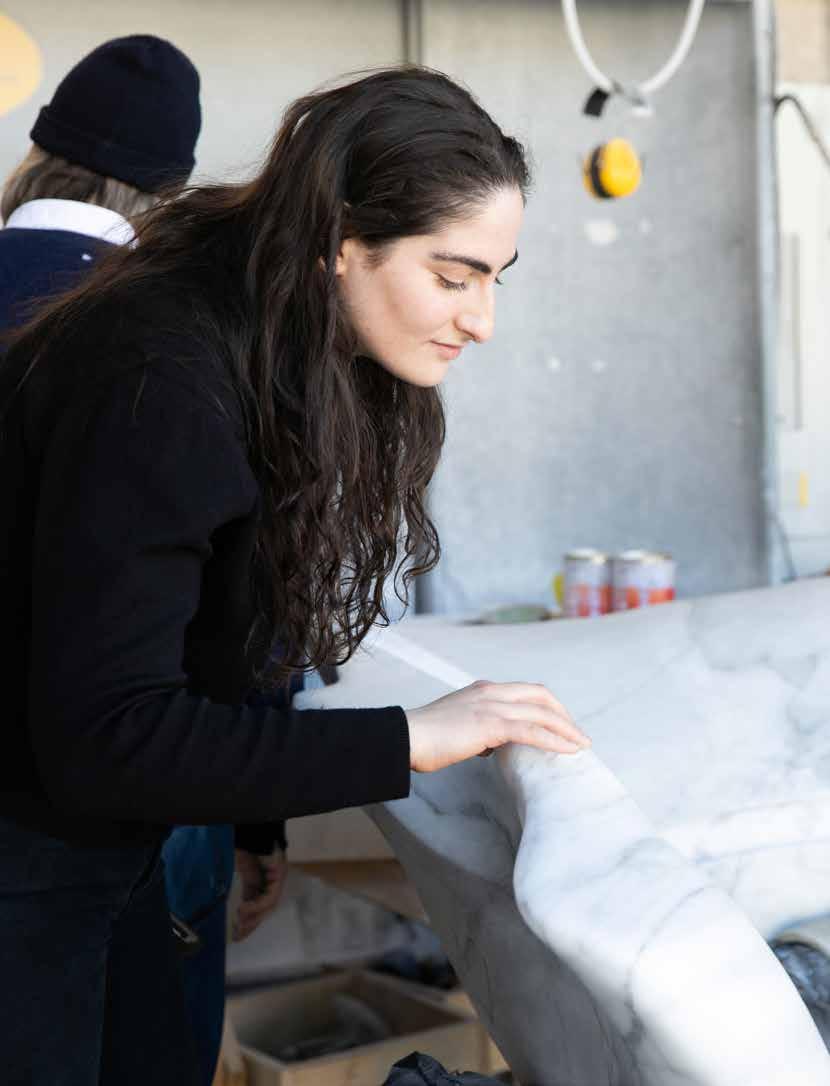
Art
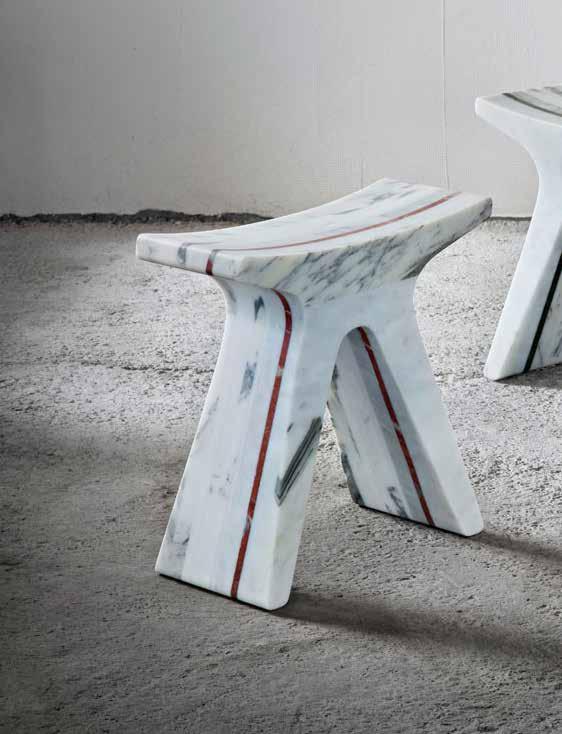
Design
Francesco Meda, Pigreco for Luce di Carrara
REDISCOVER MARBLE IN THE PRIVATE SPACE
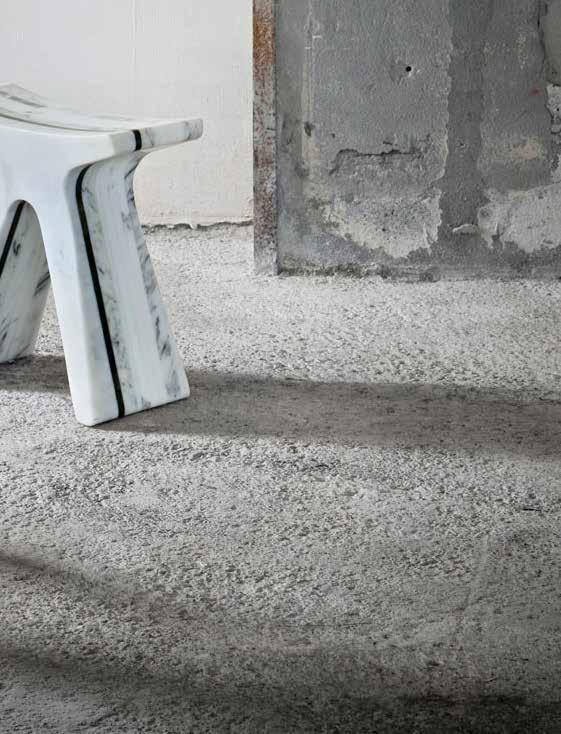 BY ALDO COLONETTI
BY ALDO COLONETTI
The pandemic will have brought many changes, especially cultural ones, that we will not be able to ignore in the world of design in the near future.
Marble remains a fixed point: for two thousand years the protagonist of public architecture and private spaces, of commonly used artefacts and precious objects, it will continue to give us back the passage of time, to mark the flow of history.
Design
Stone, in our case marble, has always accompanied the cultural evolution of man, marking the fundamental passage from “nature” to “culture”, or when, from a need to survive, it becomes necessary to defend oneself.
The time we live in is part of history, so designing from now on will mean, as it has always meant, to deal with these new conditions that the pandemic has imposed on our way of living, thinking and “doing”, that are not only physical but above all, anthropological. Once we have put these particular years behind us, memory will still act as a sentinel not only in terms of bringing fear of other similar experiences but also concerning what we have learned about living, working and designing. Basically, on the “trade” of creating that has always accompanied man since the beginning of his adventure.
In that extraordinary book entitled “The history of the world in 100 objects” written by the director of the British Museum in London for many years, Neil MacGregor, the first three works in chronological order are Hornedjitef’s mummy, the Chopper and the Olduvai hand axe, all placed between 2,000,000 and 9,000 BC, the latter two made from stone. As MacGregor writes, «they are essentially pebbles chipped by hitting a large stone on top until at least a sharp edge is formed. They are not improvised objects, they are
the result of experience, careful planning and skills learned and honed over a very long period of time».
Stone, in our case marble, has always accompanied the cultural evolution of man, marking the fundamental passage from “nature” to “culture”, or when, from a need to survive, it becomes necessary to defend oneself from an enemy that comes in different “guises”, no matter if it is from animals, people, bad weather or disease. It is essential to organize oneself to give shape to a coexistence in which one is capable of recognizing others as members of a society, in the primary form of a simple “tribe” linked to exclusively family ties.
The objects and materials that mark all the different phases of history are a symbolic expression of our identities, where memory, alongside changes and transformations which supersede previous models every day, play an irreplaceable role: remembering and selecting, to avoid having the “drawers” full.
From this point of view, stone and marble represent continuity, I would say permanence. They have always accompanied our collective experiences,
146 Design
Francesco Meda, Pigreco for Luce di Carrara
147 Art Design
from art to architecture to the symbolic place, par excellence, of the passage from one world to another: the cemetery. The extraction of marble from the Apuan Alps began about 2000 years ago, and therefore more recently than the stone objects recounted to us by the director of the British Museum. The marble was loaded on ships in the port of Luni and from there transported to Rome. In fact,
the fortune of this material depends not only on its unique characteristics, but also on the possibility of transporting it all over the world: the port of Marina di Carrara, on the one hand, and, on the other, the construction of a dedicated railway, the Marmifera, to develop its diffusion in the world.
And so: if we could follow the use of marble step by step, through all the expressive but
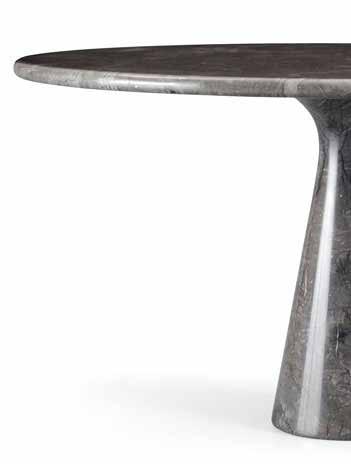
148 Design
Angelo Mangiarotti, Tavolo M
also functional transformations that artists, architects and designers have created, we would have a kind of “litmus test” concerning the fundamental oscillations of taste, to say it à la Dorfles, present in our society, as if to mark some stages, between victories and defeats, between democracies, empires and dictatorships, between public life and private spaces, between peacetime and wartime, but
also between pandemics and healings. Essentially, our lives cannot be without marble because – like all materials that have a history and a development under the banner of “rarity” and, in this case, also attributable exclusively to a particular place and cannot be replicated elsewhere – it marks our collective life and our homes, with a strong symbolic presence. Who doesn’t have a marble object in

149 Design
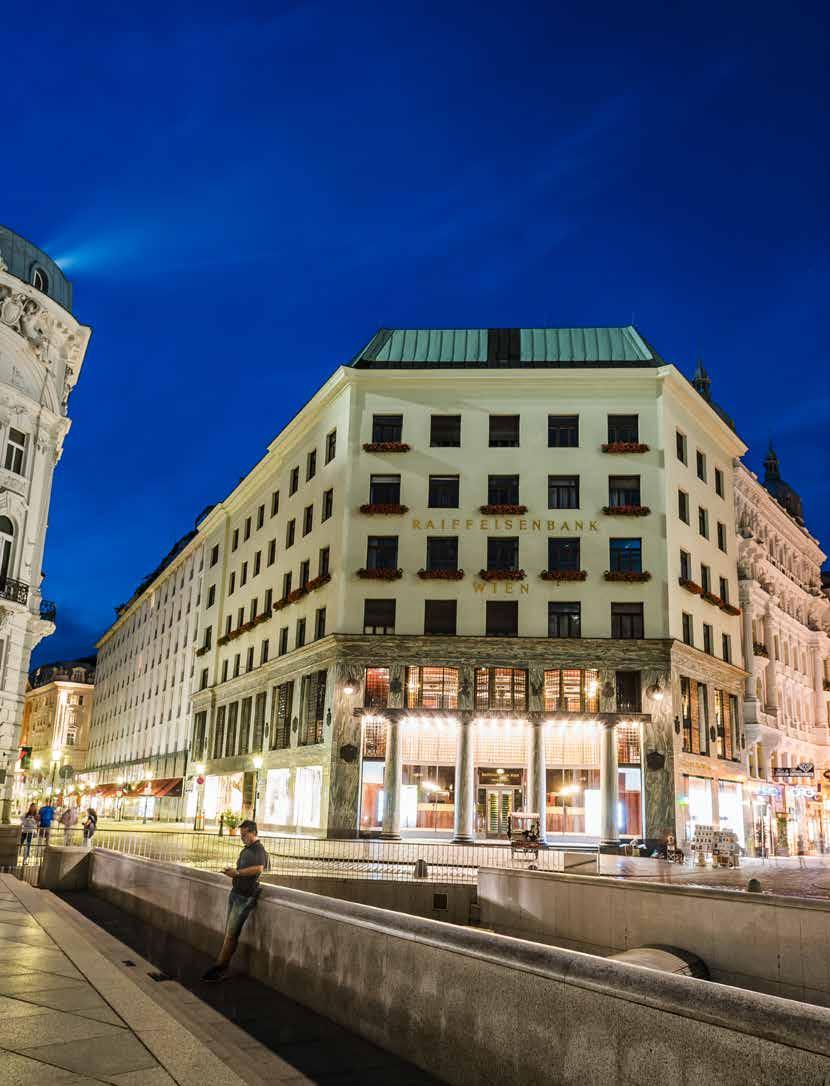
Design
Marble belongs to a history of changing tastes, of course, but it also represents a symbolic permanence, beyond its aesthetic dimension, of an anthropological character because it is able to combine rarity, preciousness, uniqueness, with common sense.
their home, capable of responding to specific functions – think of the kitchen or bathroom – and at the same time able to bring back a memory, a memory linked to a particular moment of their life, happy or painful or successful, such as an award or recognition? In essence, it echoes the main steps of our life, public and private. Marble belongs to a history of changing tastes, of course, but it also represents a symbolic permanence, beyond its aesthetic dimension, of an anthropological character because it is able to combine rarity, preciousness, uniqueness, with common sense, desires and expectations of each of us, beyond wealth and cultural level.
It is only possible in this way to separate Carrara marble from its “solemnity” and arrive at its deeper meaning, present not only in the “great” – a name for everyone: Michelangelo – but in all those manifestations of applied arts, in particular architecture and design, which made possible a sort of redemption in the sign of a design and expressive “secularism”.
For example: if we analyze the winners and selected awards of the Compasso d’Oro, from 1954 to the present day –twenty-six events, thousands of objects and products – it is possible to carve out a particular story, within the presence of marble. We think of designers such as Angelo Mangiarotti and Alessandro Mendini, but also of the more recent experiences of Antonio Citterio and Alberto Meda. A sort of fil rouge that marks the transformations of taste and function, because Carrara marble is not only “beautiful”, but also represents
some solutions to specific interior design problems.
Obviously, they are more numerous and scattered throughout the twentieth and twenty-first Century, fundamental works of architecture where marble indelibly distinguishes, with its own language, both the single work and its relationship with the city. An example for all, entered in all history books is the Looshaus (1909-1911), the famous building in Vienna, designed by Adolf Loos, who with the declared renunciation of historicism and floral decoration of the secessionist style, announces a moment of rupture: in this fundamental case, it is the contrast between the marble placed in the lower part of the facade and the simple plastered facade in the lime of the upper residential floors as if to mark permanence and change at the same time. But it is in private spaces above all, that have now been rediscovered as workplaces, that it is possible, precisely due to the necessary stay dictated by the pandemic, to rediscover not only new functions but also all those symbolic presences that are part of our life, perhaps set aside in other periods, are today, instead irreplaceable in giving new meaning to an existence awaiting normality.
Marble represents a fundamental presence, always suspended between personal relationships and collective memory, capable of connecting and putting together “rituals” and “myths”, “high” and “low”, above all each of us with the rest of the world: after all, even a dish or an old ashtray is part of our existence.
151 Design
Looshaus by Adolf Loos in Vienna
LEONE TOMMASI. FAMILY ART
BY ROBERTO BERNABÒ
PHOTO STUDIO TOMMASI ARCHIVE
The patriarch of an eclectic family in which everyone, from children to great-grandchildren, devotes themselves to artistic activities with different media, Leone Tommasi is above all the forefather of a history, that of contemporary art in Versilia. Through the memory of his granddaughter Ilaria Tommasi, Roberto Bernabò sketches a portrait of the great artist.
152 The Masters of Henraux
Leone Tommasi
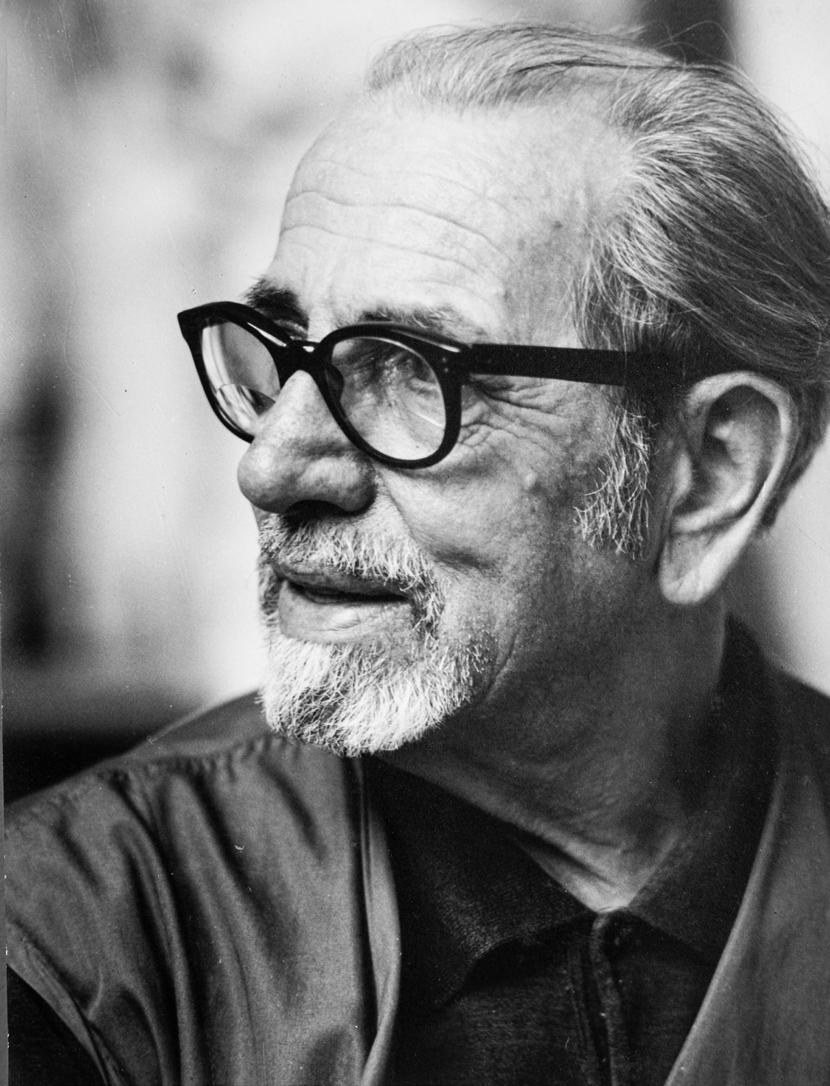
The Masters of Henraux

The Masters of Henraux
We join Ilaria Tommasi, daughter of Marcello Tommasi and niece of Leone Tommasi, a family of great artists, to try to tell the story of an illustrious person from this region, perhaps the most important in contemporary art. His is certainly a name that represents the beginning of a great history linked to the Versilia territory, a name that is almost sacred, because, for anyone born here, like me, who has breathed the history of marble and its evolution – in particular from the 1960s-1970s when Pietrasanta was recognized as a central place, nicknamed “little Athens”, using the abused phrase of Superintendent Paolucci – let’s say that up there, in the distance, there has always been the figure of Leone Tommasi as the founder of a story.
A great artist, a man who worked in his family workshops, but also in a collection of others, starting with the one that hosts us today, Henraux.
Roberto Bernabò: A history that is consolidated over time, I would like to start by asking Ilaria Tommasi this: was Versilia sufficiently able to recognize who
Leone Tommasi was and what he really represented?
Ilaria Tommasi: Maybe afterwards, at a later time. The figure of Leone’s father, Luigi Tommasi, was important. He founded the Ferretti marble workshop, where Leone had learned and internalized that culture of work that is important in this region. The boundaries between craftsmanship and art are blurred, and perhaps they were even more so at that time. Grandfather Leone then freed himself from this image, undoubtedly becoming a great artist, beyond any false modesty. And he was an artist and established himself as such because on the one hand, he did not undergo the influence of the avant-gardes, who were notable sirens when he worked, but on the other hand, he did not even undergo the suggestion of the academies. And here is the very strong innovation, this tension that comes from the interior, this sticking to reality, this sticking to nature, not according to a criterion of slavish imitation, but as something that comes from within and expresses itself without reaching that swelling that causes
155 The Masters of Henraux
Leone Tommasi, Maiden with braids, sculpture belonging to the cycle inspired by Beethoven’s Pastoral Symphony
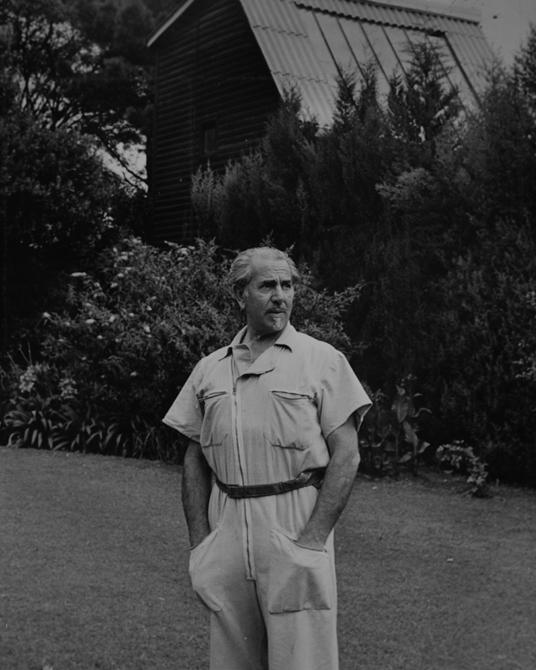
156 The Masters of Henraux
Leone Tommasi in his studio in Argentina
Right, Descamisado in marble at the Henraux studios in Querceta
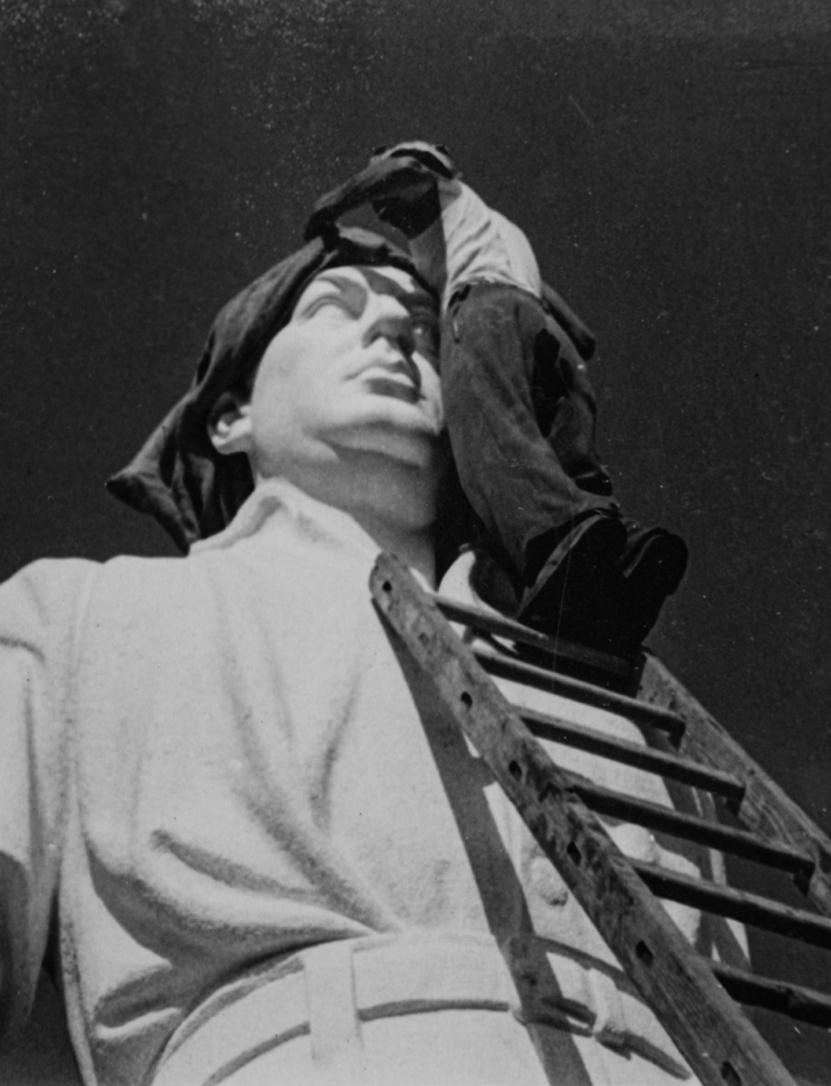
The Masters of Henraux
the work to acquire a classic academic connotation. My grandfather, in this, was far from these two extremes, he had inner tensions that made him new: he was inspired by classical art, but he was an innovative artist.

R.B.: Another aspect of Leone was also that of choosing to live in Pietrasanta, after having attended the Academies of Rome and Milan and from which he didn’t leave with too much pleasure.
I.T.: He deliberately chose to retire as a young man. However, he was a man who had begun to experience his artistic dimension very early on, so he had already travelled a lot, he had seen the world, in fact, my grandfather’s works are scattered almost everywhere. After, he decided to make this type of choice for which many were grateful because his studio was a sort of temple where the arts gathered, where there was this very strong sense of welcome, but of great respect and
great formalities. It was a place open to everyone, and the interesting thing is that the people who frequented it came from all walks of life. There is a beautiful portrait of Angelo Canali, a marble worker, which is overwhelmingly strong because my grandfather was able to bring out from the face of this man, who is clearly a very simple person, a great interiority; in short, he could grasp everyone’s spirit.
R.B.: I mentioned at the beginning that on one side, there is the family workshop, but Leone, in creating his many works, made use of collaboration with many workshops in Pietrasanta, and one of the greatest activities, before it was interrupted, it was precisely with Henraux and deserves to be told. On 11 August 1954, he signed a contract with the Argentine government to build a colossal work in Buenos Aires: the “Monument to the Descamisado”. A work commissioned by the Perón that was to become the mausoleum of Evita Perón and
158 The Masters of Henraux
Leone Tommasi, sculpture belonging to the cycle inspired by Beethoven’s Pastoral Symphony
Right, Leone Tommasi, Evita Perón
«He could grasp every slightest expressive variation of a subject, every movement of their soul».
was to have an impressive size: 137 m high on a circular base of 100 m in diameter, for 43,000 tons of marble and 15,000 m³ of reinforced concrete, with marble of the Altissimo which was to adorn the circular base of the monument. Here, this work, which was then interrupted and did not go on, was an extraordinary commitment for him.
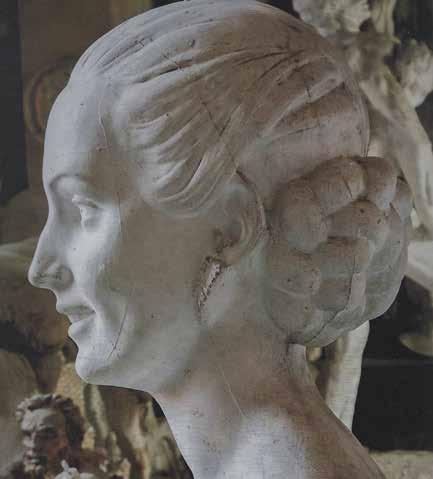
I.T.: It was truly an extraordinary commitment. It is important, then, to talk about the Henraux company, which at the time was the one most responsible for the realisation of this mammoth, grandiose work. Indeed, a high-ranking official from the Perón government arrived here, exalted by the idea of this project. Even the senator said that the greatest and most important work in the world would be accomplished: in short, a very fervent climate had been created, full of expectations around this work. I jealously keep the letters that my grandfather wrote to my grandmother when he was
in Argentina, in Buenos Aires. Among other things, he wrote incredibly because he punctually described all the situations and the emotion of Perón who went to pose for him. He even makes a careful description of her, in a letter, also of the ways in which she placed herself in front of him, concerning her poise; this woman, he writes, «more elegant in her posture, in her figure, than in her clothing, with this diaphanous complexion, this very mobile expression». He could grasp every slightest expressive variation of a subject, every movement of their soul. These letters are beautiful, they speak of him and of the climate that surrounded him, of the welcome they had reserved for him; in fact, he was considered a god, they had even prepared a private study for him.
R.B.: In your opinion, how did he live this commission as an artist, for a regime like that of Perón, how did he manage to
159
The Masters of Henraux

The Masters of Henraux
combine the spirit of a free artist and this commission?
I.T.: Well said, he was a free artist, even if there were many controversies about it that made my grandfather and children suffer (my father didn’t want to talk about it). They even came to assimilate Perón to the figure of a fascist, and my grandfather, who had saved antifascists, let alone if he could be an artist subservient to a dictatorship of that type! Absolutely not. Furthermore, things seen with a certain detachment must also be evaluated for what they were: she was certainly a populist ruler, yet my grandfather, speaking of the Argentine situation of the time, felt simply a free man who had to make several portraits, even to these characters, of course. Above all, the figure of Evita so galvanised him, this woman who had chosen grandfather – because it was she who had basically chosen him – as an artist, because according to her he was able to interpret the figure of the descamisado well, that
«Above all, the figure of Evita so galvanised him, this woman who had chosen grandfather – because it was she who had basically chosen him – as an artist, because according to her he was able to interpret the figure of the descamisado well, that is, of the one who becomes a people».
is, of the one who becomes a people. Thanks to her, who was such an important character, such a human woman, so lively, a very strong, driving personality, he did not concern himself with the problem of political enslavement: my grandfather lived her reign in a free and easy way.
R.B.: When we talk about Leone Tommasi and the Tommasi family, we are talking about a family that lives on art: meanwhile sons, Marcello and Riccardo, two extraordinary characters of artistic culture and then Luigi, who had the foundry, and Paolo, who despite having made a career as a lawyer, was also an artist. In short, art has always been in the hands of this family, either as artists or in other guises like your children.
I.T.: Yes, my daughter has the great merit of having ensured that Leone’s memory has finally been valorised, recovering in 2014, my father’s studio in Florence (her grandfather Marcello) and here in Pietrasanta the studio of my grandfather
161 The Masters of Henraux
Right, Descamisado in marble at the Henraux studios in Querceta
Leone, which also has had a strange story, because it was sold as bare property when my father was still alive, and then we recovered it and if Francesca hadn’t been there I wouldn’t have succeeded...
R.B.: What was the artistic relationship between Leone and his sons?
I.T.: Leone and his sons were all very different as artists: even though they could all be placed in a figurative criterion, they were very different from each other. Riccardo was a genius of painting with his own particular irony, grandfather and father were perhaps more marked by sculpture, although they too painted, but in a very different way. Father’s type of sculpture was much more nervous, even if you have to be careful with these codifications because you risk falling into pedantry, so let’s say they were simply different. There was this adoration on my father’s part for my grandfather: he
wrote beautiful essays about him because my father was also an art critic and had written art history books, so he wanted to theorize in some sense, the aesthetic criteria of grandfather. They were also very different in life, my grandfather had a much more staid character, despite the fact that all the Tommasi had a strong character, but he was much calmer, more precise, while my dad was a disaster, very messy... I don’t know what relationship there was in truth, there was certainly a relationship of esteem and profound respect. There was respect for the figure of this great teacher, who would never have wanted his children to do the same work as him because he knew it was an extremely difficult and very bumpy path, so he did not want his children to follow him.
R.B.: Of Leone, we must also remember that he taught for many years at the Art
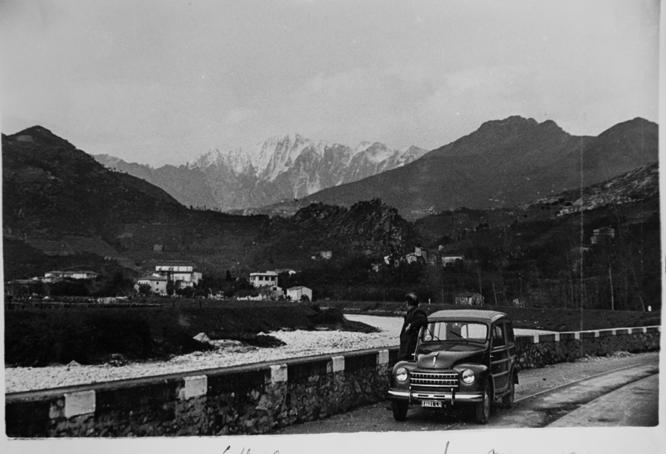
162 The Masters of Henraux
Leone Tommasi in front of Monte Altissimo, Vallecchia, Pietrasanta Right, Leone Tommasi, arriving in Argentina
On the next page, a view of the large studio in Pietrasanta

The Masters of Henraux
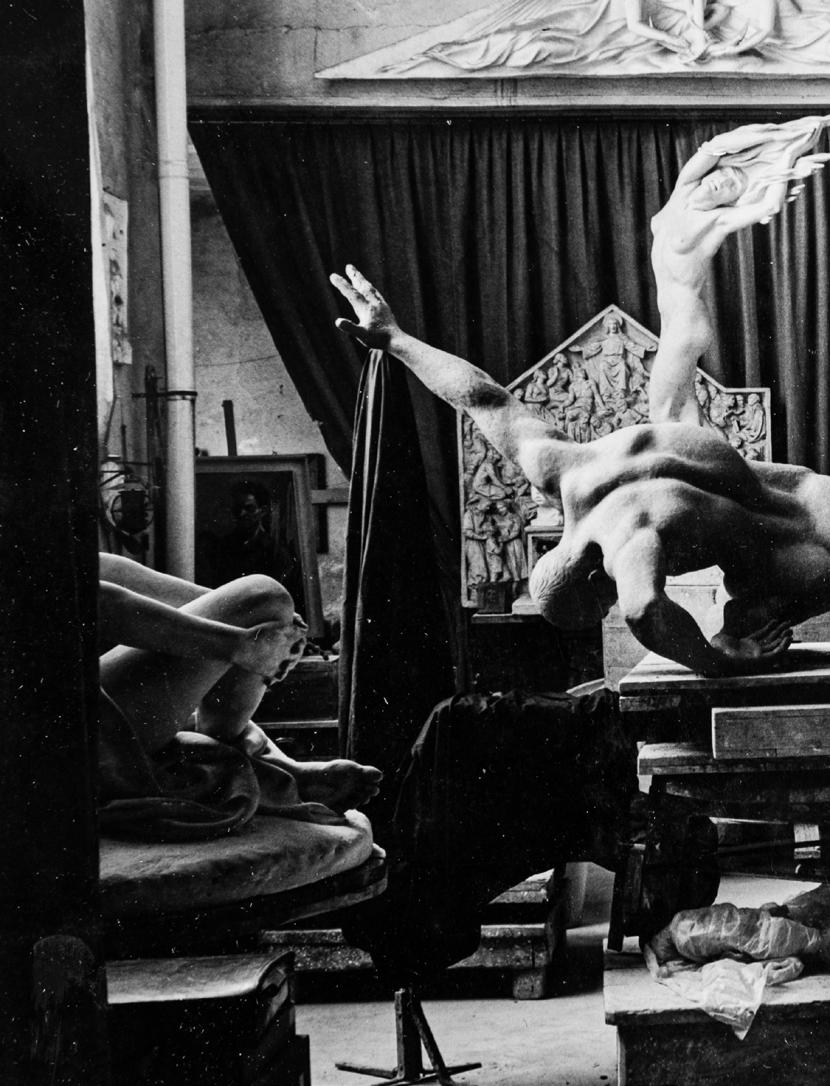
The Masters of Henraux
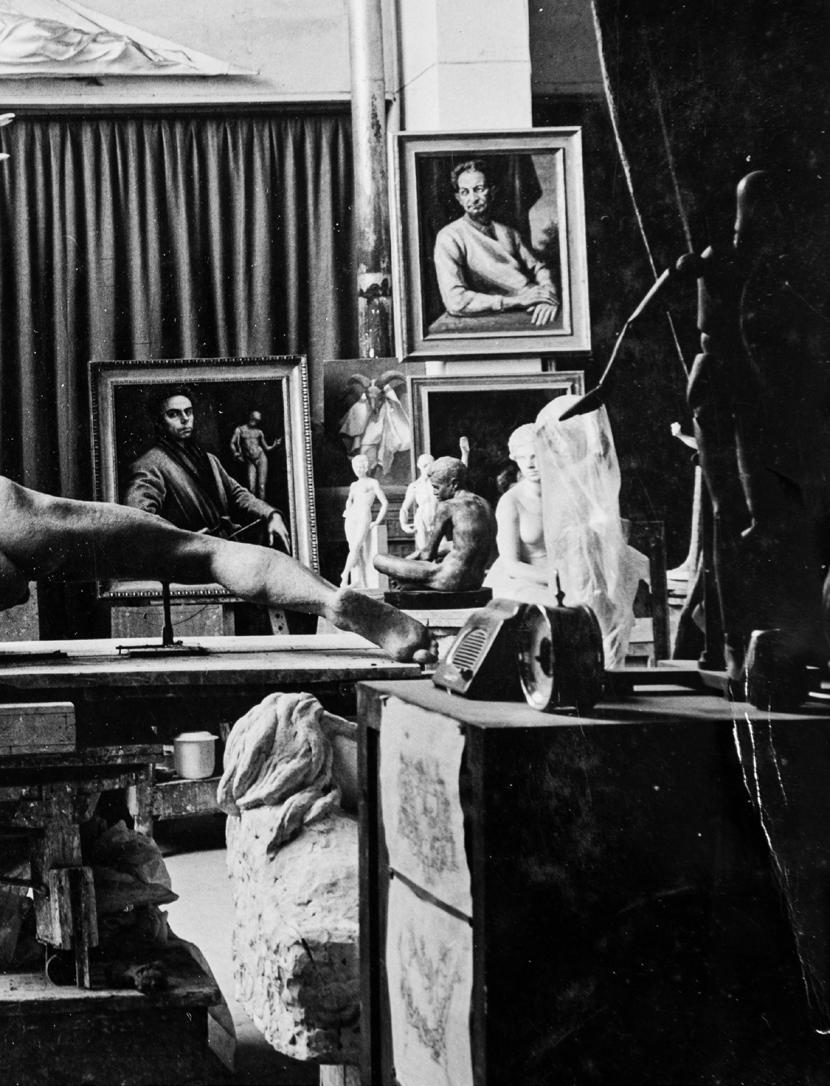
The Masters of Henraux

The Masters of Henraux
«He was a person who when important personalities such as Carrà or Soffici went to his studio, he stayed there to work, perhaps without even talking too much about art, but rather about good food, fishing since he loved fishing and trips to the mountains; in short, he had a simple disposition».
Institute of Pietrasanta. So he also did a teaching job, to train new generations and new students who attended his studio.
I.T.: Yes, of course, teaching is fundamental: the transmission of knowledge, a free transmission, according to the noble meaning of the term, which is very important; transmitting, donating one’s talent, is something my grandfather has always done, and my father Marcello and my uncle Riccardo have always had this attitude also.
R.B.: What is the spirit of the Pietrasanta atelier?
I.T.: The Pietrasanta atelier has been converted into an art gallery where events are also held, let’s say that it has a somewhat transversal function, as there are no longer resident artists in flesh and bone; there are others of course, who are hosted and exhibited. In short, the spirit is this, that of perpetuating the artistic tradition and historical memory, also because it is a plaster cast collection notified by the Superintendency where the works and plaster casts of Leone and Marcello are kept.
R.B.: So anyone who wants to see the works of Leo and Marcello can find the plaster casts of many works there, while what if, in the meantime, one wanted to take a tour of the works scattered around Versilia?
I.T.: It is already a place considered essential for visits, and it is there that we also find much of the work that Leone did in Argentina. In Querceta, the removed heads of the figures of Juan Domingo Péron and his wife Evita are still found in the Henraux factory. The figures nearing completion of the “Monumento al Descamisado” and of Eva Péron were destroyed in 1956 by a delegation of the new government after the fall of Péron. Then there is the Sant’Agostino plaster cast gallery where, in 1984, if I’m not mistaken, the family donated most of their grandfather’s full-length plaster casts to the Luigi Russo foundation. There are the marble sculptures on the façade of the church of San Paolino in Viareggio, then in Azzano, there is grandfather’s head
put by the quarrymen to commemorate the Madonna del Cavatore alla Tacca Bianca. And then there is the Cathedral, there is the Madonna del Sole, and in the Cathedral of Pietrasanta there is also a painting by my uncle Riccardo, “San Martino”, and a painting by my cousin Giovanni, “San Biagio” and then there is the whole Via Crucis of my father Marcello, and of Leone, there are also all the bas-reliefs in bronze. Leone is almost everywhere, all over the world, maybe he is not an artist who had the recognition he deserved, but the works are there.
R.B.: Your grandfather died when you were only six years old: what are your childhood memories of him?
I.T.: He was a man who had such a whimsical and powerful personality, that he revealed in a grandiose way even within the family. I remember my grandfather with his dog, with his Fiat Giardinetta and when he played the napkin game at the table and made faces with the napkin: it was a myth for us children because he was really a special person. Unfortunately, then he fell ill, but even when he was ill it was incredible because we used to visit him at the hospital – and this is also present in the memory of Mario Cancogni, the writer –when we went to visit him in the hospital, he, so to speak, once recited “The Discovery of America” by Pascarella; he was there, more dead than alive, but he had incredible verve and joie de vivre, a kind of complacency just for being in the world. He wanted to leave an important mark on this earth, so he was a joyful and lively person. I always have a memory of my grandfather in the hospital bed that portrayed my sister and me sitting at the end of the bed. He was a person who when important personalities such as Carrà or Soffici went to his studio, he stayed there to work, perhaps without even talking too much about art, but rather about good food, fishing since he loved fishing and trips to the mountains; in short, he had a simple disposition, basically, so how can a little girl not remember such a wonderful figure? I was little, but I remember it well.
167 The Masters of Henraux
Leone Tommasi poses with the bust of Perón
NAIRY BAGHRAMIAN. MISFITS
BY BRUNA ROCCASALVA PHOTOS BY NICOLA GNESI
The following is a revised version of the original text, published on the occasion of “Nairy Baghramian. Misfits” (GAM, Milan, 26 May - 26 September 2021), an exhibition project curated by Bruna Roccasalva, organized by the Furla Foundation and GAM - Galleria d’Arte Moderna di Milano, with the contribution of the Henraux Foundation for the production of works in marble. The exhibition is part of the “Furla Series”, a program promoted by the Furla Foundation and created in collaboration with the most important Italian art institutions.
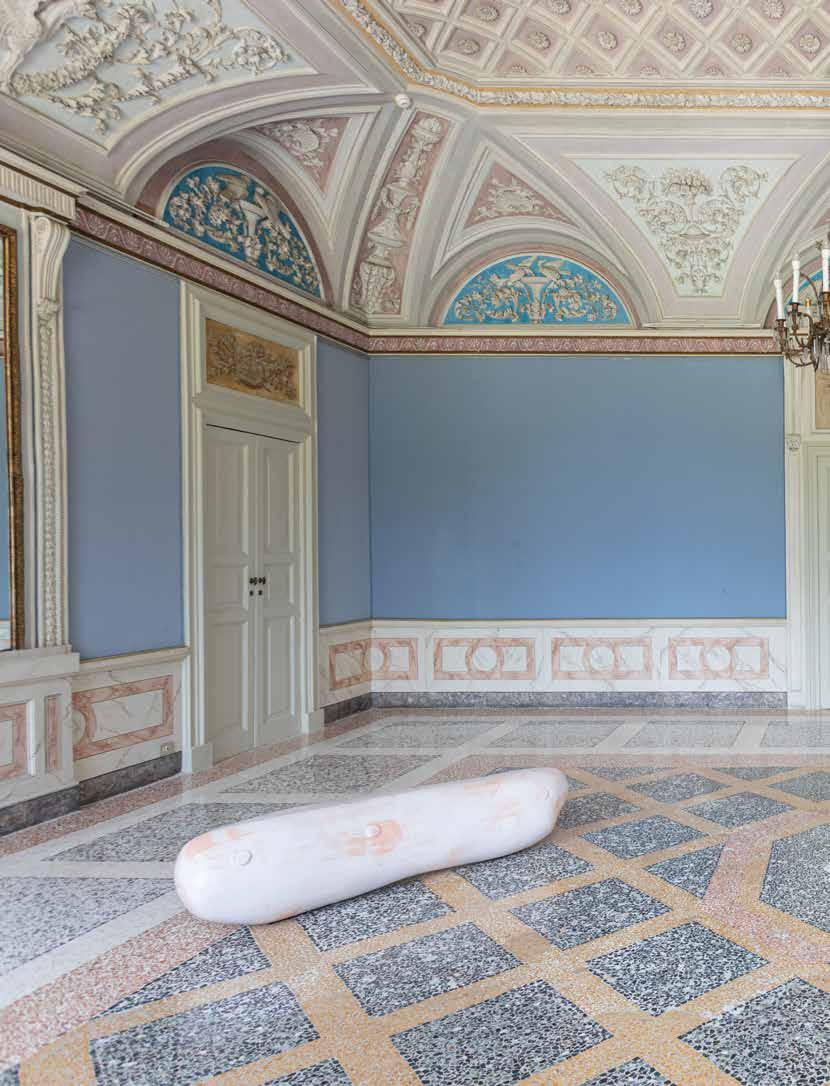
Art

Art
Nairy Baghramian, Misfits, 2021, GAM - Galleria d’Arte Moderna, Milano, installation view
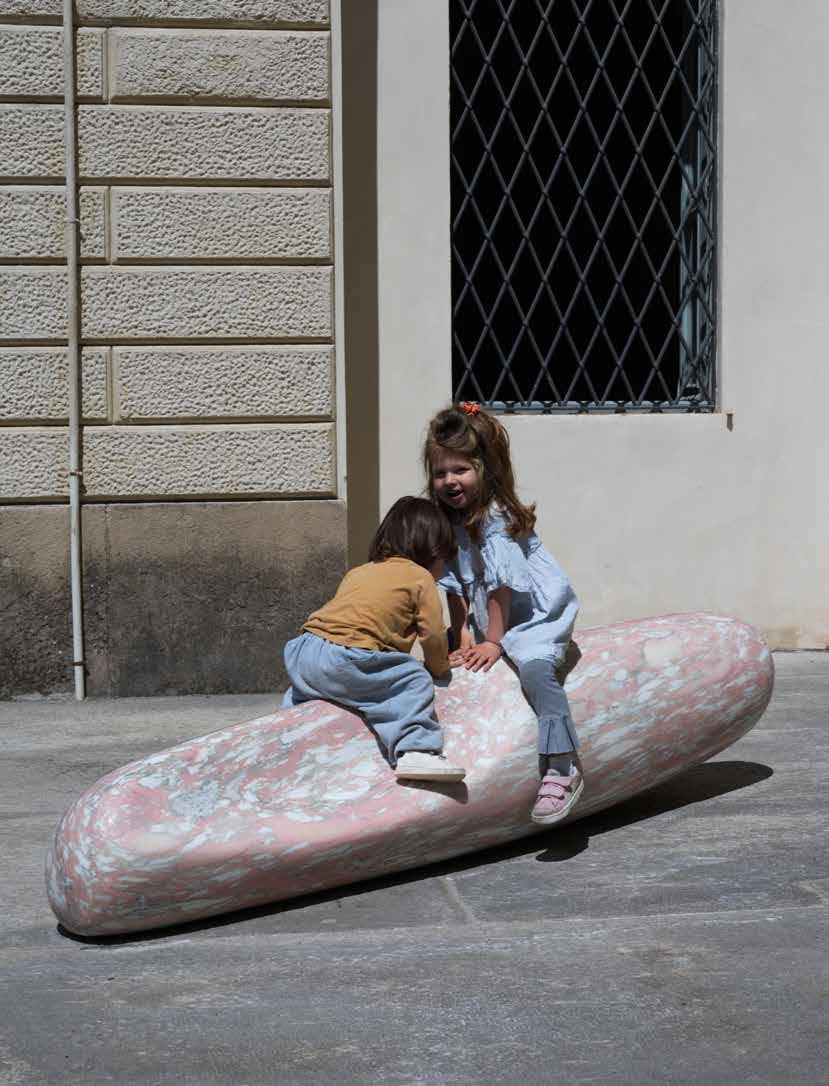
Art
«What is sculpture?
What is the burden of sculpture?
What is the power of a sculpture occupying a site?
For two decades Nairy Baghramian has been carrying out rigorous formal and conceptual research that questions the very definition of sculpture, starting from a practice deeply rooted in the sculptural tradition. That of exploring the relationships between architecture, object and the human body, her production confirms the importance of the physicality of a work, capable of embodying theoretical ideas and assumptions through the specific formal, material and exhibition traits that distinguish it. Her work represents one of the most important contributions to contemporary experiments with the language of sculpture and the “Misfits” project summarizes
some of the key elements, from the interest in traversing and rethinking the boundary between inside and outside, to an analysis of the relationships that bind the aesthetic object to the institutional framework that hosts it.
For Baghramian every work of art, despite its substantial autonomy, has a link to the time, place and political-social fabric in which it has been inserted, and the idea of “Misfits” arises precisely from the specific urban context in which it is located: the museum hosting the project. The neoclassical architecture of Villa Reale, where the GAM is based, overlooks a beautiful English garden, one of the first examples created in Milan, which
171 Art
Those are all problems that I’ve had with sculpture and that keeps me doing sculpture».
Nairy Baghramian, “Ambivalent Abstraction”, Ocula, August 28th, 2020
Nairy Baghramian, Misfits, 2021, GAM - Galleria d’Arte Moderna, Milan, installation view
Photo by Nick Ash
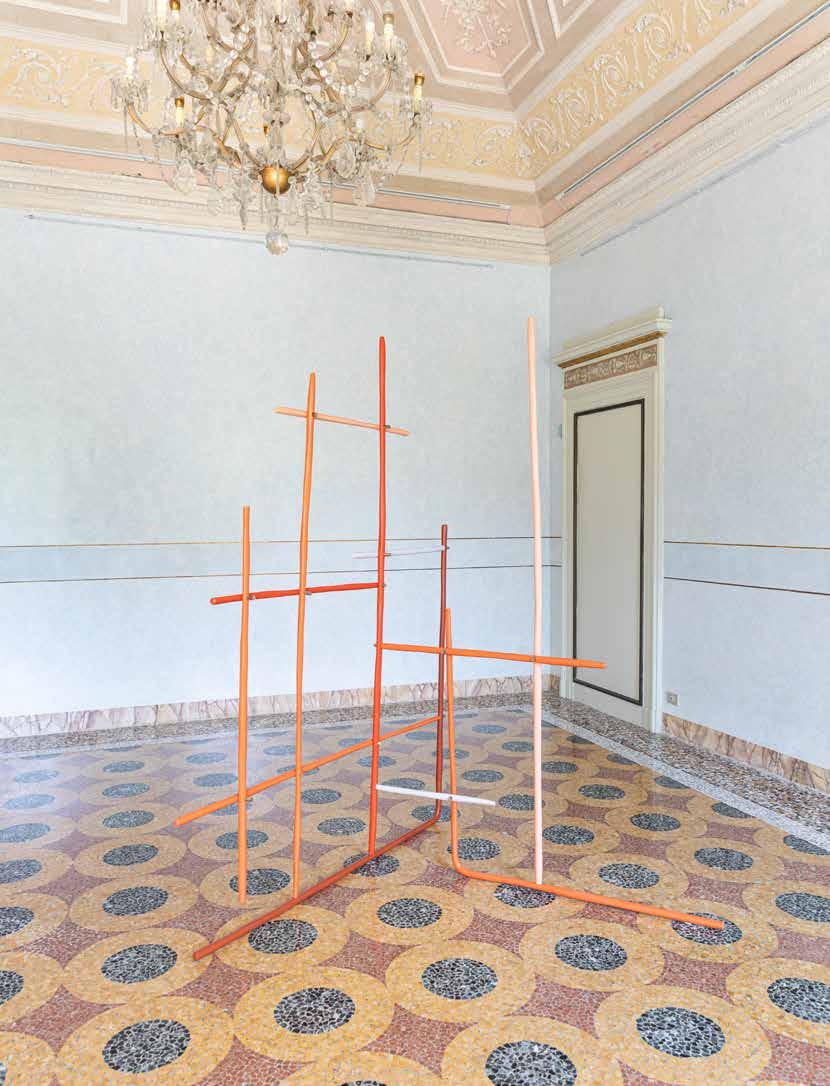
Art
From childhood, we are educated to assemble elements with perfect joints and thus to develop a model of thought according to which everything must necessarily match another. Baghramian’s sculptures deny this supposed coincidence: their shapes do not fit together perfectly, but on the contrary, they offer the experience of error.
has the distinction of being accessible to adults only if accompanied by children. The conflicting suggestions aroused by a context that refers to a protected and playful universe as that which belongs to children, but which at the same time generates a sense of frustration for the restrictions on its accessibility, were the prerequisites for the conception of “Misfits”. Hybridizing the idea of play as an educational device with a reflection on the experience of disappointment and inadequacy, Baghramian has created a series of large sculptures formally conceived to inhabit both the internal and external spaces of the museum. Inside, the exhibition has been divided into five rooms, each of which houses a sculptural element. The works discreetly inhabit the rooms, according to a deliberately rarefied arrangement exasperated by the artist’s choice to create a moment of “interruption” in the exhibition itinerary. In fact, the exhibition continues on the terrace adjacent to the rooms, which the visitor can observe through the windows or from the garden, but only in compliance with the rules governing access. There are also five sculptural elements on the terrace, positioned in correspondence with those that occupy the rooms inside the museum. Each of the works on display consists of two halves, made with different materials – cast aluminium and wood for the elements found inside, marble for those outside – and installed as if they were disjointed parts of a possible whole. Forever interested in exploring the relationship between internal and external – the institution and the socio-cultural context in which it is located, the work and the space that hosts it, the idea and the form that gives it body –, Baghramian intervenes on the spaces that mark boundaries to cross them and rethink them. For the artist, these interspaces are areas of reflection in which to raise doubts and ask questions: separating opposites, rather than trying to make them match,
is equivalent to questioning everything between these two extremes, and therefore to undermine any fixed ideas and preestablished rules.
The partial dislocation of each sculpture outside the museum halls creates osmosis between the space dedicated to art and a public park whose main users are children. The decomposed elements of these sculptures seem to evoke the typical structure of playful objects based on the interlocking of geometric shapes. From childhood, we are educated to assemble elements with perfect joints and thus to develop a model of thought according to which everything must necessarily match another. Baghramian’s sculptures deny this supposed coincidence: their shapes do not fit together perfectly, but on the contrary, they offer the experience of error as the only possible one, inviting us to discover beauty precisely in their imperfect juxtapositioning. The choice of materials, or how they are treated, contribute to the return of this experience. Knowing deeply the nature of materials and testing their potential is a fundamental aspect of Baghramian’s sculptural practice. This approach often results in an experimentation of unusual combinations of very different materials within the same work, which also happens in the sculptures on display, that combine enamelled aluminium and wood castings with marble of different natures and origins, marble such as the Statuary Altissimo and Versilys Altissimo, extracted from the Henraux quarries, and Rosa Norway, Rosa California and Costa Smeralda, which have been specially imported.
Aluminium is often used in the artist’s production, but here how the surfaces have been treated is completely new. The rigour and precision of an industrial finish, reminiscent of the Minimalist tradition, gives way to a painterly attitude, which allows for the imperfection or smudging of the “handmade”. The production of
173 Art
Nairy Baghramian, Misfits, 2021, GAM - Galleria d’Arte Moderna, Milan, installation view

Art
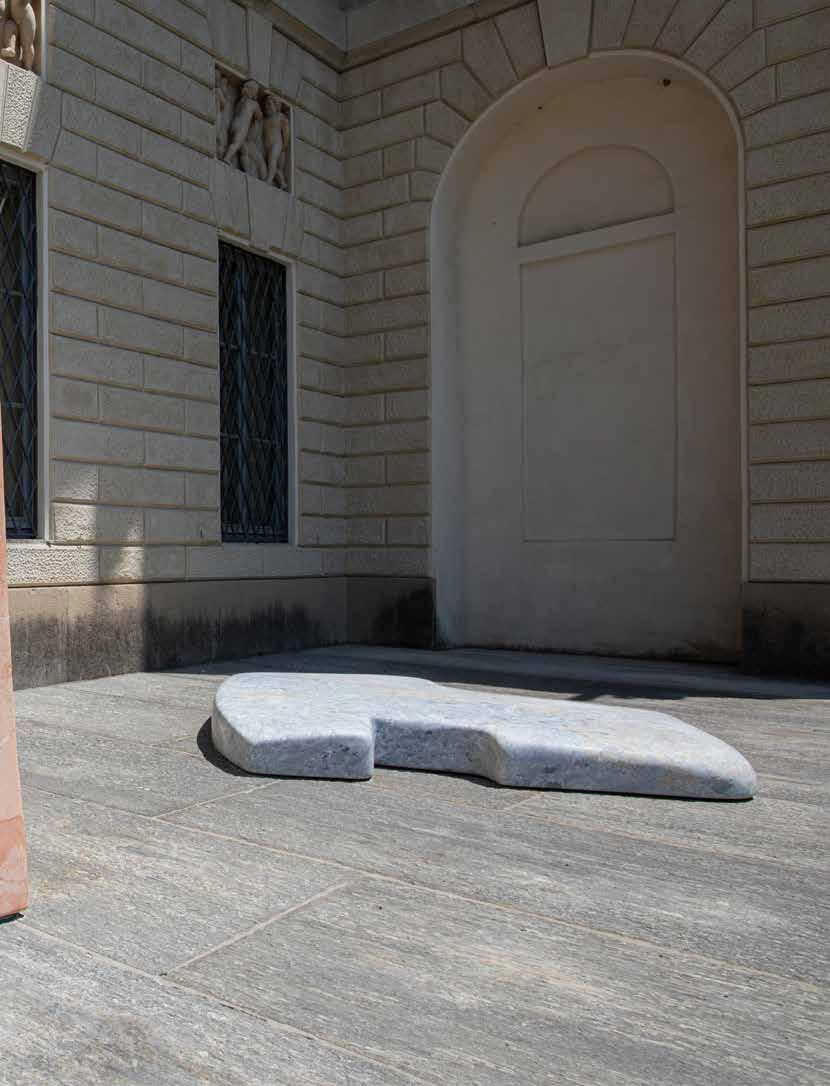
Art
Nairy Baghramian, Misfits, 2021, GAM - Galleria d’Arte Moderna, Milan, installation view
“Misfits” also coincided for the artist with the unique opportunity to approach a traditional material such as marble for the first time. Baghramian always works by relating closely to the context in which she finds herself and using a specific material does not only mean having to contend with the physical qualities that distinguish it but also with the memory, history and politics that are part of it, integral with the material itself. Making an exhibition in Italy was therefore a perfect opportunity to approach a material that belongs to our cultural heritage. Visiting the quarries of Monte Altissimo, whose marbles are famous all over the world, and coming into contact with the local workers who have a centuries-old experience on the process of extraction and processing of this material, was for Baghramian a unique and source of great inspiration and the choice to use
it for a project like “Misfits” was anything but casual. Using a noble material such as marble, which has always been a symbol of completeness and perfection, to give sculptural form to imperfection, Baghramian calls into question every pre-established idea of beauty and form, suggesting that sculpture should also have «the possibility of not satisfying expectations».
The sculptures of “Misfits”, their forms with imperfect joints are not based on pre-established and generalized aesthetic canons, they contemplate the possibility of error, inadequacy and imperfection and reveal their beauty, demonstrating how these experiences, which make part of the formation of each individual, can also have an autonomous raison d’etre as formal manifestations.
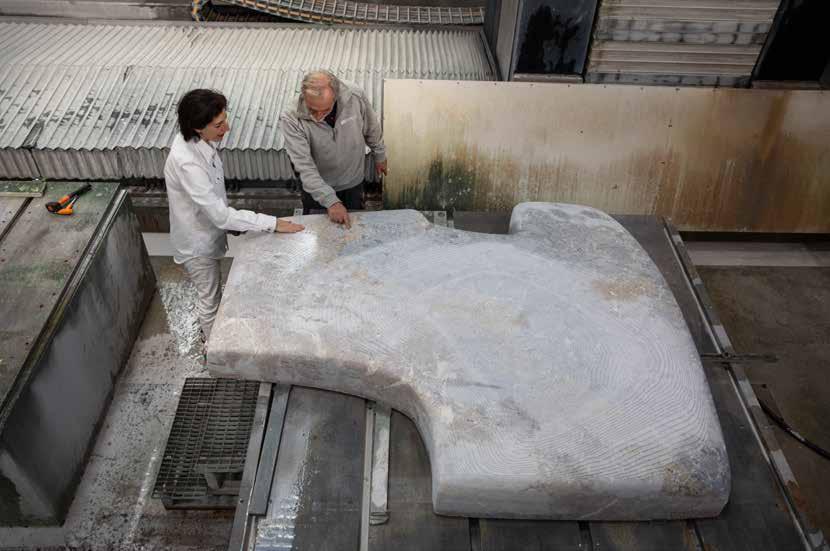
176
Art
Nairy Baghramian at work with the Henraux craftsmen
Bulletin
FAEDO AND HENRAUX: THE HISTORY OF A PARTNERSHIP
BY GIACOMO FAEDO
The opportunity to supply its products to a company that has been established in the reference market for 200 years, does not happen very often during the life of a small industrial company. If additionally, the request consisted in the almost complete replacement of its fleet, the idea would appear even more unrealistic, almost utopian. Yet, this happened in January 2020 when Henraux entrusted Faedo with the construction of two gantry cranes for the external yard of its historic Querceta site and eight internal overhead cranes for the new production area under construction. In the sixty-year history of our company, there have not been many other supply opportunities like this one, since it is not only an important sales opportunity but essentially the creation of an open-air showroom for our products. At Henraux today, the entire range of our products is visible to the eyes of all national and international visitors, as if you could easily leaf through our company brochure, but full size.
A very ambitious project by Henraux saw the replacement of the historic gantry cranes serving the storage area of the marble blocks and slabs. The challenge for our company was to design cranes capable of combining the aesthetic beauty of the machinery required by the wonderful business context in which the machines had to be installed, with the proper industrial operation of the same, whilst also being in full compliance with the
safety regulations in force in the workplace, a subject equally dear to the client. The two existing and still functioning gantry cranes represented a true case of industrial archaeology: both entered into operation in 1929, thus having totalled almost a century of activity, they represented one of the very symbols of the company and a point of reference for Querceta. Very often during the design of the two new gantry cranes, we wondered how many visitors admired these two machines that impressed the visitor not only for their age but also for their size: the first was almost 70 meters long, the second, on the other hand, was almost 50. The production cycle of the new machines lasted almost six months, prolonged by the fact that the lockdown of March-April 2020 took place right in the middle of the project, which forced us to close the production plant. The project required full attention to detail, especially in the design phase of the new cranes, concerning these two giants who have occupied the spaces of the Henraux yard for so long. In addition, our company immediately felt enthusiasm for this new project, confident of the visibility that this installation would continue the great tradition and fame of Henraux around the world.
A coincidence meant that both of our companies, Henraux and Faedo, were on the eves of important anniversaries of company life: 200 years for the first and 60 years for the second.
Our company was born in 1961, thanks
to the founder Cesare Faedo in his hometown Chiampo, in the province of Vicenza. His history, in some ways, closely resembles those best known of entrepreneurs of the modern era: he was very young, in fact, at the age of 26, after a work experience in a wellknown local engineering company, he chose to set up his own business by opening a small mechanical workshop in the basement of his house, F.O.E.M. (an acronym for Faedo Officina Elettromeccanica). In those years, Veneto, like many other regions of Italy, was experiencing the transition from a predominantly agricultural economy to an industrial economy made up of small businesses, active in what would later become specialized districts. The geographical location of Chiampo, the city where our company is still located, places it close to one of the great Italian marble districts, that of Verona, and to the smaller but then very active marble districts of Grezzana (VR) and of Chiampo. Very soon the mechanical workshop activity perfected the construction of winches and machinery for extraction, and to the complete specialization in the construction of gantry cranes for handling blocks and overhead cranes for handling slabs. The geographical scope of activity of F.O.E.M. expanded to all the marble districts of Italy, such as Tivoli, Cassino, the areas of Brescia involved in the processing of Botticino and of Carrara. At the same time, sales developed abroad, giving way to an export activity that continues today.
178 Bulletin
1

Bulletin
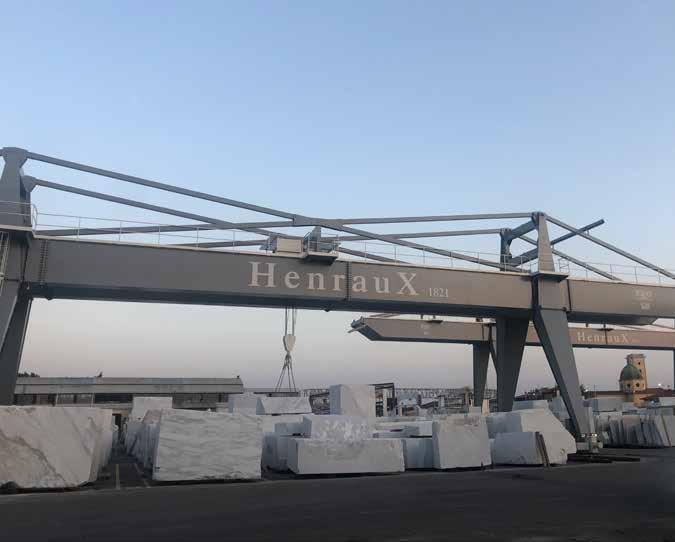

180 Bulletin
Our company’s history unites us to many small Italian family businesses, born from the stubbornness of the founders, and capable of continuity, expansion and improvement by successors who grew up in an environment where the values of entrepreneurship were an integral part of family history.
Unfortunately, in 1991 Cesare Faedo passed away at the age of 57 and the business was continued by his sons Massimo and Franca who, in 1992, founded the Officina Faedo. The most important change that took place with the advent of the second generation was the expansion of the reference product sectors, finding space in industrial sectors other than stone, in which it was necessary to utilise lifting and handling systems, such as the steel sector, mechanical, prefabricated and naval sectors. Consequent to the increase in the product sectors of interest was the increase in volumes and the workforce employed, as well as the development of an important network of services and outsourced processes that led to the transition from artisanal logic to industrialization logic.
Our company’s history unites us to many small Italian family businesses, born from the stubbornness of the founders, and capable of continuity, expansion and improvement by successors who grew up in an environment where the values of entrepreneurship were an integral part of family history. Now that our
company is experiencing the advent of the third generation, the challenges we face are many. First of all, we want to enhance the long tradition of our company, bringing out the richness of sharing the know-how. Secondly, it is our will to further expand our business by introducing industrialization and computerization logic, whilst at the same time managing to maintain our close relationship with customers, thanks to whose knowledge we can provide machinery that fully satisfies the needs of each of them.
Great efforts have been made in updating our products to incorporate the operating logic according to the digital transition in a 4.0 key, adapting the machines to any type of situation required by the specific IT needs of our customers. This is an investment that the market has recognized and from which an important business growth follows, in the wake of our tradition.
We are very grateful to Henraux for the faith it has placed in us by entrusting us with the execution of this important redevelopment project, and for having also included our company among its partnerships.
181 Bulletin
HENRAUX STARS IN A TV SERIES: BEHIND THE SCENES OF UOMINI DI PIETRA
BY ROSI FONTANA
Not even in the wildest imagination would it have been imagined that one day the excavators, women and men of Henraux would become the stars of a successful television series. But as you know, reality often exceeds fantasy, and so it happened: the “Uomini di Pietra” [Men of Stone] ente-red the national television schedules and reached the remarkable milestone of one of the most-watched TV series of autumn 2020.
With “Uomini di Pietra”, aired close to the celebration of the 200th anniversary of its history, Henraux told its story through the breathtaking views of Monte Altissimo, life in the quarries and the frenzy of work in the Querceta warehouse and factories.
Producer Ugo Pozzi told us about his project by telephone in June 2019: to film a six-part television series, one hour per episode, to be broadcast on D-Max, Discovery Italia’s satellite channel. Not a usual request, nothing that falls within the usual national
and international television or cinema parameters, in which the quarries are only protagonists as part of television reports and insights or film sets.
The history of the company, and above all of its quarries, is a long story that goes back from the present day to 1517. The company has added stories and facts in terms of excellence, production and the prestige of the clients ever since. But if five minutes of television is a very long time, six hours seemed like an eternity. What could be or should be told in all that television space, and above all, how was this enigma to be solved?
The first step of this exciting adventure was to accompany the GiUMa Produzioni troupe to the quarry and the factories, whose need was to see closely if the production reality and the men who work there could have lent themselves to the difficult task of acting like themselves and tell one of the oldest and least-known stories among the productive realities: the
history of marble and its complete supply chain. From cultivation to extraction, from processing to the finished product, from production control to shipping.
It was definitely possible, Henraux has always represented this, but the most important piece was missing: how the company could be turned into a television product for the general public.
Meanwhile, the cameras, directors and writers made their first “moon landing” at Cervaiole on a very hot day in mid-July 2019. Franco Pierotti was there to welcome us as always, and in remembering him we know he was the very first among the fans of the programme.
The amazement of those arriving in the quarry for the first time is common knowledge, the quarry landscape is truly amazing for those who have never seen it – Cervaiole in particular – and it is especially true for those who look at it through a lens, be
182 Bulletin
2

Bulletin
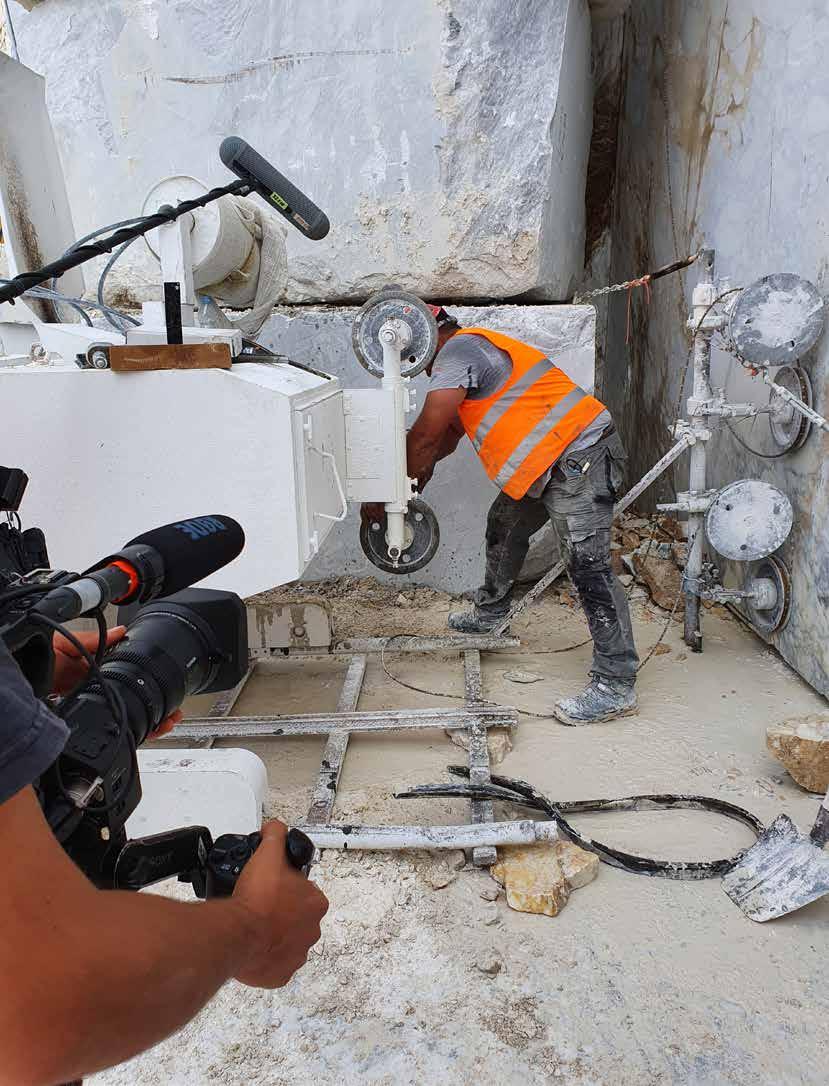
Bulletin
it photographic or cinematographic. The splendour and blinding light of the immense white space of the Russia quarry, characterized by its colossal steps where men and machines move in perfect harmony, from small gestures to thunderous events, is in itself a great stage. The key that would open the story was soon found: the wonder of marble and its men was history itself.
But to make a “show”, the cameras and the directors had to concentrate on the difficulties, problems and mistakes that are made during work. To convince us to first highlight only the critical factors in the quarry and in production, Ugo Pozzi told us that when the happy ending comes, the story ends. For this reason, the public is attracted to challenges, by the ability of men to face adversity, by their stubbornness in surmounting hard times.
Henraux is an international economic reality, used to referring to itself in terms of excellence, performance and results. GiUMa Produzioni’s request to go the other way and show the tiring and vulnerable side of this work was the real challenge in the hands of Paolo Carli, who agreed to put himself and his men to a test they had never imagined.
“Uomini di Pietra” is a tribute to a millenary art, to the territory, to men and women who do their work with pride every day in order to build beauty and to transform every stone that is laboriously brought into the world from the beating heart of the mountain into history.
In July 2020, exactly one year after the first visit, an entire troupe made up of Ugo Pozzi himself, director Mario Barbieri, writer Andrea Rizzoli and numerous cinematographers and sound technicians, was installed at the foot of Monte Altissimo to film in the quarries every day for a month.
It was a whirlwind of cameras and drones, chasing the activity of men and machines. It was a full-time job just following the events in the Russia and Catino Alto quarries, and in the more recent Platone and Buca. It was very tiring work pursuing the overturning of banks, finding the space for the “confessionals”, grasping the characters and peculiarities of the protagonists who were divided in a job that sees them both as actors and workers. And then, running from the mountain to the plains to shoot salient scenes between commissioners and project managers who equally laboriously dealt with the many needs of the customers.
It must have been both the fear and the desire to be seen, the pride of being there and the embarrassment to show oneself, the strong sense of belonging and the challenge to tell one’s story that allowed protagonists such as Mario (Massimo) Tarabella to emerge in “Uomini di Pietra”, alongside Jacopo Bertozzi, Michele Giannelli, Filippo Celentano, Luca Truffelli, President Paolo Carli and two of the company’s many women, Letizia Luporini and Barbara Farina. A few months’ silence was added to the roar of the hot summer 2020: it is the time of post-production. In October, promotional clips, which collect millions of views as well as enthusiastic comments, announce the arrival of “Uomini di Pietra” on TV, the web and social media. The first episode was shown on D-Max on the evening of November 19, 2020, at 9.25 pm.
It is night, the quarries are closed and silent in the impenetrable darkness of the mountain. The stars, like the audience, wait with bated breath in front of the TV. It’s a special moment, it’s seeing each other and seeing. It is a success that is dedicated to all those hands, which over time have touched, caressed and transformed marble into legend.
185 Bulletin
EXTRACTION ACTIVITIES AND ENVIRONMENTAL GROUPS: THE PREREQUISITES FOR A POSSIBLE DIALOGUE
Henraux is a sustainable company. It is sustainable in its broader definition, according to which a company that participates in the social and economic well-being of the territory to which it belongs is sustainable. Through its industrial and cultural activity, Henraux can affirm, without fear of contradiction, that it has contributed to the prosperity of the community and that it has been approaching it concretely for two hundred years.
Strengthened by its position, on 4 July the company wanted to be present at an event organized by Cosmave – the Consortium for the development of the marble business of Versilia – to counter the protest by environmental groups who complain about a supposed unavailability of marble industrialists to discourse on the subject of mining, which they strongly oppose.
What we want to bring to the attention of ecologists, is that dialogue, to be such, must start from an inevitable premise, free of any rhetoric and with a great sense of reality: respect for workers, who must support their families, pay their mortgages, raise and educate their children, have every insurance and be able to count on a good pension at the end of their work lives. All assets that are insured by the quarries, the supply chain and
the related industries created by the marble companies.
The quarries in the park are in fact above all a place of work and are the foundation of the supply chain that makes the local economy possible and stable.
The objective fact that environmentalists should be confronted with is that without the quarries the entire territory would fall into an irreversible economic crisis. And they should also reason on the fact that in a period such as the one we are experiencing due to the pandemic, which has created an unparalleled employment crisis. The Versilia area, instead, thanks to the sacrifices and seriousness of the marble companies, has been able to maintain jobs and wages.
In fact, the protection of work and production activity, which has been taking place in this area for centuries, is the theme to which Henraux itself turns all its attention. And, in doing so, it does not forget the environment: its mining activity is carried out in full compliance with the rules and laws in force.
«In these days we have received a lot of support for our peaceful demonstrations in defence of the work and the marble supply chain –declares the President of Henraux, Paolo Carli –. My thanks go first of all to all the workers present, both of
Henraux and of its related industries, I thank the Fillea CGIL, in particular, its Secretary Alessia Gambassi present on Sunday at the Cava Cervaiole in support of all the workers. A heartfelt thanks to Sen. Massimo Mallegni who in all these years, and today even more strongly, has placed himself in defence of the work, the territory and the marble sector, and to the Hon. Umberto Buratti who, with his presence at Cervaiole, showed his closeness to the company and to its employees. To demonstrate that the pre-eminent political personalities of the territory, with their support and their presence, have always been close and ready to intervene to safeguard the well-being of citizens and to defend jobs».
In the awareness of occupying diametrically opposed positions in the very concept of “mountain heritage” and what its protection means – on the one hand, the entrepreneurial one, which defends an economy that gives work to hundreds of families, on the other that of those who would like to reduce, if not stop, the mining activity in favour of a landscape regeneration –, Henraux does not shy away from listening and confrontation, as long as an approach to the issue is approached with concrete and not only ideological arguments.
186 Bulletin
3
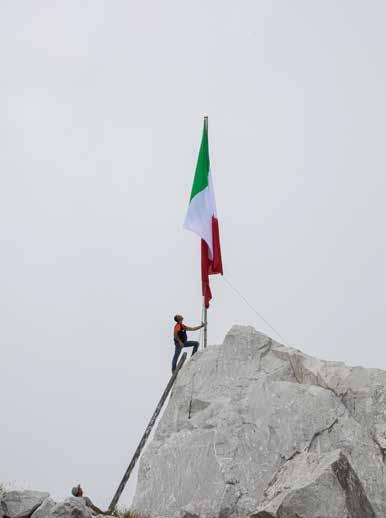

Bulletin
The demonstration on Sunday 4th July on Pizzo di Falcovaia, Cervaiole Quarry
ART IN THE AGE OF TECHNOLOGICAL INNOVATION
BY ANDREA CORRADINI
What is the relationship between art, particularly marble sculpture, and technological innovation? Very narrow, starting from the moment in which the stone must be extracted and transported, activities that have required ingenuity and skill since ancient times. But it is not only art that makes use of technology, the relationship is also inverse: the visionary ability of art is in fact equally useful for technological progress.
«If people knew how many hours I sweated to make this, they wouldn’t consider me a genius», stated Michelangelo Buonarroti.
Art and innovation are results of years of study, experience, trials, errors and attempts, they are the synthesis of all this, but also of the intellect of man who with perseverance invests and bets on his ability to create something unique, original or even eternal. We cannot think of famous marble pieces of art by Brunelleschi, Michelangelo or Canova without thinking of the hard work behind those pieces, made not only from studies and preparation but also of extraction,
transport and artistic processing of the block. We can define Leonardo as the innovator par excellence in the sciences; yet, without his research and his studies, he probably would not have achieved the innovations that we recognize from him and he would not have been Leonardo Da Vinci, the innovator.
Art and innovation have gone hand in hand throughout history because improvement is achieved through the encountering and contamination of different cultures.
When we talk about the art of marble but also simply about marble, it is natural to think of Carrara marble. We hardly think of other types because, whatever people say, the Italian tradition of marble processing as we know it begins with Michelangelo and from the quarries of Monte Altissimo near Carrara.
In sculpture, marble, alongside stone has always been the main protagonist, ever since before the Egyptians; but the art of sculpture has always been accompanied by technological innovation, as it has always had
to face the problem of extraction, transport and processing. Maybe we think about it or maybe not, maybe we take it for granted, but marble has a weight, it weighs kilograms, quintals, tons, and companies have always sought solutions that could help them optimize the different phases of processing.
The President of Henraux, Paolo Carli said in a recent interview: «Technology is decisive for the future of enterprises, it allows us to make giant steps while maintaining the identity of the artist’s manual skills and determines the competitive spurt we need to win international challenges». Understanding how to face daily challenges and establish yourself in the market is not easy and Henraux is aware of this. The fact that Henraux has chosen Donatoni as a technological partner is no coincidence but simply the encounter between art and technological innovation, between hand and machine and between two companies convinced that the only way to grow and be competitive is to continue investing in
188 Bulletin
4
technological innovation and research. Donatoni was founded in 1957, during the postwar economic boom, and the same year Erminio Cidonio took over the leadership of Henraux. It seems like the hand of fate but sometimes coincidences make us think that there really exists a grand design in which we are but only players. Although the paths of Henraux and Donatoni didn’t cross until 2019, both have always worked with a fixed compass pointing towards a single goal since 1957: continuous improvement through innovation.
When Vittorio Donatoni opened his eponymous workshop, he began by providing repair and assistance services for vehicles and machinery used in quarries and the handling of blocks and slabs; he had no idea how the company would evolve and that some of his innovations would pave the way for the future Donatoni Macchine. His great mechanical skill and ingenuity prompted him to seek solutions that were aimed not only at repairing, but also at improving the means and consequently the work of the operators in the marble sector. Vittorio moved on from improvements to the creation of patents and tools and subsequently to the sale of machinery, maintaining the company mission, which was to provide assistance and repair services.
In 43 years, from 1957 to 2000, Vittorio subsequently joined by his son Giorgio, continued to repair and improve the vehicles and machinery of their customers, observing, listening to their needs, learning and understanding what worked and what did not, that is to say, what needed to be repaired and what needed to be improved or changed. From the experience of these two people, Donatoni Macchine was created in 2008 and it is a company that has made innovation its driving force. One of the determining factors of Donatoni’s success has always been the solidity, quality and care with which its bridge saws and universal machining centres are made and is recognized by the customers themselves. Know-how comes from the experience gained over years of assistance that has allowed us to understand the strengths and weaknesses of the machines on the
market. If we combine intuition and ingenuity, we can have patents and solutions with high performance and long life. We can define Donatoni Macchine as a company that was born from the bottom up, for which the customer’s needs represent a challenge and an opportunity for continuous growth.
The meeting between Henraux and Donatoni is a direct consequence of the continuous research and development work that Donatoni has adopted for years for the design of its machines. Giorgio Donatoni, who we can define as the technological mind of the company, has always drawn inspiration from the daily needs and problems of customers for the development of new machines and the technologies applied to them. This great listening ability allowed Donatoni to meet with Henraux. Paolo Carli said he approached Donatoni because he was attracted not only by the quality of the machines but also by the engineering, the mind from which these solutions are born.
Today Donatoni represents the technological partner for Henraux to improve production and develop new solutions that help overcome production gaps while keeping automation at the service of man and manual skills. The Henraux Foundation represents the research and development department of the Henraux company in a certain way; through the development of relationships with international artists, architects and designers it is possible to advance art and this pushes the company to search for ever-newer technologies capable of driving transformation.
To confirm what has already been said, we must mention the collaboration between Henraux and Donatoni in the development and construction of a new and unique machine, never used in the stone market before: the KSD-1 (now DONATONI KROSS). The need to further automate the production process in the production of marble and stone claddings and panels for large architectural projects has led to the development of the KSD-1 machine, a machine aimed at creating fixing systems for wall panels and slabs and internal and external curtain walls. The interesting aspect of this machine lies not only in its uniqueness but in the approach used to make it:
Henraux was directly involved in the design, becoming an integral part of its development process. Henraux’s experience in the implementation of important architectural projects has allowed the development of this solution to be conveyed to Donatoni’s designers, namely the difficulties in creating cladding and panels for curtain walls.
In Donatoni today, research is not just for mechanical development; it has gone further by exploring new territories from which to draw inspiration. Software development is a strength for the company today but it is also a starting point. Digitization is a process that is slowly involving all of the industrial sectors and the marble and stone sector is no exception. Creating interconnected, remotely controlled and automated machines is no longer a utopian dream but is the norm. The advantages for enterprises are many and translate very simply into solutions that help the operator work better and the company to produce more and with higher quality by having complete control of the entire production process. Having an internal software office made up of high-level qualified personnel is a strategic choice that allows Donatoni to be one of the few companies able to quickly meet the needs of its customers with a unique ability to adapt and react in the sector, allowing the perfect integration of the machine with the software.
Another area in which Donatoni has taken root is in robotics. For some years now, the company has started producing robotic systems for the processing and finishing of marble and stone, going against the traditional universal machining centres that have made it famous from the very beginning. The choice to use robots for this type of use arose from the need to provide very flexible solutions to customers who have a strong contract and design production component.
The term “Robot” does not only refer to solutions for processing but also automation. For Donatoni, automation is an engine for competitiveness and a technological choice that allows companies to obtain numerous advantages in terms of time, safety and control. Through automation
189 Bulletin
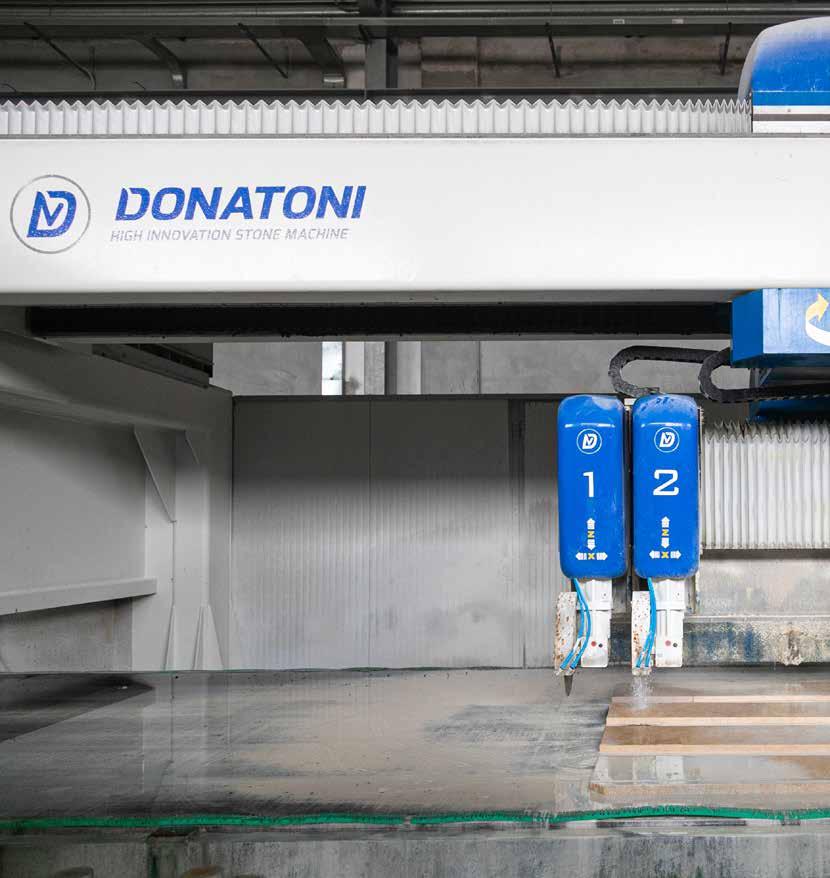
Bulletin
technologies, it is possible to create production lines, reduce manpower and optimize production, program orders and guarantee deliveries, monitor production phases and control management costs.

If we study them too closely, innovation and technology sometimes seem things disconnected from man, distant and sometimes foreign; but if we want that in art, sculpture and beyond, and generally in the processing of marble and stone, the value of what is produced does not pass only through automatisms, we must ensure that manual skills and artistic genius remain the main components of value that the customer recognises and buys, and the machine is at their service. This is why the partnership between Donatoni and Henraux makes sense to exist. Their paths crossed at the right time, when one needed the other when innovation needed art to progress and the art needed innovation to improve, i.e. innovation at the service of the hand of “artist”.
Leonardo da Vinci stated that «knowing how to listen means possessing the brains of others, in addition to one’s own». Donatoni was born from the customer’s needs, from providing assistance: it is a company that listens and learns from companies like Henraux and today more than ever needs to listen to be able to project itself into the future.
191 Bulletin
All rights reserved. No part of this publication may be reproduced or transmitted in any form or by any means, without the publisher’s permission. Every effort has been spent to track down the rights holders of the images and / or sources mentioned. The publisher remains available to any entitled parties who it was not possible to trace.
Graphic design and layout
Thetis Srl
Via Oliveti 110 • 54100 Massa
Finished printing in March 2022, Genova
ISBN9788894350241




 BY EDOARDO BONASPETTI PHOTOS BY NICOLA GNESI
BY EDOARDO BONASPETTI PHOTOS BY NICOLA GNESI









































 Panorama of Monte Altissimo from Cappella
Panorama of Monte Altissimo from Cappella

















































 BY PICKARD CHILTON
BY PICKARD CHILTON




 BY COSTANTINO PAOLICCHI PHOTOS BY GIOVANNI UMICINI
BY COSTANTINO PAOLICCHI PHOTOS BY GIOVANNI UMICINI











 BY ALDO COLONETTI
BY ALDO COLONETTI






























